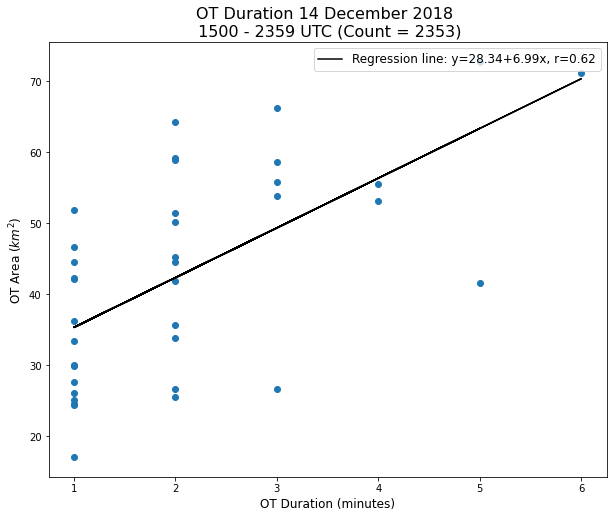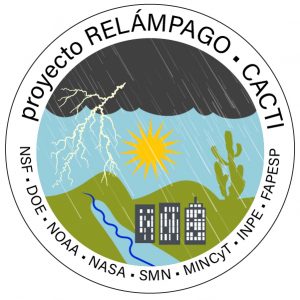Track OTs
Contents
Track OTs¶
%pylab inline
import pandas as pd
import glob
import os
import numpy as np
import pandas as pd
import trackpy as tp
from copy import deepcopy
import pyproj
import xarray as xr
import cartopy.crs as ccrs
dem_files = sorted(glob.glob('/data/accp/a/snesbitt/relampago/srtm/*.tif'))
ds_list = []
for file in dem_files:
ds_list.append(xr.open_rasterio(file).isel(band=0))
import scipy
from shapely import wkt
import geopandas as gpd
ota_bins = np.arange(0, 225, 25)
otd_bins = np.arange(0, 4, .2)
dur_bins = np.arange(3, 16, 1)
Populating the interactive namespace from numpy and matplotlib
10 November Case¶
df = pd.concat([pd.read_csv(f) for f in sorted(glob.glob('ot_output/20181110/20181110*'))], ignore_index = True).drop(columns='Unnamed: 0')
df['geometry'] = df['geometry'].apply(wkt.loads)
geo_df = gpd.GeoDataFrame(df, geometry='geometry')
df = geo_df
df['ot_depth'] = df['cloudtop_height'] - df['tropopause_height']
df['diff'] = pd.to_datetime(df['time']) - pd.datetime(2018,11,1)
df['frame'] = df['diff'].dt.days*86400+df['diff'].dt.seconds
df['frame'] = df['frame'] - df['frame'].min()
/data/keeling/a/mgrover4/a/miniconda3/envs/xesmf_env/lib/python3.7/site-packages/ipykernel_launcher.py:1: FutureWarning: The pandas.datetime class is deprecated and will be removed from pandas in a future version. Import from datetime module instead.
"""Entry point for launching an IPython kernel.
df['time'] = pd.to_datetime(df.time)
df['hour'] = df.time.dt.hour
df['minute'] = df.time.dt.minute
df = df[df.prob > .8]
good_ind = df['lat'].apply(lambda x: pd.to_numeric(x, errors='coerce')).index
df = df[df.index == good_ind]
df_track = deepcopy(df)
#df_track.rename(columns={'lon':'x', 'lat':'y'}, inplace=True)
#df_track['z'] = 0
df_track['states'] = 0
df_track['label'] = 0
radius=6371228.
globe = ccrs.Globe(ellipse=None, semimajor_axis=radius,
semiminor_axis=radius)
projection=ccrs.LambertAzimuthalEqualArea(central_latitude=-32.,
central_longitude=-62.,globe=globe)
prj=pyproj.Proj(projection.proj4_init)
df_track['x'], df_track['y'] = prj(df_track['lon'].values, df_track['lat'].values)
df_track.to_csv('test.csv')
v_max=60.
stubs=2
order=1
extrapolate=1
memory=1
adaptive_stop=0.01
adaptive_step=0.99
subnetwork_size=100
method_linking= 'predict'
cell_number_start=1
dt = 60.
dxy = 2000.
search_range=dt*v_max
features_linking=deepcopy(df_track)
pred = tp.predict.NearestVelocityPredict(span=1)
trajectories_unfiltered = pred.link_df(features_linking, search_range=search_range, memory=memory,
pos_columns=['x','y'],
t_column='frame',
neighbor_strategy='KDTree', link_strategy='auto',
adaptive_step=adaptive_step,adaptive_stop=adaptive_stop
# copy_features=False, diagnostics=False,
# hash_size=None, box_size=None, verify_integrity=True,
# retain_index=False
)
trajectories_unfiltered['cell']=None
for i_particle,particle in enumerate(pd.Series.unique(trajectories_unfiltered['particle'])):
cell=int(i_particle+cell_number_start)
trajectories_unfiltered.loc[trajectories_unfiltered['particle']==particle,'cell']=cell
trajectories_unfiltered.drop(columns=['particle'],inplace=True)
trajectories_bycell=trajectories_unfiltered.groupby('cell')
num_stubs = 0
for cell,trajectories_cell in trajectories_bycell:
# logging.debug("cell: "+str(cell))
# logging.debug("feature: "+str(trajectories_cell['feature'].values))
# logging.debug("trajectories_cell.shape[0]: "+ str(trajectories_cell.shape[0]))
if trajectories_cell.shape[0] < stubs:
# print("cell" + str(cell)+ " is a stub ("+str(trajectories_cell.shape[0])+ "), setting cell number to Nan..")
trajectories_unfiltered.loc[trajectories_unfiltered['cell']==cell,'cell']=np.nan
num_stubs = num_stubs + 1
print('found this many stubs: {}'.format(num_stubs))
Frame 27841: 5 trajectories present.
found this many stubs: 116
trajectories_filtered=trajectories_unfiltered.dropna(subset=['area_polygon', 'ot_depth'])
cells_grouped = trajectories_filtered.groupby('cell')
trajectories_filtered.time = pd.to_datetime(trajectories_filtered.time)
supercell = trajectories_filtered[trajectories_filtered.cell == 93]
supercell.centroid.plot()
<AxesSubplot:>

ota = supercell.area_polygon.values
mintb = supercell.mintb.values
hgt = supercell.ot_depth.values
times = pd.to_datetime(supercell.time)
plt.plot(times, mintb)
[<matplotlib.lines.Line2D at 0x2b96c764bc88>]
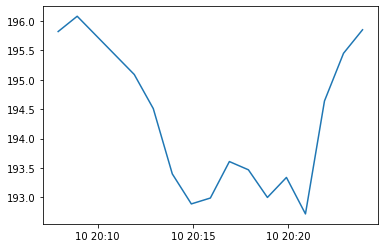
plt.plot(times, np.gradient(hgt)*16.6667)
---------------------------------------------------------------------------
NameError Traceback (most recent call last)
<ipython-input-114-c1215faefe8c> in <module>
----> 1 plt.plot(times, np.gradient(hgt)*16.6667)
NameError: name 'times' is not defined
plt.figure(figsize=(12, 8))
ax = plt.subplot(311)
ax.plot(times, ota, color='black')
plt.ylabel('OTA (km2)')
ax = plt.subplot(312)
ax.plot(times, mintb, color='tab:blue')
plt.ylabel('Min Tb (K)')
ax = plt.subplot(313)
ax.plot(times, hgt, color='tab:red')
plt.ylabel('OT Depth \n (km)')
plt.suptitle('OT Time Series Cell 93', fontsize=24)
plt.savefig('cell93_timeseries.png', dpi=300)
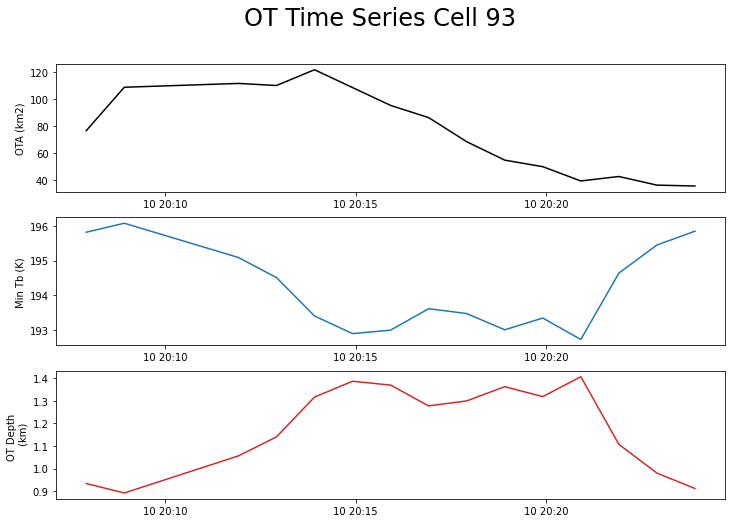
duration = cells_grouped.count().area_polygon.values
max_depth = cells_grouped.max().ot_depth.values
mean_depth = cells_grouped.mean().ot_depth.values
max_otarea = cells_grouped.max().area_polygon.values
mean_otarea = cells_grouped.mean().area_polygon.values
df_max = cells_grouped.max()
df_max['duration']= cells_grouped.count().area_polygon
#cells_grouped.count().area_polygon
df_max[df_max.duration >2].duration.plot.hist()
<AxesSubplot:ylabel='Frequency'>
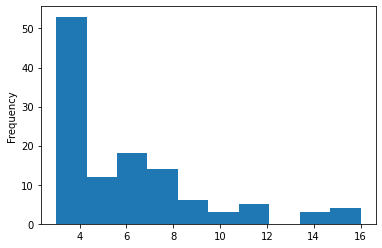
def plot_regression(x, y, xlabel='OT Duration (minutes)', ylabel='OT Area ($km^{2}$)', plot_label = 'OT Duration 10 November 2018 \n 1500 - 2359 UTC (Count = 179)'):
slope, intercept, r, p, stderr = scipy.stats.linregress(x, y)
line = f'Regression line: y={intercept:.2f}+{slope:.2f}x, r={r:.2f}'
plt.figure(figsize=(10,8))
ax = plt.subplot(111)
ax.scatter(x, y)
ax.plot(np.array(x), intercept + slope * np.array(x), label=line, color='black')
plt.ylabel(ylabel, fontsize=12)
plt.xlabel(xlabel, fontsize=12)
plt.legend(loc='upper right', fontsize=12)
plt.title(plot_label, fontsize=16)
ota_bins = np.arange(0, 225, 25)
otd_bins = np.arange(0, 4, .2)
dur_bins = np.arange(3, 16, 1)
fig = plt.figure(figsize=(12,8))
plt.hist(df_max.area_polygon, bins=ota_bins)
plt.title('OTA Distribution \n 10 November 2018 1500 - 0000 UTC', fontsize=24)
plt.xlabel('OTA ($km^2$)', fontsize=16)
plt.ylabel('Frequency', fontsize=16)
Text(0, 0.5, 'Frequency')
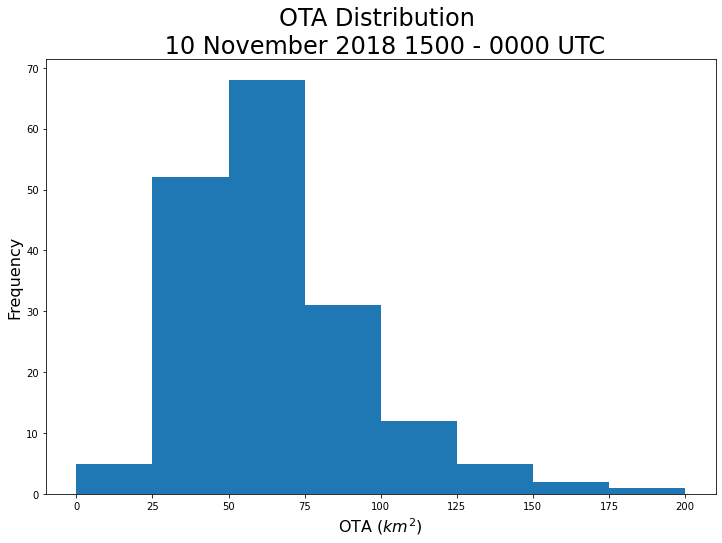
fig = plt.figure(figsize=(12,8))
plt.hist(df_max.ot_depth, bins=otd_bins)
plt.title('OT Depth Distribution \n 10 November 2018 1500 - 0000 UTC', fontsize=24)
plt.xlabel('OT Depth (km)', fontsize=16)
plt.ylabel('Frequency', fontsize=16)
Text(0, 0.5, 'Frequency')
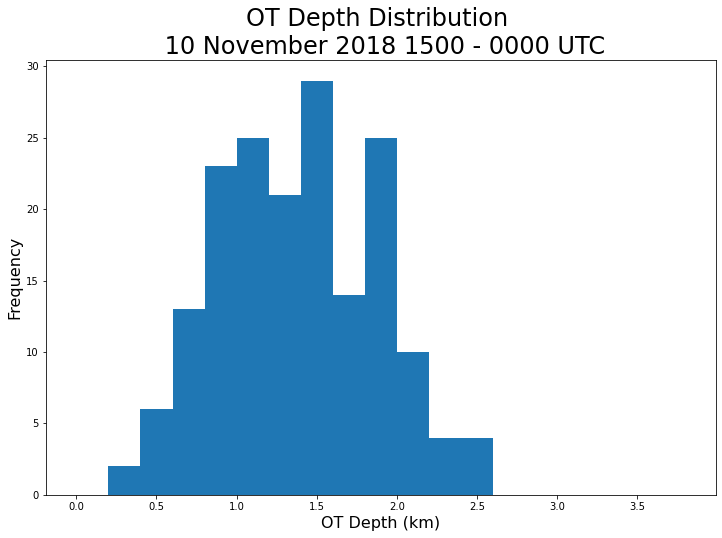
fig = plt.figure(figsize=(12,8))
plt.hist(df_max.duration, bins=dur_bins)
plt.title('OT Duration Distribution \n 10 November 2018 1500 - 0000 UTC', fontsize=24)
plt.xlabel('OT Duration (minutes)', fontsize=16)
plt.ylabel('Frequency', fontsize=16)
Text(0, 0.5, 'Frequency')
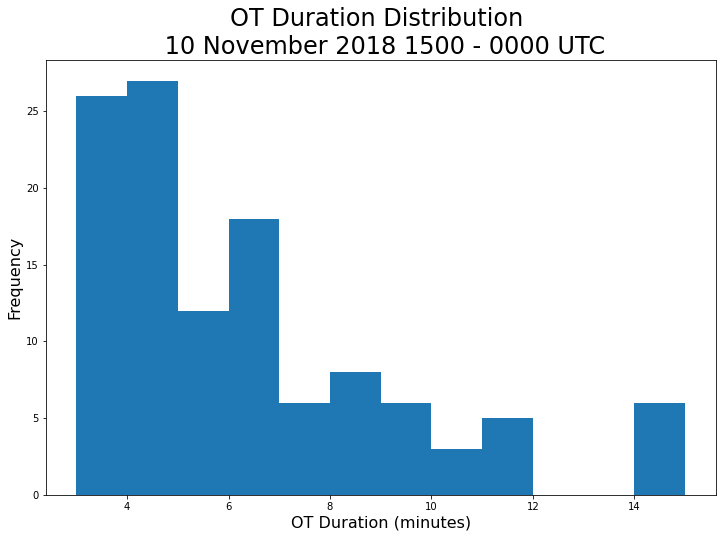
plot_regression(df_max.duration, df_max.area_polygon)
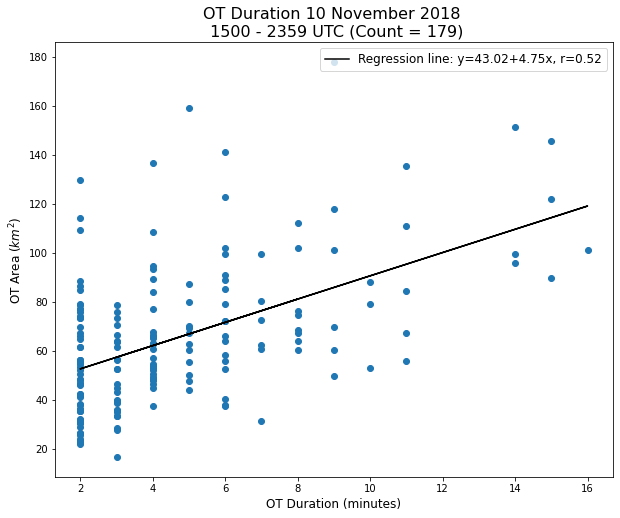
slope, intercept, r, p, stderr = scipy.stats.linregress(duration, max_otarea)
line = f'Regression line: y={intercept:.2f}+{slope:.2f}x, r={r:.2f}'
line
'Regression line: y=43.19+4.73x, r=0.52'
slope, intercept, r, p, stderr = scipy.stats.linregress(duration, mean_otarea)
r
0.35167524403770134
len(duration)
177
plt.figure(figsize=(10,8))
ax = plt.subplot(111)
ax.scatter(duration, max_otarea)
ax.plot(np.array(duration), intercept + slope * np.array(duration), label=line, color='black')
plt.ylabel('OT Area ($km^{2}$)', fontsize=12)
plt.xlabel('OT Duration (minutes)', fontsize=12)
plt.legend(loc='upper right', fontsize=12)
plt.title('OT Duration 10 November 2018 \n 1500 - 2359 UTC (Count = 179)', fontsize=16)
Text(0.5, 1.0, 'OT Duration 10 November 2018 \n 1500 - 2359 UTC (Count = 179)')
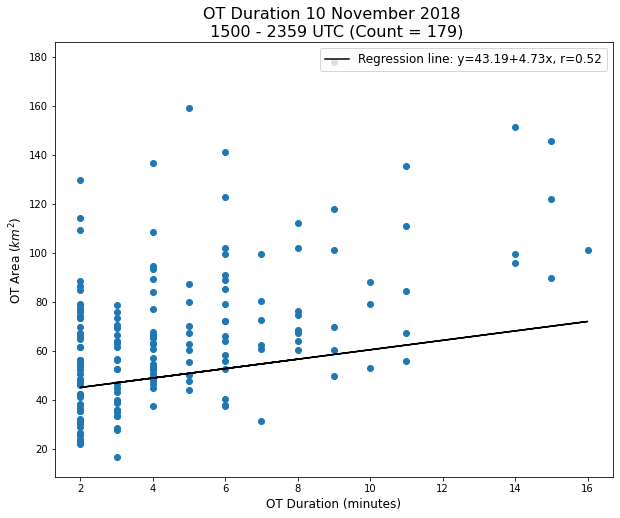
plot_regression(max_otarea, max_depth, xlabel='Peak OTA', ylabel='OT Depth')
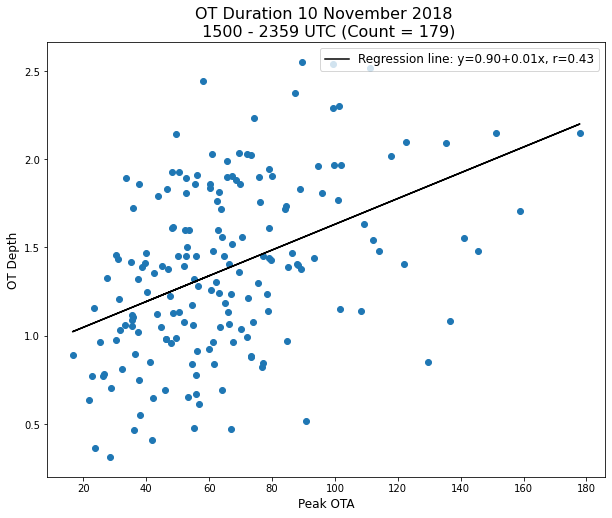
import seaborn as sns
sns.set()
plt.hist(max_depth)
(array([ 7., 10., 25., 27., 30., 26., 19., 22., 6., 5.]),
array([0.31200027, 0.5361002 , 0.76020012, 0.98430004, 1.20839996,
1.43249989, 1.65659981, 1.88069973, 2.10479965, 2.32889957,
2.5529995 ]),
<BarContainer object of 10 artists>)
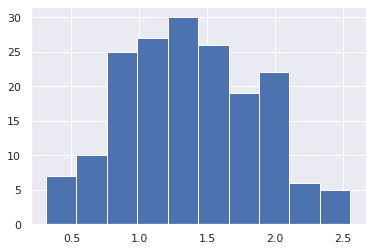
llcrnr=[-32.2, -64.5]
urcrnr=[-31.8, -63.]
# Set extent of maps created in the following cells:
axis_extent=[llcrnr[1],urcrnr[1],llcrnr[0],urcrnr[0]]
# Plot map with all individual tracks:
import cartopy.crs as ccrs
fig_map,ax_map=plt.subplots(figsize=(15,15),subplot_kw={'projection': ccrs.PlateCarree()})
ax_map.coastlines()
ax_map.set_extent(axis_extent)
for ds in ds_list:
# cm = ax.contourf(ds.x.values[::5], ds.y.values[::5], ds.values[::5,::5], levs, cmap='terrain', transform=ccrs.PlateCarree())
cm = ax_map.imshow(ds.values, extent =[ds.x.min(),ds.x.max(),ds.y.min(),ds.y.max()], transform=ccrs.PlateCarree(), vmin=0, vmax=4000, cmap='terrain')
gl = ax_map.gridlines(crs=ccrs.PlateCarree(), draw_labels=True,
linewidth=2, color='gray', alpha=0.5, linestyle='--')
gl.top_labels = False
gl.left_labels= True
gl.right_labels = False
gl.xlabel_style = {'size': 16, 'color': 'k'}
gl.ylabel_style = {'size': 16, 'color': 'k'}
for name, group in cells_grouped:
# print(group.x,group.y)
plt.plot(group.lon,group.lat,"-o",markersize=1, linewidth=3)
cb = plt.colorbar(cm,label='Elevation (m)',shrink=0.75, pad=0.1)
cb.ax.tick_params(labelsize=16)
cb.set_label('Elevation (m)', fontsize=16)
ax_map.set_title('Overshooting top tracks\n10 November 2018', fontsize=24)
plt.savefig('ot_10_nov.png', dpi=300)
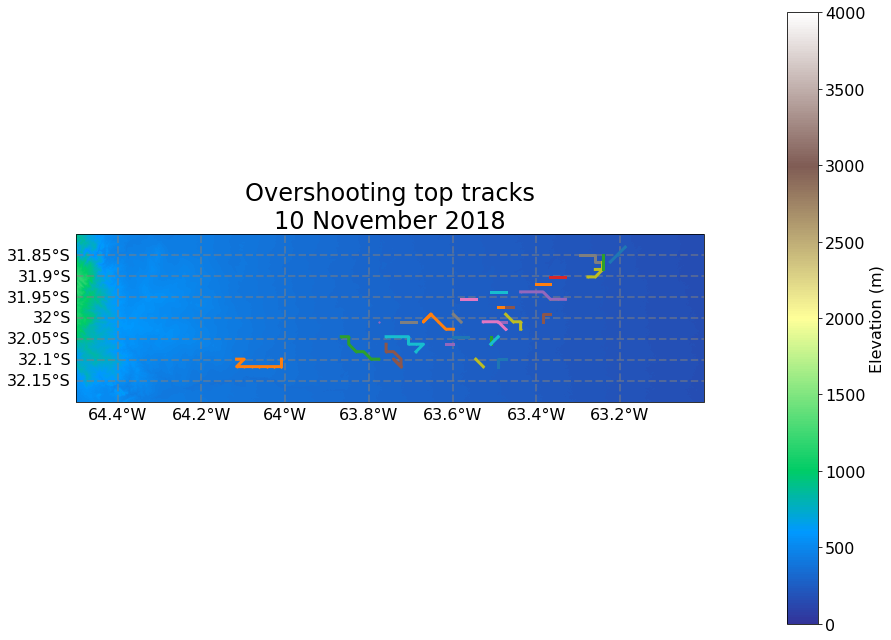
llcrnr=[-33.206342, -65.906586]
urcrnr=[-30.255825, -62.630553]
# Set extent of maps created in the following cells:
axis_extent=[llcrnr[1],urcrnr[1],llcrnr[0],urcrnr[0]]
# Plot map with all individual tracks:
import cartopy.crs as ccrs
fig_map,ax_map=plt.subplots(figsize=(15,15),subplot_kw={'projection': ccrs.PlateCarree()})
ax_map.coastlines()
ax_map.set_extent(axis_extent)
for ds in ds_list:
# cm = ax.contourf(ds.x.values[::5], ds.y.values[::5], ds.values[::5,::5], levs, cmap='terrain', transform=ccrs.PlateCarree())
cm = ax_map.imshow(ds.values, extent =[ds.x.min(),ds.x.max(),ds.y.min(),ds.y.max()], transform=ccrs.PlateCarree(), vmin=0, vmax=4000, cmap='terrain')
gl = ax_map.gridlines(crs=ccrs.PlateCarree(), draw_labels=True,
linewidth=2, color='gray', alpha=0.5, linestyle='--')
for name, group in cells_grouped:
# print(group.x,group.y)
plt.plot(group.lon,group.lat,"-o",markersize=1)
plt.colorbar(cm,label='Elevation (m)',shrink=0.6, pad=0.1)
ax_map.set_title('Overshooting top tracks\n10 November 2018')
Text(0.5, 1.0, 'Overshooting top tracks\n10 November 2018')
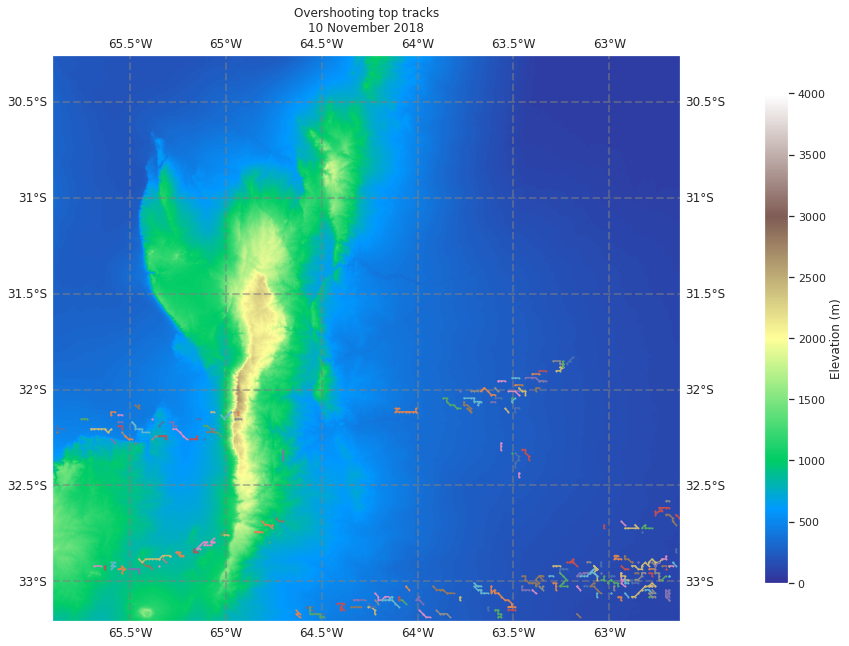
llcrnr=[-33.206342, -65.906586]
urcrnr=[-30.255825, -62.630553]
# Set extent of maps created in the following cells:
axis_extent=[llcrnr[1],urcrnr[1],llcrnr[0],urcrnr[0]]
# Plot map with all individual tracks:
import cartopy.crs as ccrs
fig_map,ax_map=plt.subplots(figsize=(15,15),subplot_kw={'projection': ccrs.PlateCarree()})
ax_map.coastlines()
ax_map.set_extent(axis_extent)
for ds in ds_list:
# cm = ax.contourf(ds.x.values[::5], ds.y.values[::5], ds.values[::5,::5], levs, cmap='terrain', transform=ccrs.PlateCarree())
cm = ax_map.imshow(ds.values, extent =[ds.x.min(),ds.x.max(),ds.y.min(),ds.y.max()], transform=ccrs.PlateCarree(), vmin=0, vmax=4000, cmap='terrain')
gl = ax_map.gridlines(crs=ccrs.PlateCarree(), draw_labels=True,
linewidth=2, color='gray', alpha=0.5, linestyle='--')
for name, group in cells_grouped:
# print(group.x,group.y)
cm2 = plt.scatter(group.lon,group.lat,c=group.area_polygon,vmin=0.,vmax=200.,s=group.area_polygon,
facecolors='none',cmap='magma',linewidth=0.5)
plt.colorbar(cm,label='Elevation (m)',shrink=0.4, pad=0.0)
plt.colorbar(cm2,label='OT Area (km$^2$)',shrink=0.4, pad=0.1)
ax_map.set_title('Overshooting top tracks\n10 November 2018')
Text(0.5, 1.0, 'Overshooting top tracks\n10 November 2018')
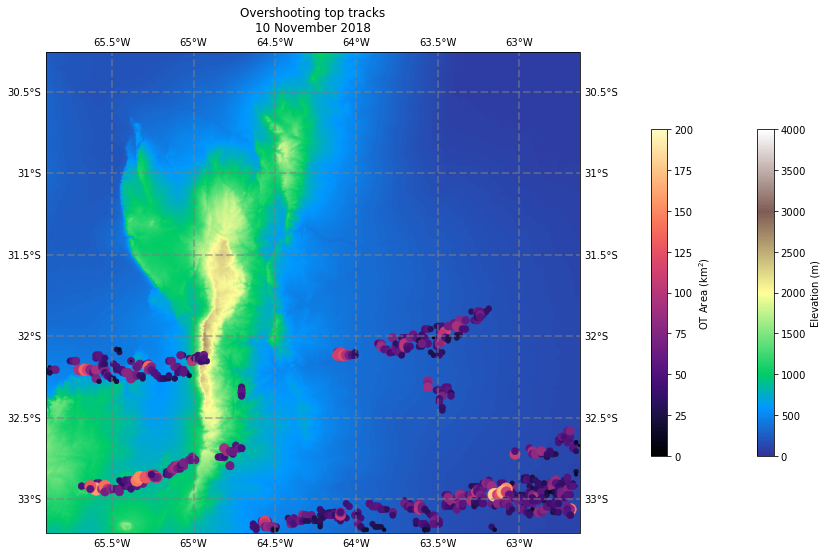
12 November Case¶
df = pd.concat([pd.read_csv(f) for f in sorted(glob.glob('ot_output/20181112/20181112*'))], ignore_index = True).drop(columns='Unnamed: 0')
df['geometry'] = df['geometry'].apply(wkt.loads)
geo_df = gpd.GeoDataFrame(df, geometry='geometry')
df = geo_df
df['diff'] = pd.to_datetime(df['time']) - pd.datetime(2018,11,1)
df['frame'] = df['diff'].dt.days*86400+df['diff'].dt.seconds
df['frame'] = df['frame'] - df['frame'].min()
df['ot_depth'] = df['cloudtop_height'] - df['tropopause_height']
df = df[df.ot_depth > 0]
/data/keeling/a/mgrover4/a/miniconda3/envs/xesmf_env/lib/python3.7/site-packages/ipykernel_launcher.py:6: FutureWarning: The pandas.datetime class is deprecated and will be removed from pandas in a future version. Import from datetime module instead.
df = df[df.prob > .7]
df_track = deepcopy(df)
#df_track.rename(columns={'lon':'x', 'lat':'y'}, inplace=True)
#df_track['z'] = 0
df_track['states'] = 0
df_track['label'] = 0
radius=6371228.
globe = ccrs.Globe(ellipse=None, semimajor_axis=radius,
semiminor_axis=radius)
projection=ccrs.LambertAzimuthalEqualArea(central_latitude=-32.,
central_longitude=-62.,globe=globe)
prj=pyproj.Proj(projection.proj4_init)
df_track['x'], df_track['y'] = prj(df_track['lon'].values, df_track['lat'].values)
df_track.to_csv('test.csv')
v_max=60.
stubs=2
order=1
extrapolate=1
memory=1
adaptive_stop=0.01
adaptive_step=0.99
subnetwork_size=100
method_linking= 'predict'
cell_number_start=1
dt = 60.
dxy = 2000.
search_range=dt*v_max
features_linking=deepcopy(df_track)
pred = tp.predict.NearestVelocityPredict(span=1)
trajectories_unfiltered = pred.link_df(features_linking, search_range=search_range, memory=memory,
pos_columns=['x','y'],
t_column='frame',
neighbor_strategy='KDTree', link_strategy='auto',
adaptive_step=adaptive_step,adaptive_stop=adaptive_stop
# copy_features=False, diagnostics=False,
# hash_size=None, box_size=None, verify_integrity=True,
# retain_index=False
)
trajectories_unfiltered['cell']=None
for i_particle,particle in enumerate(pd.Series.unique(trajectories_unfiltered['particle'])):
cell=int(i_particle+cell_number_start)
trajectories_unfiltered.loc[trajectories_unfiltered['particle']==particle,'cell']=cell
trajectories_unfiltered.drop(columns=['particle'],inplace=True)
trajectories_bycell=trajectories_unfiltered.groupby('cell')
num_stubs = 0
for cell,trajectories_cell in trajectories_bycell:
# logging.debug("cell: "+str(cell))
# logging.debug("feature: "+str(trajectories_cell['feature'].values))
# logging.debug("trajectories_cell.shape[0]: "+ str(trajectories_cell.shape[0]))
if trajectories_cell.shape[0] < stubs:
# print("cell" + str(cell)+ " is a stub ("+str(trajectories_cell.shape[0])+ "), setting cell number to Nan..")
trajectories_unfiltered.loc[trajectories_unfiltered['cell']==cell,'cell']=np.nan
num_stubs = num_stubs + 1
print('found this many stubs: {}'.format(num_stubs))
trajectories_filtered=trajectories_unfiltered.dropna()
Frame 15720: 1 trajectories present.
found this many stubs: 142
len(trajectories_filtered)
346
cells_grouped = trajectories_filtered.groupby('cell')
df_max = cells_grouped.max()
df_max['duration']= cells_grouped.count().area_polygon
df_max = df_max[df_max.duration > 2]
duration = cells_grouped.count().area_polygon.values
max_depth = cells_grouped.max().ot_depth.values
mean_depth = cells_grouped.mean().ot_depth.values
max_otarea = cells_grouped.max().area_polygon.values
mean_otarea = cells_grouped.mean().area_polygon.values
slope, intercept, r, p, stderr = scipy.stats.linregress(df_max.duration, df_max.area_polygon)
line = f'Regression line: y={intercept:.2f}+{slope:.2f}x, r={r:.2f}'
plt.figure(figsize=(10,8))
ax = plt.subplot(111)
ax.scatter(duration, max_otarea)
ax.plot(np.array(duration), intercept + slope * np.array(duration), label=line, color='black')
plt.ylabel('OT Area ($km^{2}$)', fontsize=12)
plt.xlabel('OT Duration (minutes)', fontsize=12)
plt.legend(loc='upper right', fontsize=12)
plt.title('OT Duration 12 November 2018 \n 0000 - 0600 UTC (Count = 563)', fontsize=16)
Text(0.5, 1.0, 'OT Duration 12 November 2018 \n 0000 - 0600 UTC (Count = 563)')
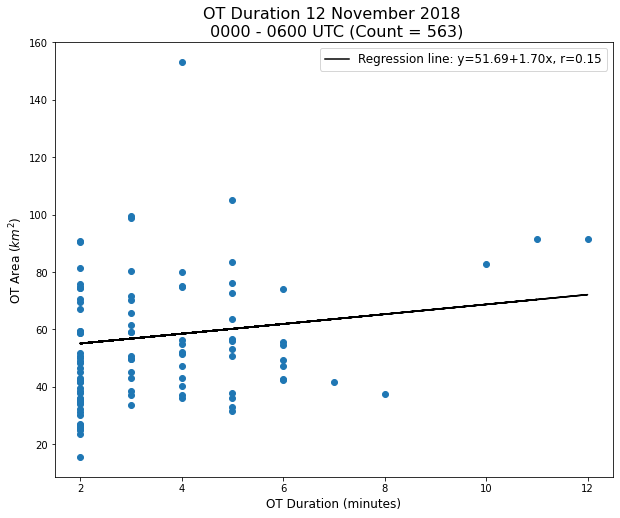
fig = plt.figure(figsize=(12,8))
plt.hist(df_max.area_polygon, bins=ota_bins)
plt.title('OTA Distribution \n 12 November 2018 0130 - 0553 UTC', fontsize=24)
plt.xlabel('OTA ($km^2$)', fontsize=16)
plt.ylabel('Frequency', fontsize=16)
Text(0, 0.5, 'Frequency')

fig = plt.figure(figsize=(12,8))
plt.hist(df_max.ot_depth, bins=otd_bins)
plt.title('OT Depth Distribution \n 12 November 2018 0130 - 0553 UTC', fontsize=24)
plt.xlabel('OT Depth (km)', fontsize=16)
plt.ylabel('Frequency', fontsize=16)
Text(0, 0.5, 'Frequency')
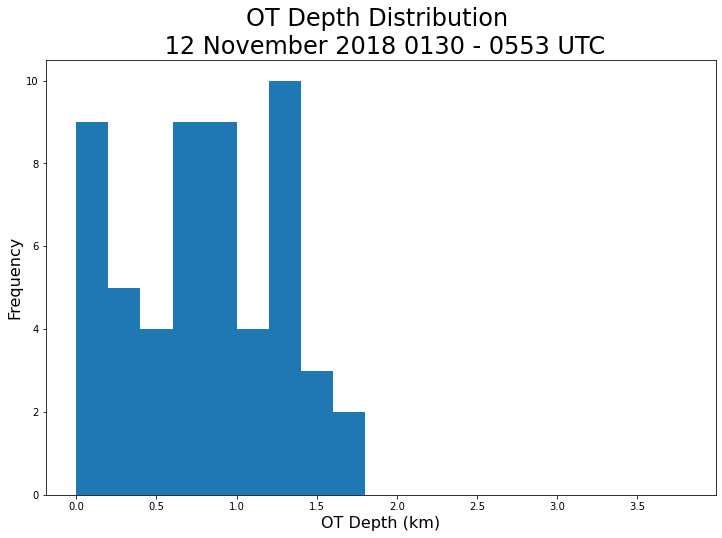
fig = plt.figure(figsize=(12,8))
plt.hist(df_max.duration, bins=dur_bins)
plt.title('OT Duration Distribution \n 12 November 2018 0130 - 0553 UTC', fontsize=24)
plt.xlabel('OT Duration (minutes)', fontsize=16)
plt.ylabel('Frequency', fontsize=16)
Text(0, 0.5, 'Frequency')
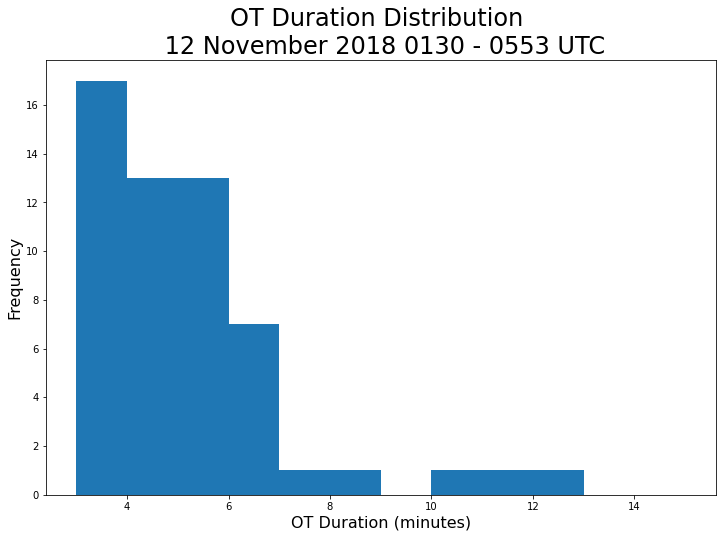
df_track['Time'] = pd.to_datetime(df_track.time)
from datetime import datetime
df = df_track[(df_track['Time'] > datetime(2018, 11, 12, 2, 30))][(df_track.Time < datetime(2018, 11, 12, 2, 34))]
/data/keeling/a/mgrover4/a/miniconda3/envs/xesmf_env/lib/python3.7/site-packages/geopandas/geodataframe.py:546: UserWarning: Boolean Series key will be reindexed to match DataFrame index.
result = super(GeoDataFrame, self).__getitem__(key)
df.columns
Index(['area_polygon', 'cloudtop_height', 'e_radial', 'e_radial_del2', 'e_tb',
'geometry', 'lat', 'lat_corr', 'lon', 'lon_corr', 'mintb', 'n_radial',
'n_radial_del2', 'n_tb', 'ne_radial', 'ne_radial_del2', 'ne_tb',
'nw_radial', 'nw_radial_del2', 'nw_tb', 'otid', 'prob', 's_radial',
's_radial_del2', 's_tb', 'se_radial', 'se_radial_del2', 'se_tb',
'sw_radial', 'sw_radial_del2', 'sw_tb', 'time', 'tropopause_height',
'tropopause_pressure', 'tropopause_temperature', 'w_radial',
'w_radial_del2', 'w_tb', 'diff', 'frame', 'states', 'label', 'x', 'y',
'Time'],
dtype='object')
df[(df.lat > -31.4) & (df.lon < -63.8)].plot()
<AxesSubplot:>

llcrnr=[-33.206342, -65.906586]
urcrnr=[-30.255825, -62.630553]
# Set extent of maps created in the following cells:
axis_extent=[llcrnr[1],urcrnr[1],llcrnr[0],urcrnr[0]]
# Plot map with all individual tracks:
import cartopy.crs as ccrs
fig_map,ax_map=plt.subplots(figsize=(15,15),subplot_kw={'projection': ccrs.PlateCarree()})
ax_map.coastlines()
ax_map.set_extent(axis_extent)
for ds in ds_list:
# cm = ax.contourf(ds.x.values[::5], ds.y.values[::5], ds.values[::5,::5], levs, cmap='terrain', transform=ccrs.PlateCarree())
cm = ax_map.imshow(ds.values, extent =[ds.x.min(),ds.x.max(),ds.y.min(),ds.y.max()], transform=ccrs.PlateCarree(), vmin=0, vmax=4000, cmap='terrain')
gl = ax_map.gridlines(crs=ccrs.PlateCarree(), draw_labels=True,
linewidth=2, color='gray', alpha=0.5, linestyle='--')
for name, group in cells_grouped:
# print(group.x,group.y)
plt.plot(group.lon,group.lat,"-o",markersize=1)
plt.colorbar(cm,label='Elevation (m)',shrink=0.6, pad=0.1)
ax_map.set_title('Overshooting top tracks\n12 November 2018')
Text(0.5, 1.0, 'Overshooting top tracks\n12 November 2018')
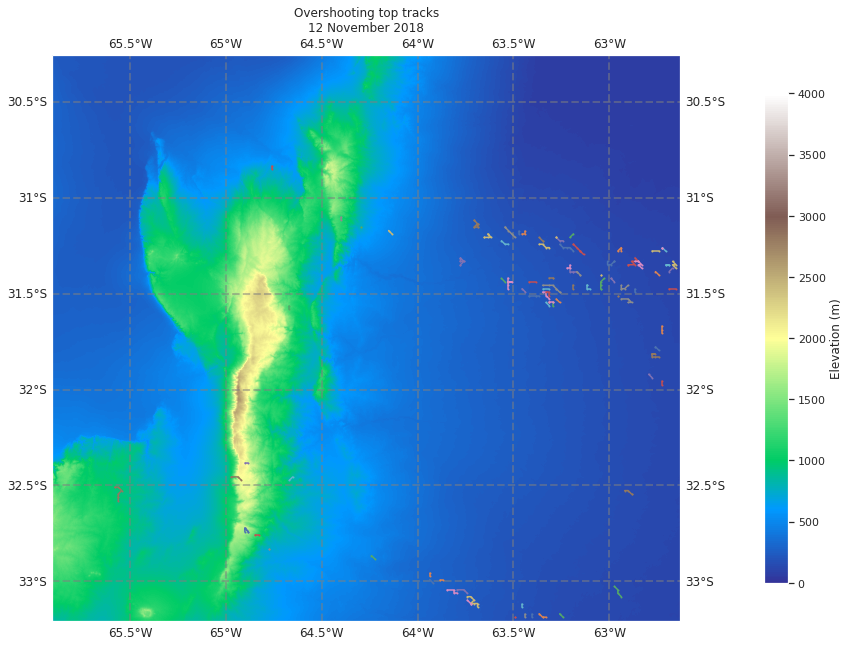
llcrnr=[-33.206342, -65.906586]
urcrnr=[-30.255825, -62.630553]
# Set extent of maps created in the following cells:
axis_extent=[llcrnr[1],urcrnr[1],llcrnr[0],urcrnr[0]]
# Plot map with all individual tracks:
import cartopy.crs as ccrs
fig_map,ax_map=plt.subplots(figsize=(15,15),subplot_kw={'projection': ccrs.PlateCarree()})
ax_map.coastlines()
ax_map.set_extent(axis_extent)
for ds in ds_list:
# cm = ax.contourf(ds.x.values[::5], ds.y.values[::5], ds.values[::5,::5], levs, cmap='terrain', transform=ccrs.PlateCarree())
cm = ax_map.imshow(ds.values, extent =[ds.x.min(),ds.x.max(),ds.y.min(),ds.y.max()], transform=ccrs.PlateCarree(), vmin=0, vmax=4000, cmap='terrain')
gl = ax_map.gridlines(crs=ccrs.PlateCarree(), draw_labels=True,
linewidth=2, color='gray', alpha=0.5, linestyle='--')
for name, group in cells_grouped:
# print(group.x,group.y)
cm2 = plt.scatter(group.lon,group.lat,c=group.area_polygon,vmin=0.,vmax=200.,s=group.area_polygon,
facecolors='none',cmap='magma',linewidth=0.5)
plt.colorbar(cm,label='Elevation (m)',shrink=0.4, pad=0.0)
plt.colorbar(cm2,label='OT Area (km$^2$)',shrink=0.4, pad=0.1)
ax_map.set_title('Overshooting top tracks\n12 November 2018')
Text(0.5, 1.0, 'Overshooting top tracks\n12 November 2018')
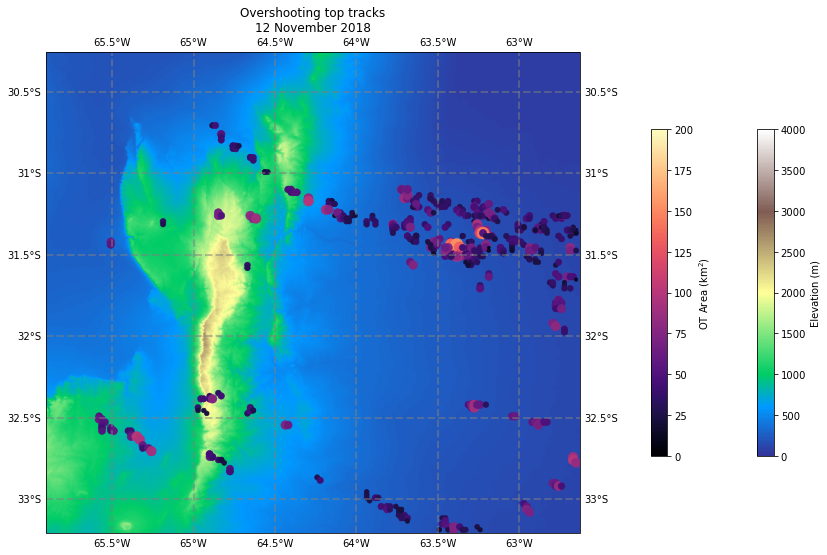
14 December Case¶
df = pd.concat([pd.read_csv(f) for f in sorted(glob.glob('ot_output/20181214/20181214*'))], ignore_index = True).drop(columns='Unnamed: 0')
df['geometry'] = df['geometry'].apply(wkt.loads)
geo_df = gpd.GeoDataFrame(df, geometry='geometry')
df['ot_depth'] = df['cloudtop_height'] - df['tropopause_height']
df = df[df.ot_depth > 0]
df = geo_df
df['diff'] = pd.to_datetime(df['time']) - pd.datetime(2018,11,1)
df['frame'] = df['diff'].dt.days*86400+df['diff'].dt.seconds
df['frame'] = df['frame'] - df['frame'].min()
df = df[df.prob > .7]
df_track = deepcopy(df)
#df_track.rename(columns={'lon':'x', 'lat':'y'}, inplace=True)
#df_track['z'] = 0
df_track['states'] = 0
df_track['label'] = 0
radius=6371228.
globe = ccrs.Globe(ellipse=None, semimajor_axis=radius,
semiminor_axis=radius)
projection=ccrs.LambertAzimuthalEqualArea(central_latitude=-32.,
central_longitude=-62.,globe=globe)
prj=pyproj.Proj(projection.proj4_init)
df_track['x'], df_track['y'] = prj(df_track['lon'].values, df_track['lat'].values)
df_track.to_csv('test.csv')
v_max=60.
stubs=2
order=1
extrapolate=1
memory=1
adaptive_stop=0.01
adaptive_step=0.99
subnetwork_size=100
method_linking= 'predict'
cell_number_start=1
dt = 60.
dxy = 2000.
search_range=dt*v_max
features_linking=deepcopy(df_track)
pred = tp.predict.NearestVelocityPredict(span=1)
trajectories_unfiltered = pred.link_df(features_linking, search_range=search_range, memory=memory,
pos_columns=['x','y'],
t_column='frame',
neighbor_strategy='KDTree', link_strategy='auto',
adaptive_step=adaptive_step,adaptive_stop=adaptive_stop
# copy_features=False, diagnostics=False,
# hash_size=None, box_size=None, verify_integrity=True,
# retain_index=False
)
trajectories_unfiltered['cell']=None
for i_particle,particle in enumerate(pd.Series.unique(trajectories_unfiltered['particle'])):
cell=int(i_particle+cell_number_start)
trajectories_unfiltered.loc[trajectories_unfiltered['particle']==particle,'cell']=cell
trajectories_unfiltered.drop(columns=['particle'],inplace=True)
trajectories_bycell=trajectories_unfiltered.groupby('cell')
num_stubs = 0
for cell,trajectories_cell in trajectories_bycell:
# logging.debug("cell: "+str(cell))
# logging.debug("feature: "+str(trajectories_cell['feature'].values))
# logging.debug("trajectories_cell.shape[0]: "+ str(trajectories_cell.shape[0]))
if trajectories_cell.shape[0] < stubs:
# print("cell" + str(cell)+ " is a stub ("+str(trajectories_cell.shape[0])+ "), setting cell number to Nan..")
trajectories_unfiltered.loc[trajectories_unfiltered['cell']==cell,'cell']=np.nan
num_stubs = num_stubs + 1
print('found this many stubs: {}'.format(num_stubs))
trajectories_filtered=trajectories_unfiltered.dropna()
Frame 23700: 1 trajectories present.
found this many stubs: 988
trajectories_filtered.time.max()
'2018-12-14 06:35:25.000000512'
cells_grouped = trajectories_filtered.groupby('cell')
df_max = cells_grouped.max()
df_max['duration']= cells_grouped.count().area_polygon
df_max = df_max[df_max.duration > 2]
slope, intercept, r, p, stderr = scipy.stats.linregress(df_max.duration, df_max.area_polygon)
line = f'Regression line: y={intercept:.2f}+{slope:.2f}x, r={r:.2f}'
plt.figure(figsize=(10,8))
ax = plt.subplot(111)
ax.scatter(duration, max_otarea)
ax.plot(np.array(duration), intercept + slope * np.array(duration), label=line, color='black')
plt.ylabel('OT Area ($km^{2}$)', fontsize=12)
plt.xlabel('OT Duration (minutes)', fontsize=12)
plt.legend(loc='upper right', fontsize=12)
plt.title('OT Duration 14 December 2018 \n 0000 - 0635 UTC (Count = 710)', fontsize=16)
Text(0.5, 1.0, 'OT Duration 14 December 2018 \n 0000 - 0635 UTC (Count = 710)')
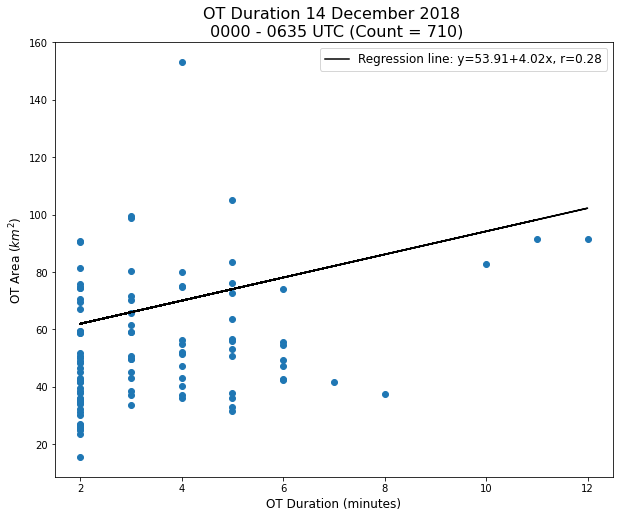
fig = plt.figure(figsize=(12,8))
plt.hist(df_max.area_polygon, bins=ota_bins)
plt.title('OTA Distribution \n 14 December 2018 0000-0635 UTC', fontsize=24)
plt.xlabel('OTA ($km^2$)', fontsize=16)
plt.ylabel('Frequency', fontsize=16)
Text(0, 0.5, 'Frequency')
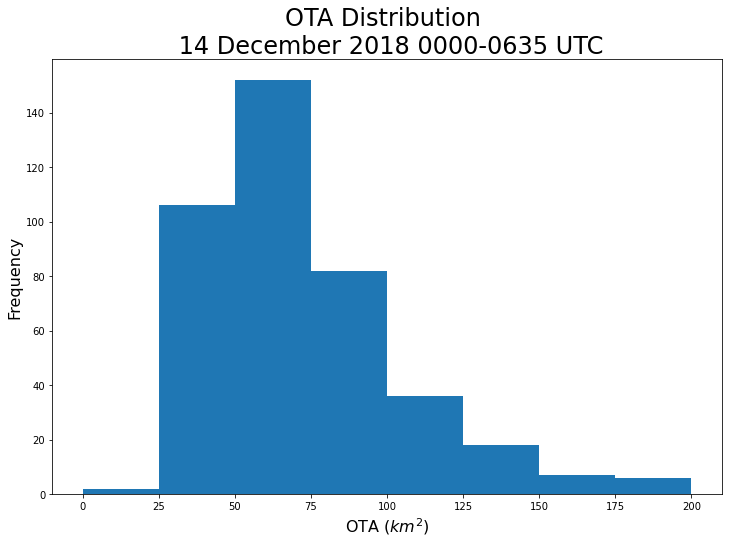
fig = plt.figure(figsize=(12,8))
plt.hist(df_max.ot_depth, bins=otd_bins)
plt.title('OT Depth Distribution \n 14 December 2018 0000-0635 UTC', fontsize=24)
plt.xlabel('OT Depth (km)', fontsize=16)
plt.ylabel('Frequency', fontsize=16)
Text(0, 0.5, 'Frequency')
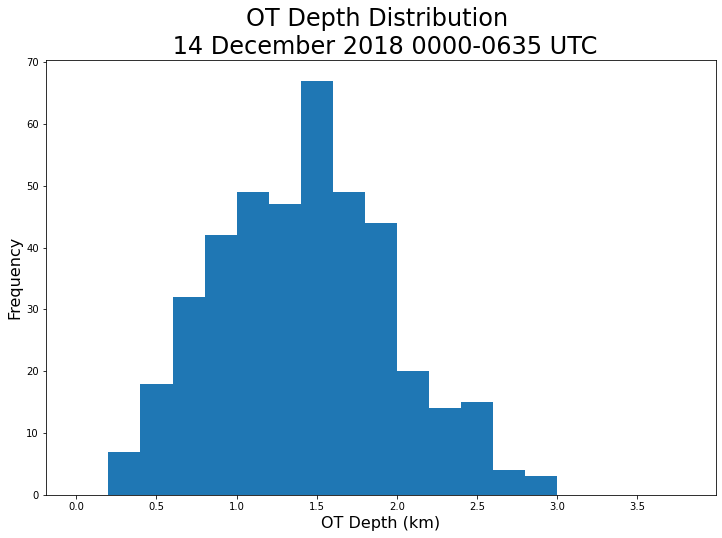
fig = plt.figure(figsize=(12,8))
plt.hist(df_max.duration, bins=dur_bins)
plt.title('OT Duration Distribution \n 14 December 2018 0000-0635 UTC', fontsize=24)
plt.xlabel('OT Duration (minutes)', fontsize=16)
plt.ylabel('Frequency', fontsize=16)
Text(0, 0.5, 'Frequency')
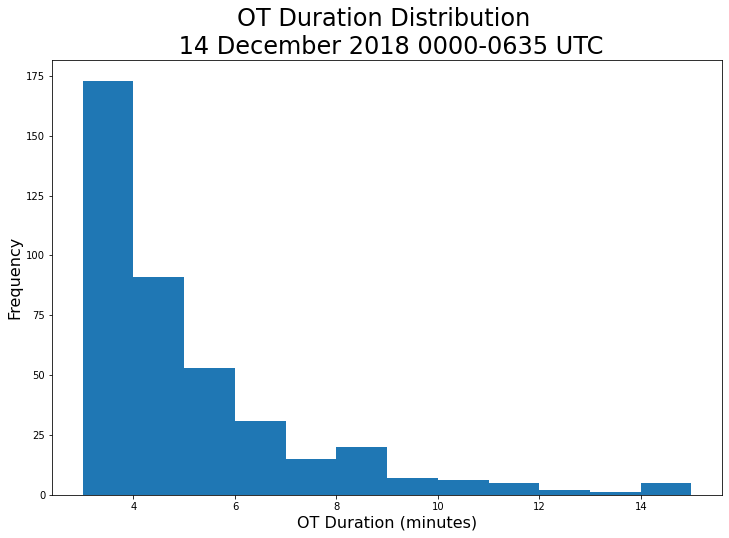
llcrnr=[-33.206342, -65.906586]
urcrnr=[-30.255825, -62.630553]
# Set extent of maps created in the following cells:
#axis_extent=[llcrnr[1],urcrnr[1],llcrnr[0],urcrnr[0]]
axis_extent=[-64.7, -63.7, -32.4, -31.4]
# Plot map with all individual tracks:
import cartopy.crs as ccrs
fig_map,ax_map=plt.subplots(figsize=(15,15),subplot_kw={'projection': ccrs.PlateCarree()})
ax_map.coastlines()
ax_map.set_extent(axis_extent)
for ds in ds_list:
# cm = ax.contourf(ds.x.values[::5], ds.y.values[::5], ds.values[::5,::5], levs, cmap='terrain', transform=ccrs.PlateCarree())
cm = ax_map.imshow(ds.values, extent =[ds.x.min(),ds.x.max(),ds.y.min(),ds.y.max()], transform=ccrs.PlateCarree(), vmin=0, vmax=4000, cmap='terrain')
gl = ax_map.gridlines(crs=ccrs.PlateCarree(), draw_labels=True,
linewidth=2, color='gray', alpha=0.5, linestyle='--')
for name, group in cells_grouped:
# print(group.x,group.y)
plt.plot(group.lon,group.lat,"-o",markersize=1)
plt.colorbar(cm,label='Elevation (m)',shrink=0.6, pad=0.1)
ax_map.set_title('Overshooting top tracks\n14 December 2018')
Text(0.5, 1.0, 'Overshooting top tracks\n14 December 2018')
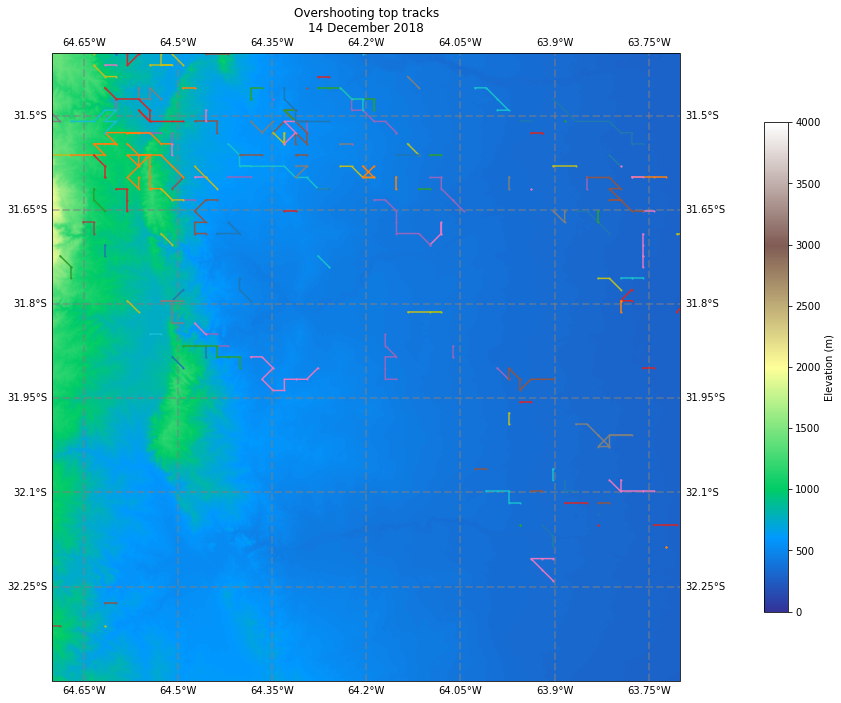
llcrnr=[-33.206342, -65.906586]
urcrnr=[-30.255825, -62.630553]
# Set extent of maps created in the following cells:
axis_extent=[llcrnr[1],urcrnr[1],llcrnr[0],urcrnr[0]]
# Plot map with all individual tracks:
import cartopy.crs as ccrs
fig_map,ax_map=plt.subplots(figsize=(15,15),subplot_kw={'projection': ccrs.PlateCarree()})
ax_map.coastlines()
ax_map.set_extent(axis_extent)
for ds in ds_list:
# cm = ax.contourf(ds.x.values[::5], ds.y.values[::5], ds.values[::5,::5], levs, cmap='terrain', transform=ccrs.PlateCarree())
cm = ax_map.imshow(ds.values, extent =[ds.x.min(),ds.x.max(),ds.y.min(),ds.y.max()], transform=ccrs.PlateCarree(), vmin=0, vmax=4000, cmap='terrain')
gl = ax_map.gridlines(crs=ccrs.PlateCarree(), draw_labels=True,
linewidth=2, color='gray', alpha=0.5, linestyle='--')
for name, group in cells_grouped:
# print(group.x,group.y)
cm2 = plt.scatter(group.lon,group.lat,c=group.area_polygon,vmin=0.,vmax=200.,s=group.area_polygon,
facecolors='none',cmap='magma',linewidth=0.5)
plt.colorbar(cm,label='Elevation (m)',shrink=0.4, pad=0.0)
plt.colorbar(cm2,label='OT Area (km$^2$)',shrink=0.4, pad=0.1)
ax_map.set_title('Overshooting top tracks\n14 December 2018')
Text(0.5, 1.0, 'Overshooting top tracks\n14 December 2018')
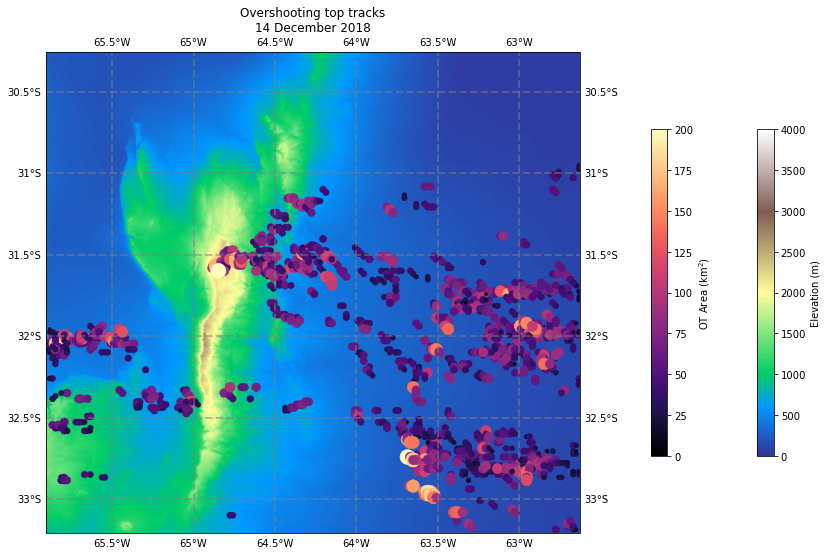
All OTs¶
df = pd.concat([pd.read_csv(f) for f in sorted(glob.glob('ot_output/*/*'))], ignore_index = True).drop(columns='Unnamed: 0')
df['geometry'] = df['geometry'].apply(wkt.loads)
geo_df = gpd.GeoDataFrame(df, geometry='geometry')
df = geo_df
df['ot_depth'] = df.cloudtop_height - df.tropopause_height
df['btd'] = df.mintb - df.tropopause_temperature
df = df[df.ot_depth > 0]
df['diff'] = pd.to_datetime(df['time']) - pd.datetime(2018,11,1)
df['frame'] = df['diff'].dt.days*86400+df['diff'].dt.seconds
df['frame'] = df['frame'] - df['frame'].min()
df = df[df.prob > .8]
df_track = deepcopy(df)
#df_track.rename(columns={'lon':'x', 'lat':'y'}, inplace=True)
#df_track['z'] = 0
df_track['states'] = 0
df_track['label'] = 0
radius=6371228.
globe = ccrs.Globe(ellipse=None, semimajor_axis=radius,
semiminor_axis=radius)
projection=ccrs.LambertAzimuthalEqualArea(central_latitude=-32.,
central_longitude=-62.,globe=globe)
prj=pyproj.Proj(projection.proj4_init)
df_track['x'], df_track['y'] = prj(df_track['lon'].values, df_track['lat'].values)
df_track.to_csv('test.csv')
v_max=60.
stubs=2
order=1
extrapolate=1
memory=1
adaptive_stop=0.01
adaptive_step=0.99
subnetwork_size=100
method_linking= 'predict'
cell_number_start=1
dt = 60.
dxy = 2000.
search_range=dt*v_max
features_linking=deepcopy(df_track)
pred = tp.predict.NearestVelocityPredict(span=1)
trajectories_unfiltered = pred.link_df(features_linking, search_range=search_range, memory=memory,
pos_columns=['x','y'],
t_column='frame',
neighbor_strategy='KDTree', link_strategy='auto',
adaptive_step=adaptive_step,adaptive_stop=adaptive_stop
# copy_features=False, diagnostics=False,
# hash_size=None, box_size=None, verify_integrity=True,
# retain_index=False
)
trajectories_unfiltered['cell']=None
for i_particle,particle in enumerate(pd.Series.unique(trajectories_unfiltered['particle'])):
cell=int(i_particle+cell_number_start)
trajectories_unfiltered.loc[trajectories_unfiltered['particle']==particle,'cell']=cell
trajectories_unfiltered.drop(columns=['particle'],inplace=True)
trajectories_bycell=trajectories_unfiltered.groupby('cell')
num_stubs = 0
for cell,trajectories_cell in trajectories_bycell:
# logging.debug("cell: "+str(cell))
# logging.debug("feature: "+str(trajectories_cell['feature'].values))
# logging.debug("trajectories_cell.shape[0]: "+ str(trajectories_cell.shape[0]))
if trajectories_cell.shape[0] < stubs:
# print("cell" + str(cell)+ " is a stub ("+str(trajectories_cell.shape[0])+ "), setting cell number to Nan..")
trajectories_unfiltered.loc[trajectories_unfiltered['cell']==cell,'cell']=np.nan
num_stubs = num_stubs + 1
print('found this many stubs: {}'.format(num_stubs))
trajectories_filtered=trajectories_unfiltered.dropna(subset=['area_polygon', 'cell'])
Frame 2902710: 1 trajectories present.
found this many stubs: 974
df = trajectories_filtered
df['time'] = pd.to_datetime(trajectories_filtered.time)
df['day'] = df.time.dt.day
df['month'] = df.time.dt.month
/data/keeling/a/mgrover4/a/miniconda3/envs/xesmf_env/lib/python3.7/site-packages/ipykernel_launcher.py:3: SettingWithCopyWarning:
A value is trying to be set on a copy of a slice from a DataFrame.
Try using .loc[row_indexer,col_indexer] = value instead
See the caveats in the documentation: https://pandas.pydata.org/pandas-docs/stable/user_guide/indexing.html#returning-a-view-versus-a-copy
This is separate from the ipykernel package so we can avoid doing imports until
/data/keeling/a/mgrover4/a/miniconda3/envs/xesmf_env/lib/python3.7/site-packages/ipykernel_launcher.py:4: SettingWithCopyWarning:
A value is trying to be set on a copy of a slice from a DataFrame.
Try using .loc[row_indexer,col_indexer] = value instead
See the caveats in the documentation: https://pandas.pydata.org/pandas-docs/stable/user_guide/indexing.html#returning-a-view-versus-a-copy
after removing the cwd from sys.path.
/data/keeling/a/mgrover4/a/miniconda3/envs/xesmf_env/lib/python3.7/site-packages/ipykernel_launcher.py:5: SettingWithCopyWarning:
A value is trying to be set on a copy of a slice from a DataFrame.
Try using .loc[row_indexer,col_indexer] = value instead
See the caveats in the documentation: https://pandas.pydata.org/pandas-docs/stable/user_guide/indexing.html#returning-a-view-versus-a-copy
"""
cells_grouped = df.groupby('cell')
df_max = cells_grouped.max()
df_min = cells_grouped.min()
df_max['duration']= cells_grouped.count().area_polygon
df_min['duration'] = cells_grouped.count().area_polygon
df_max = df_max[df_max.duration > 2]
df_min = df_min[df_min.duration > 2]
df_max['day'] = df_min.day
nov_10 = df_max[(df_max.day == 10) | (df_max.day == 11)]
nov_12 = df_max[df_max.day == 12]
dec_14 = df_max[(df_max.day == 14) | (df_max.day == 13)]
nov_10 = df[df.day == 10]
nov_12 = df[df.day == 12]
dec_14 = df[df.day == 14]
llcrnr=[-33.206342, -65.906586]
urcrnr=[-30.255825, -62.630553]
# Set extent of maps created in the following cells:
axis_extent=[-65, -63, -33, -31]
# Plot map with all individual tracks:
import cartopy.crs as ccrs
fig_map,ax_map=plt.subplots(figsize=(12,8),subplot_kw={'projection': ccrs.PlateCarree()})
levs = np.arange(0, 2000, 100)
ax_map.coastlines()
ax_map.set_extent(axis_extent)
for ds in ds_list:
cm = ax_map.contourf(ds.x.values[::5], ds.y.values[::5], ds.values[::5, ::5], levs, cmap='terrain', transform=ccrs.PlateCarree())
gl = ax_map.gridlines(crs=ccrs.PlateCarree(), draw_labels=True,
linewidth=2, color='gray', alpha=0.5, linestyle='--')
gl.top_labels = False
gl.left_labels= True
gl.right_labels = False
gl.xlabel_style = {'size': 16, 'color': 'k'}
gl.ylabel_style = {'size': 16, 'color': 'k'}
cm2 = plt.scatter(dec_14.lon.values,dec_14.lat.values,c=dec_14.area_polygon.values,vmin=0.,vmax=200.,s=dec_14.area_polygon,
facecolors='none',cmap='magma',linewidth=0.5)
cbar = plt.colorbar(cm, extend='both', label='Elevation (m)')
cbar.set_label(label='Elevation (m)', fontsize=16)
cbar.ax.tick_params(labelsize=16)
cbar2 = plt.colorbar(cm2,label='OT Area (km$^2$)', pad=0.1)
cbar2.set_label(label='OT Area (km$^2$)', fontsize=16)
cbar2.ax.tick_params(labelsize=16)
ax_map.set_title('Peak OTA \n 14 December 2018', fontsize=24)
/data/keeling/a/mgrover4/a/miniconda3/envs/xesmf_env/lib/python3.7/site-packages/ipykernel_launcher.py:31: MatplotlibDeprecationWarning: The 'extend' parameter to Colorbar has no effect because it is overridden by the mappable; it is deprecated since 3.3 and will be removed two minor releases later.
Text(0.5, 1.0, 'Peak OTA \n 14 December 2018')

llcrnr=[-33.206342, -65.906586]
urcrnr=[-30.255825, -62.630553]
# Set extent of maps created in the following cells:
axis_extent=[-65, -63, -33, -31]
# Plot map with all individual tracks:
import cartopy.crs as ccrs
fig_map,ax_map=plt.subplots(figsize=(12,8),subplot_kw={'projection': ccrs.PlateCarree()})
levs = np.arange(0, 2000, 100)
ax_map.coastlines()
ax_map.set_extent(axis_extent)
for ds in ds_list:
cm = ax_map.contourf(ds.x.values[::5], ds.y.values[::5], ds.values[::5, ::5], levs, cmap='terrain', transform=ccrs.PlateCarree())
gl = ax_map.gridlines(crs=ccrs.PlateCarree(), draw_labels=True,
linewidth=2, color='gray', alpha=0.5, linestyle='--')
cm2 = plt.scatter(dec_14.lon.values,dec_14.lat.values,c=dec_14.duration.values,vmin=0.,vmax=15.,s=dec_14.area_polygon,
facecolors='none',cmap='magma',linewidth=0.5)
cbar = plt.colorbar(cm, extend='both', label='Elevation (m)')
cbar.set_label(label='Elevation (m)', fontsize=16)
cbar.ax.tick_params(labelsize=16)
cbar2 = plt.colorbar(cm2,label='OT Area (km$^2$)', pad=0.1)
cbar2.set_label(label='Duration (minutes)', fontsize=16)
cbar2.ax.tick_params(labelsize=16)
ax_map.set_title('OT Duration \n 14 December 2018', fontsize=24)
/data/keeling/a/mgrover4/a/miniconda3/envs/xesmf_env/lib/python3.7/site-packages/ipykernel_launcher.py:26: MatplotlibDeprecationWarning: The 'extend' parameter to Colorbar has no effect because it is overridden by the mappable; it is deprecated since 3.3 and will be removed two minor releases later.
Text(0.5, 1.0, 'OT Duration \n 14 December 2018')
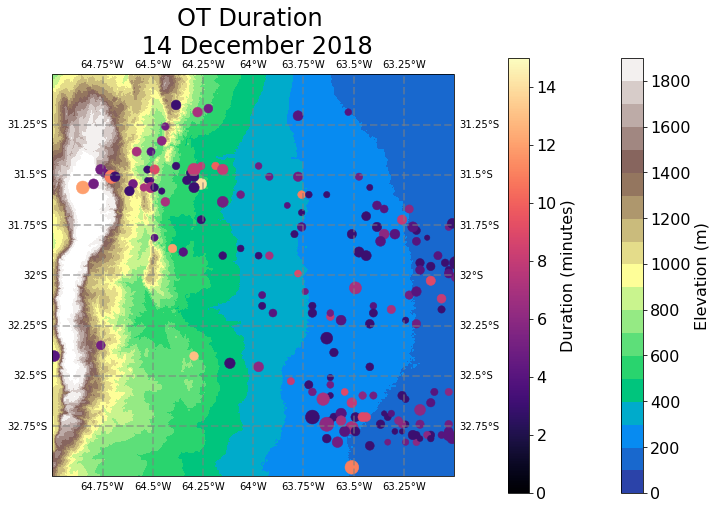
llcrnr=[-33.206342, -65.906586]
urcrnr=[-30.255825, -62.630553]
# Plot map with all individual tracks:
import cartopy.crs as ccrs
fig_map,ax_map=plt.subplots(figsize=(12,8),subplot_kw={'projection': ccrs.PlateCarree()})
levs = np.arange(0, 2000, 100)
ax_map.coastlines()
ax_map.set_extent(axis_extent)
for ds in ds_list:
cm = ax_map.contourf(ds.x.values[::5], ds.y.values[::5], ds.values[::5, ::5], levs, cmap='terrain', transform=ccrs.PlateCarree())
gl = ax_map.gridlines(crs=ccrs.PlateCarree(), draw_labels=True,
linewidth=2, color='gray', alpha=0.5, linestyle='--')
gl.top_labels = False
gl.left_labels= True
gl.right_labels = False
gl.xlabel_style = {'size': 16, 'color': 'k'}
gl.ylabel_style = {'size': 16, 'color': 'k'}
cm2 = plt.scatter(dec_14.lon.values,dec_14.lat.values,c=dec_14.ot_depth.values,s=dec_14.area_polygon,
facecolors='none',cmap='magma',linewidth=0.5)
cbar = plt.colorbar(cm, extend='both', label='Elevation (m)')
cbar.set_label(label='Elevation (m)', fontsize=16)
cbar.ax.tick_params(labelsize=16)
cbar2 = plt.colorbar(cm2,label='OT Area (km$^2$)', pad=0.1)
cbar2.set_label(label='OT Depth (km)', fontsize=16)
cbar2.ax.tick_params(labelsize=16)
ax_map.set_title('Peak OT Depth \n 14 December 2018', fontsize=24)
/data/keeling/a/mgrover4/a/miniconda3/envs/xesmf_env/lib/python3.7/site-packages/ipykernel_launcher.py:28: MatplotlibDeprecationWarning: The 'extend' parameter to Colorbar has no effect because it is overridden by the mappable; it is deprecated since 3.3 and will be removed two minor releases later.
Text(0.5, 1.0, 'Peak OT Depth \n 14 December 2018')
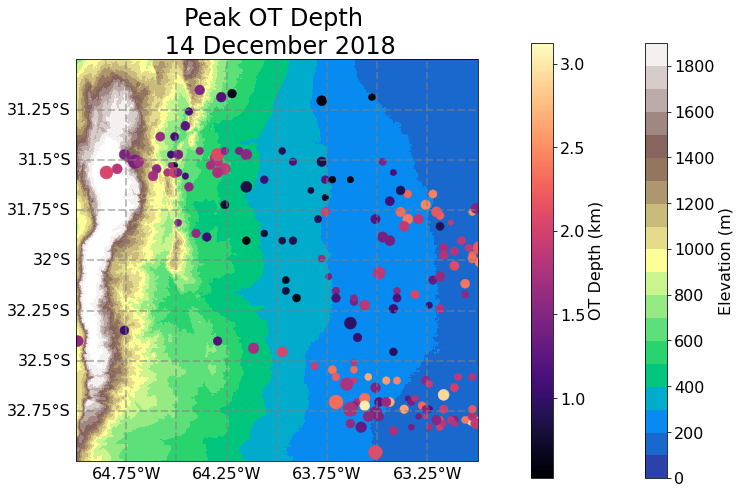
llcrnr=[-33.206342, -65.906586]
urcrnr=[-30.255825, -62.630553]
# Plot map with all individual tracks:
import cartopy.crs as ccrs
fig_map,ax_map=plt.subplots(figsize=(12,8),subplot_kw={'projection': ccrs.PlateCarree()})
levs = np.arange(0, 2000, 100)
ax_map.coastlines()
ax_map.set_extent(axis_extent)
for ds in ds_list:
cm = ax_map.contourf(ds.x.values[::5], ds.y.values[::5], ds.values[::5, ::5], levs, cmap='terrain', transform=ccrs.PlateCarree())
gl = ax_map.gridlines(crs=ccrs.PlateCarree(), draw_labels=True,
linewidth=2, color='gray', alpha=0.5, linestyle='--')
gl.top_labels = False
gl.left_labels= True
gl.right_labels = False
gl.xlabel_style = {'size': 16, 'color': 'k'}
gl.ylabel_style = {'size': 16, 'color': 'k'}
cm2 = plt.scatter(dec_14.lon.values,dec_14.lat.values,c=dec_14.time.values,s=dec_14.area_polygon,
facecolors='none',cmap='magma',linewidth=0.5)
# Change the numeric ticks into ones that match the x-axis
cbar = plt.colorbar(cm, extend='both', label='Elevation (m)')
cbar.set_label(label='Elevation (m)', fontsize=16)
cbar.ax.tick_params(labelsize=16)
cbar2 = plt.colorbar(cm2,label='OT Area (km$^2$)')
cbar2.set_label(label='Time', fontsize=16)
cbar2.ax.tick_params(labelsize=16)
cbar2.ax.set_yticklabels(pd.to_datetime(cbar2.get_ticks()).strftime(date_format='%H:%M'))
ax_map.set_title('OT Events \n 13-14 December 2018', fontsize=24)
/data/keeling/a/mgrover4/a/miniconda3/envs/xesmf_env/lib/python3.7/site-packages/ipykernel_launcher.py:32: MatplotlibDeprecationWarning: The 'extend' parameter to Colorbar has no effect because it is overridden by the mappable; it is deprecated since 3.3 and will be removed two minor releases later.
/data/keeling/a/mgrover4/a/miniconda3/envs/xesmf_env/lib/python3.7/site-packages/ipykernel_launcher.py:39: UserWarning: FixedFormatter should only be used together with FixedLocator
Text(0.5, 1.0, 'OT Events \n 13-14 December 2018')
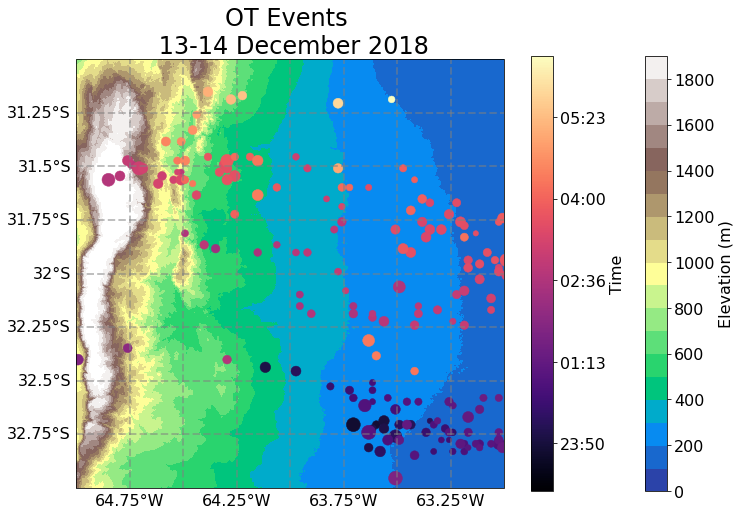
llcrnr=[-33.206342, -65.906586]
urcrnr=[-30.255825, -62.630553]
# Set extent of maps created in the following cells:
axis_extent=[-65, -63, -33, -31]
# Plot map with all individual tracks:
import cartopy.crs as ccrs
fig_map,ax_map=plt.subplots(figsize=(12,8),subplot_kw={'projection': ccrs.PlateCarree()})
levs = np.arange(0, 2000, 100)
ax_map.coastlines()
ax_map.set_extent(axis_extent)
for ds in ds_list:
cm = ax_map.contourf(ds.x.values[::5], ds.y.values[::5], ds.values[::5, ::5], levs, cmap='terrain', transform=ccrs.PlateCarree())
gl = ax_map.gridlines(crs=ccrs.PlateCarree(), draw_labels=True,
linewidth=2, color='gray', alpha=0.5, linestyle='--')
gl.top_labels = False
gl.left_labels= True
gl.right_labels = False
gl.xlabel_style = {'size': 16, 'color': 'k'}
gl.ylabel_style = {'size': 16, 'color': 'k'}
cm2 = plt.scatter(nov_10.lon.values,nov_10.lat.values,c=nov_10.area_polygon.values,vmin=0.,vmax=200.,s=nov_10.area_polygon,
facecolors='none',cmap='magma',linewidth=0.5)
cbar = plt.colorbar(cm, extend='both', label='Elevation (m)')
cbar.set_label(label='Elevation (m)', fontsize=16)
cbar.ax.tick_params(labelsize=16)
cbar2 = plt.colorbar(cm2,label='OT Area (km$^2$)', pad=0.1)
cbar2.set_label(label='OT Area (km$^2$)', fontsize=16)
cbar2.ax.tick_params(labelsize=16)
ax_map.set_title('Peak OTA from OT Tracks \n 10 November 2018', fontsize=24)
/data/keeling/a/mgrover4/a/miniconda3/envs/xesmf_env/lib/python3.7/site-packages/ipykernel_launcher.py:31: MatplotlibDeprecationWarning: The 'extend' parameter to Colorbar has no effect because it is overridden by the mappable; it is deprecated since 3.3 and will be removed two minor releases later.
Text(0.5, 1.0, 'Peak OTA from OT Tracks \n 10 November 2018')
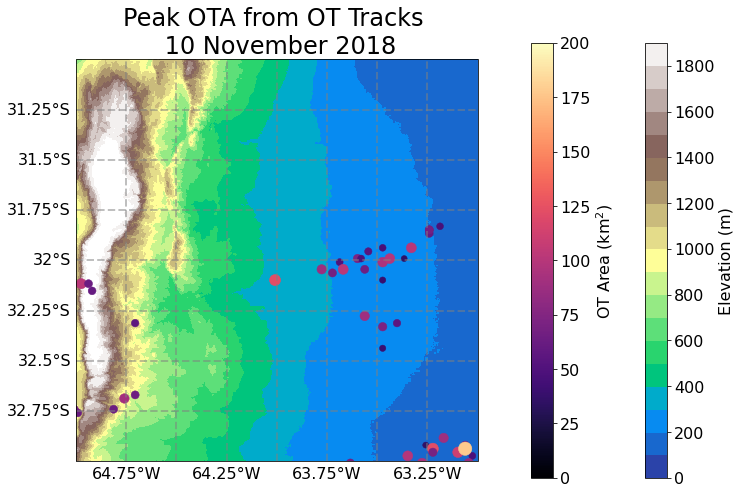
llcrnr=[-33.206342, -65.906586]
urcrnr=[-30.255825, -62.630553]
# Plot map with all individual tracks:
import cartopy.crs as ccrs
fig_map,ax_map=plt.subplots(figsize=(12,8),subplot_kw={'projection': ccrs.PlateCarree()})
levs = np.arange(0, 2000, 100)
ax_map.coastlines()
ax_map.set_extent(axis_extent)
for ds in ds_list:
cm = ax_map.contourf(ds.x.values[::5], ds.y.values[::5], ds.values[::5, ::5], levs, cmap='terrain', transform=ccrs.PlateCarree())
gl = ax_map.gridlines(crs=ccrs.PlateCarree(), draw_labels=True,
linewidth=2, color='gray', alpha=0.5, linestyle='--')
gl.top_labels = False
gl.left_labels= True
gl.right_labels = False
gl.xlabel_style = {'size': 16, 'color': 'k'}
gl.ylabel_style = {'size': 16, 'color': 'k'}
cm2 = plt.scatter(nov_10.lon.values,nov_10.lat.values,c=nov_10.duration.values,vmin=0.,vmax=15.,s=nov_10.area_polygon,
facecolors='none',cmap='magma',linewidth=0.5)
cbar = plt.colorbar(cm, extend='both', label='Elevation (m)')
cbar.set_label(label='Elevation (m)', fontsize=16)
cbar.ax.tick_params(labelsize=16)
cbar2 = plt.colorbar(cm2,label='OT Area (km$^2$)', pad=0.1)
cbar2.set_label(label='Duration (min)', fontsize=16)
cbar2.ax.tick_params(labelsize=16)
ax_map.set_title('OT Duration \n 10 November 2018', fontsize=24)
/data/keeling/a/mgrover4/a/miniconda3/envs/xesmf_env/lib/python3.7/site-packages/ipykernel_launcher.py:28: MatplotlibDeprecationWarning: The 'extend' parameter to Colorbar has no effect because it is overridden by the mappable; it is deprecated since 3.3 and will be removed two minor releases later.
Text(0.5, 1.0, 'OT Duration \n 10 November 2018')
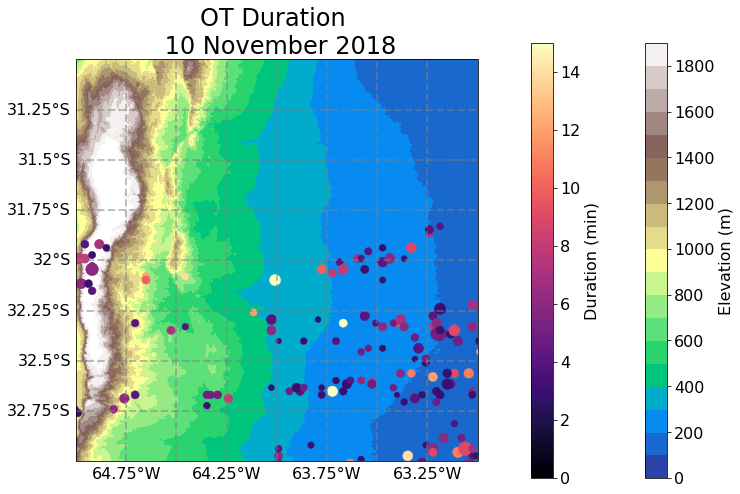
llcrnr=[-33.206342, -65.906586]
urcrnr=[-30.255825, -62.630553]
# Plot map with all individual tracks:
import cartopy.crs as ccrs
fig_map,ax_map=plt.subplots(figsize=(12,8),subplot_kw={'projection': ccrs.PlateCarree()})
levs = np.arange(0, 2000, 100)
ax_map.coastlines()
ax_map.set_extent(axis_extent)
for ds in ds_list:
cm = ax_map.contourf(ds.x.values[::5], ds.y.values[::5], ds.values[::5, ::5], levs, cmap='terrain', transform=ccrs.PlateCarree())
gl = ax_map.gridlines(crs=ccrs.PlateCarree(), draw_labels=True,
linewidth=2, color='gray', alpha=0.5, linestyle='--')
gl.top_labels = False
gl.left_labels= True
gl.right_labels = False
gl.xlabel_style = {'size': 16, 'color': 'k'}
gl.ylabel_style = {'size': 16, 'color': 'k'}
cm2 = plt.scatter(nov_10.lon.values,nov_10.lat.values,c=nov_10.time.values,s=nov_10.area_polygon,
facecolors='none',cmap='magma',linewidth=0.5)
cbar = plt.colorbar(cm, extend='both', label='Elevation (m)')
cbar.set_label(label='Elevation (m)', fontsize=16)
cbar.ax.tick_params(labelsize=16)
cbar2 = plt.colorbar(cm2,label='OT Area (km$^2$)')
cbar2.set_label(label='Time', fontsize=16)
cbar2.ax.tick_params(labelsize=16)
cbar2.ax.set_yticklabels(pd.to_datetime(cbar2.get_ticks()).strftime(date_format='%H:%M'))
ax_map.set_title('OT Events \n 10 November 2018', fontsize=24)
/data/keeling/a/mgrover4/a/miniconda3/envs/xesmf_env/lib/python3.7/site-packages/ipykernel_launcher.py:28: MatplotlibDeprecationWarning: The 'extend' parameter to Colorbar has no effect because it is overridden by the mappable; it is deprecated since 3.3 and will be removed two minor releases later.
/data/keeling/a/mgrover4/a/miniconda3/envs/xesmf_env/lib/python3.7/site-packages/ipykernel_launcher.py:35: UserWarning: FixedFormatter should only be used together with FixedLocator
Text(0.5, 1.0, 'OT Events \n 10 November 2018')
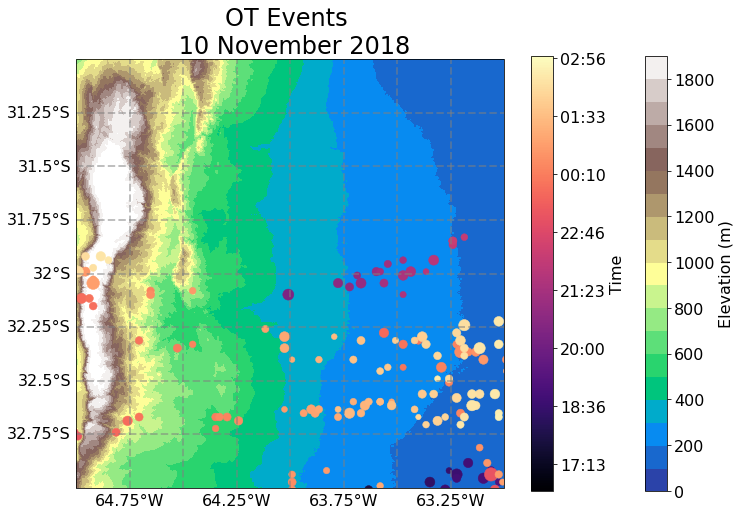
llcrnr=[-33.206342, -65.906586]
urcrnr=[-30.255825, -62.630553]
# Plot map with all individual tracks:
import cartopy.crs as ccrs
fig_map,ax_map=plt.subplots(figsize=(12,8),subplot_kw={'projection': ccrs.PlateCarree()})
levs = np.arange(0, 2000, 100)
ax_map.coastlines()
ax_map.set_extent(axis_extent)
for ds in ds_list:
cm = ax_map.contourf(ds.x.values[::5], ds.y.values[::5], ds.values[::5, ::5], levs, cmap='terrain', transform=ccrs.PlateCarree())
gl = ax_map.gridlines(crs=ccrs.PlateCarree(), draw_labels=True,
linewidth=2, color='gray', alpha=0.5, linestyle='--')
gl.top_labels = False
gl.left_labels= True
gl.right_labels = False
gl.xlabel_style = {'size': 16, 'color': 'k'}
gl.ylabel_style = {'size': 16, 'color': 'k'}
cm2 = plt.scatter(nov_10.lon.values,nov_10.lat.values,c=nov_10.ot_depth.values,vmin=0.,vmax=3.,s=nov_10.area_polygon,
facecolors='none',cmap='magma',linewidth=0.5)
cbar = plt.colorbar(cm, extend='both', label='Elevation (m)')
cbar.set_label(label='Elevation (m)', fontsize=16)
cbar.ax.tick_params(labelsize=16)
cbar2 = plt.colorbar(cm2,label='OT Area (km$^2$)', pad=0.1)
cbar2.set_label(label='Depth (km)', fontsize=16)
cbar2.ax.tick_params(labelsize=16)
ax_map.set_title('Peak OT Depth \n 10 November 2018', fontsize=24)
/data/keeling/a/mgrover4/a/miniconda3/envs/xesmf_env/lib/python3.7/site-packages/ipykernel_launcher.py:29: MatplotlibDeprecationWarning: The 'extend' parameter to Colorbar has no effect because it is overridden by the mappable; it is deprecated since 3.3 and will be removed two minor releases later.
Text(0.5, 1.0, 'Peak OT Depth \n 10 November 2018')
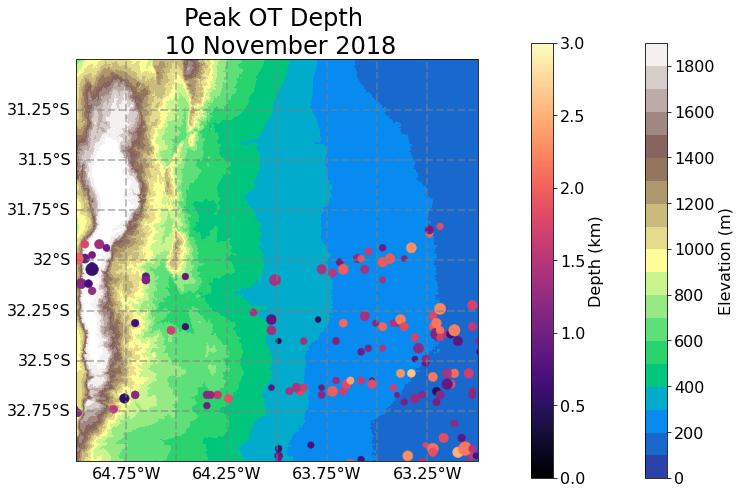
dec_14
| area_polygon | cloudtop_height | e_radial | e_radial_del2 | e_tb | geometry | lat | lat_corr | lon | lon_corr | ... | btd | diff | frame | states | label | x | y | cell | day | month | |
|---|---|---|---|---|---|---|---|---|---|---|---|---|---|---|---|---|---|---|---|---|---|
| 4353 | 27.820872 | 17.008001 | 2.512100 | [ 0.15357971 0.16321182 0.05794525 -0.138183... | [197.50794983 198.54685974 199.89292908 201.27... | POLYGON ((-63.41965 -32.72321, -63.40088 -32.7... | -32.687500 | -32.564499 | -63.419647 | -63.465649 | ... | -7.050003 | 43 days 00:00:25.000000512 | 2879071 | 0 | 0 | -132858.256112 | -77325.241389 | 958 | 14 | 12 |
| 4354 | 45.744502 | 17.170000 | 5.021842 | [ 0.26845551 0.35186768 0.3476181 0.193073... | [196.36286926 195.73219299 195.63842773 195.87... | POLYGON ((-63.63393 -32.76786, -63.60579 -32.7... | -32.723213 | -32.599213 | -63.633930 | -63.679932 | ... | -8.329987 | 43 days 00:00:25.000000512 | 2879071 | 0 | 0 | -152848.759870 | -81580.793324 | 959 | 14 | 12 |
| 4356 | 35.420817 | 17.276001 | 3.344912 | [ 0.41732788 0.53477859 0.48075867 0.159931... | [196.95626831 197.06828308 198.01495361 199.43... | POLYGON ((-63.63393 -32.85714, -63.60109 -32.8... | -32.812500 | -32.687500 | -63.633930 | -63.679932 | ... | -9.210007 | 43 days 00:00:25.000000512 | 2879071 | 0 | 0 | -152696.307625 | -91508.748519 | 960 | 14 | 12 |
| 4357 | 33.917275 | 16.268002 | 3.335197 | [ 0.2013855 0.27927017 0.29254532 0.144180... | [203.81013489 203.84004211 204.27272034 205.01... | POLYGON ((-65.06250 -33.10714, -65.04374 -33.0... | -33.080357 | -32.962357 | -65.062500 | -65.100502 | ... | -5.000000 | 43 days 00:00:25.000000512 | 2879071 | 0 | 0 | -285295.264231 | -124204.623051 | 957 | 14 | 12 |
| 4358 | 57.817719 | 17.937000 | 4.996009 | [ 2.07168579e-01 2.75302887e-01 2.85362244e-... | [191.43812561 191.50009155 191.97639465 192.72... | POLYGON ((-62.77679 -33.19926, -62.76740 -33.1... | -33.187500 | -33.055500 | -62.776787 | -62.828785 | ... | -12.600006 | 43 days 00:00:25.000000512 | 2879071 | 0 | 0 | -72291.077516 | -132308.177974 | 952 | 14 | 12 |
| ... | ... | ... | ... | ... | ... | ... | ... | ... | ... | ... | ... | ... | ... | ... | ... | ... | ... | ... | ... | ... | ... |
| 7837 | 45.825843 | 16.686001 | 5.000000 | [ 0.16270447 0.23226547 0.25936508 0.153068... | [195.18452454 195.12481689 195.39051819 195.93... | POLYGON ((-67.61607 -27.00000, -67.58793 -26.9... | -31.205359 | -26.955357 | -63.526783 | -67.616074 | ... | -2.039993 | 43 days 06:25:25.000000512 | 2902171 | 0 | 0 | -145208.263845 | 87342.890014 | 1949 | 14 | 12 |
| 7840 | 24.486986 | 17.549002 | 3.000000 | [94.7826767 94.7826767 47.39133835 0. ... | [189.56535339 0. 0. 0. ... | POLYGON ((-66.72322 -26.75000, -66.70914 -26.7... | -30.973215 | -26.723215 | -62.633926 | -66.723221 | ... | -7.099991 | 43 days 06:27:25.000000512 | 2902291 | 0 | 0 | -60442.164268 | 113999.920948 | 1951 | 14 | 12 |
| 7843 | 30.263209 | 17.159000 | 3.000000 | [95.89810181 95.89810181 47.9490509 0. ... | [191.79620361 0. 0. 0. ... | POLYGON ((-66.72322 -26.74107, -66.70914 -26.7... | -30.955357 | -26.705357 | -62.633926 | -66.723221 | ... | -4.589996 | 43 days 06:28:25.000000512 | 2902351 | 0 | 0 | -60453.554044 | 115985.618850 | 1951 | 14 | 12 |
| 7856 | 59.017049 | 16.591002 | 4.000000 | [ 0.10934448 0.14450455 0.13109207 0.027835... | [195.60501099 195.75 196.11367798 196.61... | POLYGON ((-67.66964 -26.87500, -67.64619 -26.8... | -31.080357 | -26.830359 | -63.580360 | -67.669640 | ... | -1.300003 | 43 days 06:32:25.000000512 | 2902591 | 0 | 0 | -150502.769321 | 101169.280988 | 1954 | 14 | 12 |
| 7858 | 61.092856 | 16.749001 | 4.000000 | [ 0.13513947 0.17360687 0.14691925 0.013507... | [194.45181274 194.74206543 195.30259705 196.01... | POLYGON ((-67.63393 -26.88393, -67.61048 -26.8... | -31.080357 | -26.830359 | -63.544643 | -67.633926 | ... | -2.339996 | 43 days 06:34:24.999999488 | 2902710 | 0 | 0 | -147101.703963 | 101218.124030 | 1954 | 14 | 12 |
1608 rows × 49 columns
Linear Regression¶
slope, intercept, r, p, stderr = scipy.stats.linregress(df_max.area_polygon, df_max.duration)
line = f'r={r:.2f}, p= < 0.001'
plt.figure(figsize=(10,8))
ax = plt.subplot(111)
#max_depth_nov_10 = max_depth[max_depth.day == 10]
ax.scatter(dec_14.area_polygon, dec_14.duration, color='tab:blue', label='14 December 2018')
ax.scatter(nov_12.area_polygon, nov_12.duration, color='tab:green', label='12 November 2018')
ax.scatter(nov_10.area_polygon, nov_10.duration, color='tab:red', label='10 November 2018')
#ax.scatter(np.median(dec_14.duration), np.median(dec_14.area_polygon), color='blue', s=100)
#ax.scatter(np.median(nov_10.duration), np.median(nov_10.area_polygon), color='red', s=100)
#ax.scatter(np.median(nov_12.duration), np.median(nov_12.area_polygon), color='green', s=100)
#ax.scatter(np.mean(dec_14.duration), np.mean(dec_14.area_polygon), color='blue', s=100)
#ax.scatter(np.mean(nov_10.duration), np.mean(nov_10.area_polygon), color='red', s=100)
#ax.scatter(np.mean(nov_12.duration), np.mean(nov_12.area_polygon), color='green', s=100)
ax.plot(np.array(df_max.area_polygon), intercept + slope * np.array(df_max.area_polygon), label=line, color='black')
plt.ylabel('Duration (minutes)', fontsize=16)
plt.xlabel('Peak OTA ($km^{2}$)', fontsize=16)
plt.legend(loc='upper right', fontsize=12)
plt.xticks(fontsize=12)
plt.yticks(fontsize=12)
plt.title(f'OT Duration vs. Peak OTA \n All Cases (Count = {len(df_max)})', fontsize=16)
plt.savefig('OT_duration_Peak_OTA.png', dpi=300)
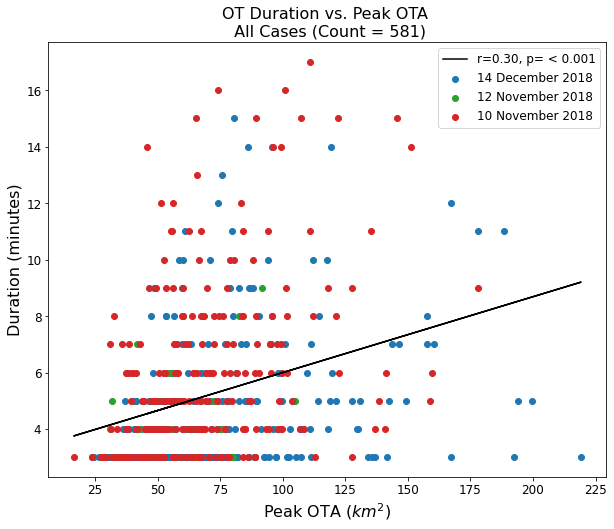
from sklearn.metrics import r2_score
x = df_max.area_polygon
y = df_max.duration
mymodel = numpy.poly1d(np.polyfit(x, y, 3))
linmodel = numpy.poly1d(np.polyfit(x, y, 1))
r_poly = np.sqrt(r2_score(y, mymodel(x)))
r_lin = np.sqrt(r2_score(y, linmodel(x)))
fig = plt.figure(figsize=(10, 8))
plt.scatter(x, y, label='OTs from 10 November, \n 12 November, 14 December 2018')
plt.scatter(x, mymodel(x), label=f'Polynomial Regression \n r= {round(r_poly, 2)}')
plt.plot(x, linmodel(x), linestyle='--', color='k', label=f'Linear Regression \n r= {round(r_lin, 2)}')
plt.legend(loc='upper right', fontsize=12)
plt.xlabel('Peak OTA ($km^2$)', fontsize=16)
plt.ylabel('Peak OT Duration ($minutes$)', fontsize=16)
Text(0, 0.5, 'Peak OT Duration ($minutes$)')
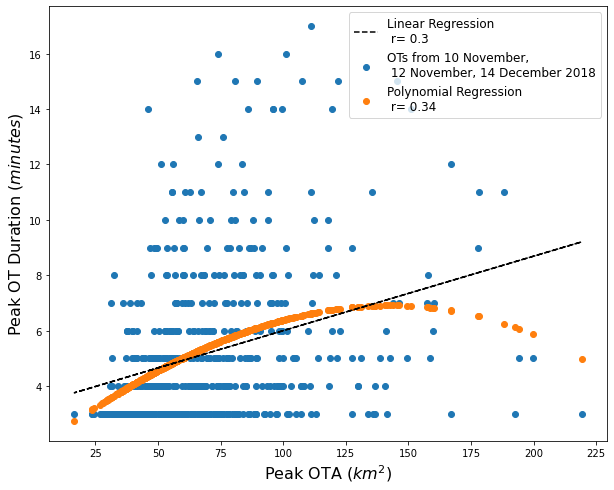
slope, intercept, r, p, stderr = scipy.stats.linregress(df_max.area_polygon, df_max.ot_depth)
line = f'r={r:.2f}, p= < 0.001'
plt.figure(figsize=(10,8))
ax = plt.subplot(111)
#max_depth_nov_10 = max_depth[max_depth.day == 10]
ax.scatter(dec_14.area_polygon, dec_14.ot_depth, color='tab:blue', label='14 December 2018')
ax.scatter(nov_12.area_polygon, nov_12.ot_depth, color='tab:green', label='12 November 2018')
ax.scatter(nov_10.area_polygon, nov_10.ot_depth, color='tab:red', label='10 November 2018')
#ax.scatter(np.median(dec_14.area_polygon), np.median(dec_14.ot_depth), color='blue', s=100)
#ax.scatter(np.median(nov_10.area_polygon), np.median(nov_10.ot_depth), color='red', s=100)
#ax.scatter(np.median(nov_12.area_polygon), np.median(nov_12.ot_depth), color='green', s=100)
ax.plot(np.array(df_max.area_polygon), intercept + slope * np.array(df_max.area_polygon), label=line, color='black')
plt.xlabel('Peak OTA ($km^{2}$)', fontsize=16)
plt.ylabel('Peak OT Depth (km)', fontsize=16)
plt.legend(loc='upper right', fontsize=12)
plt.xticks(fontsize=12)
plt.yticks(fontsize=12)
plt.title(f'Peak OTA vs. Peak OT Depth \n All Cases (Count = {len(df_max)})', fontsize=16)
plt.savefig('OTA_OT_Depth.png', dpi=300)
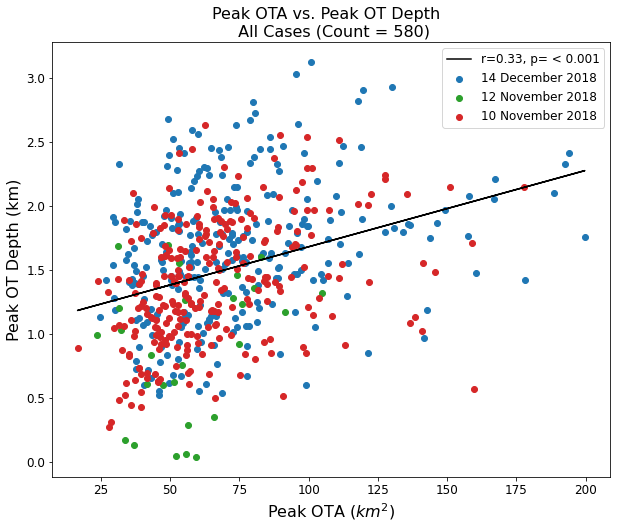
slope, intercept, r, p, stderr = scipy.stats.linregress(df_max.area_polygon, df_max.ot_depth)
nov_10_min = df_min[df_min.day == 10]
nov_12_min = df_min[df_min.day == 12]
dec_14_min = df_min[df_min.day == 14]
slope, intercept, r, p, stderr = scipy.stats.linregress(df_min.btd, df_max.ot_depth)
line = f'r={r:.2f}'
plt.figure(figsize=(10,8))
ax = plt.subplot(111)
#max_depth_nov_10 = max_depth[max_depth.day == 10]
ax.scatter(dec_14_min.btd, dec_14.ot_depth, color='tab:blue', label='14 December 2018')
ax.scatter(nov_12_min.btd, nov_12.ot_depth, color='tab:green', label='12 November 2018')
ax.scatter(nov_10_min.btd, nov_10.ot_depth, color='tab:red', label='10 November 2018')
ax.scatter(np.median(dec_14_min.btd), np.median(dec_14.ot_depth), color='blue', s=100)
ax.scatter(np.median(nov_10_min.btd), np.median(nov_10.ot_depth), color='red', s=100)
ax.scatter(np.median(nov_12_min.btd), np.median(nov_12.ot_depth), color='green', s=100)
ax.plot(np.array(df_min.btd), intercept + slope * np.array(df_min.btd), label=line, color='black')
plt.xlabel('BTD (IR Temp - Trop Temp) (K)', fontsize=12)
plt.ylabel('OT Depth (km)', fontsize=12)
plt.legend(loc='upper right', fontsize=12)
plt.title('OT BTD vs. OT Depth \n 10 November, 12 November, 14 December 2018 UTC (Count = 579)', fontsize=16)
---------------------------------------------------------------------------
ValueError Traceback (most recent call last)
<ipython-input-24-2390c796d286> in <module>
6 ax = plt.subplot(111)
7 #max_depth_nov_10 = max_depth[max_depth.day == 10]
----> 8 ax.scatter(dec_14_min.btd, dec_14.ot_depth, color='tab:blue', label='14 December 2018')
9 ax.scatter(nov_12_min.btd, nov_12.ot_depth, color='tab:green', label='12 November 2018')
10 ax.scatter(nov_10_min.btd, nov_10.ot_depth, color='tab:red', label='10 November 2018')
~/a/miniconda3/envs/xesmf_env/lib/python3.7/site-packages/matplotlib/__init__.py in inner(ax, data, *args, **kwargs)
1436 def inner(ax, *args, data=None, **kwargs):
1437 if data is None:
-> 1438 return func(ax, *map(sanitize_sequence, args), **kwargs)
1439
1440 bound = new_sig.bind(ax, *args, **kwargs)
~/a/miniconda3/envs/xesmf_env/lib/python3.7/site-packages/matplotlib/cbook/deprecation.py in wrapper(*inner_args, **inner_kwargs)
409 else deprecation_addendum,
410 **kwargs)
--> 411 return func(*inner_args, **inner_kwargs)
412
413 return wrapper
~/a/miniconda3/envs/xesmf_env/lib/python3.7/site-packages/matplotlib/axes/_axes.py in scatter(self, x, y, s, c, marker, cmap, norm, vmin, vmax, alpha, linewidths, verts, edgecolors, plotnonfinite, **kwargs)
4439 y = np.ma.ravel(y)
4440 if x.size != y.size:
-> 4441 raise ValueError("x and y must be the same size")
4442
4443 if s is None:
ValueError: x and y must be the same size
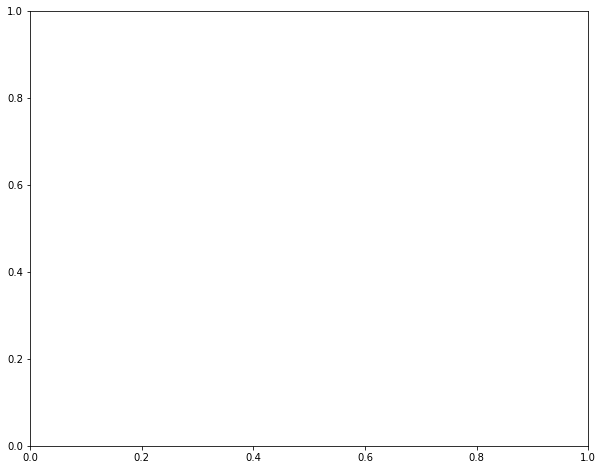
def calc_r(area, scale=0.412):
return np.sqrt(area*scale/np.pi)
df['mid_ur_50'] = calc_r(df['area_polygon'], 0.72)
df['mid_ur_60'] = calc_r(df['area_polygon'], 0.58)
df['mid_ur_70'] = calc_r(df['area_polygon'], 0.41)
df['mid_ur_80'] = calc_r(df['area_polygon'], 0.32)
df['mid_ur_90'] = calc_r(df['area_polygon'], 0.11)
df['mid_ur_95'] = calc_r(df['area_polygon'], 0.04)
df['mid_ud'] = calc_r(df['area_polygon']) * 2
/data/keeling/a/mgrover4/a/miniconda3/envs/xesmf_env/lib/python3.7/site-packages/ipykernel_launcher.py:1: SettingWithCopyWarning:
A value is trying to be set on a copy of a slice from a DataFrame.
Try using .loc[row_indexer,col_indexer] = value instead
See the caveats in the documentation: https://pandas.pydata.org/pandas-docs/stable/user_guide/indexing.html#returning-a-view-versus-a-copy
"""Entry point for launching an IPython kernel.
/data/keeling/a/mgrover4/a/miniconda3/envs/xesmf_env/lib/python3.7/site-packages/ipykernel_launcher.py:2: SettingWithCopyWarning:
A value is trying to be set on a copy of a slice from a DataFrame.
Try using .loc[row_indexer,col_indexer] = value instead
See the caveats in the documentation: https://pandas.pydata.org/pandas-docs/stable/user_guide/indexing.html#returning-a-view-versus-a-copy
/data/keeling/a/mgrover4/a/miniconda3/envs/xesmf_env/lib/python3.7/site-packages/ipykernel_launcher.py:3: SettingWithCopyWarning:
A value is trying to be set on a copy of a slice from a DataFrame.
Try using .loc[row_indexer,col_indexer] = value instead
See the caveats in the documentation: https://pandas.pydata.org/pandas-docs/stable/user_guide/indexing.html#returning-a-view-versus-a-copy
This is separate from the ipykernel package so we can avoid doing imports until
/data/keeling/a/mgrover4/a/miniconda3/envs/xesmf_env/lib/python3.7/site-packages/ipykernel_launcher.py:4: SettingWithCopyWarning:
A value is trying to be set on a copy of a slice from a DataFrame.
Try using .loc[row_indexer,col_indexer] = value instead
See the caveats in the documentation: https://pandas.pydata.org/pandas-docs/stable/user_guide/indexing.html#returning-a-view-versus-a-copy
after removing the cwd from sys.path.
/data/keeling/a/mgrover4/a/miniconda3/envs/xesmf_env/lib/python3.7/site-packages/ipykernel_launcher.py:5: SettingWithCopyWarning:
A value is trying to be set on a copy of a slice from a DataFrame.
Try using .loc[row_indexer,col_indexer] = value instead
See the caveats in the documentation: https://pandas.pydata.org/pandas-docs/stable/user_guide/indexing.html#returning-a-view-versus-a-copy
"""
/data/keeling/a/mgrover4/a/miniconda3/envs/xesmf_env/lib/python3.7/site-packages/ipykernel_launcher.py:6: SettingWithCopyWarning:
A value is trying to be set on a copy of a slice from a DataFrame.
Try using .loc[row_indexer,col_indexer] = value instead
See the caveats in the documentation: https://pandas.pydata.org/pandas-docs/stable/user_guide/indexing.html#returning-a-view-versus-a-copy
/data/keeling/a/mgrover4/a/miniconda3/envs/xesmf_env/lib/python3.7/site-packages/ipykernel_launcher.py:7: SettingWithCopyWarning:
A value is trying to be set on a copy of a slice from a DataFrame.
Try using .loc[row_indexer,col_indexer] = value instead
See the caveats in the documentation: https://pandas.pydata.org/pandas-docs/stable/user_guide/indexing.html#returning-a-view-versus-a-copy
import sys
figure = plt.figure(figsize=(10,8))
plt.boxplot([df.mid_ur_50, df.mid_ur_60, df.mid_ur_70, df.mid_ur_80, df.mid_ur_90, df.mid_ur_95])
plt.xticks([1, 2, 3, 4, 5, 6], ['$50^{th}$', '$60^{th}$', '$70^{th}$', '$80^{th}$', '$90^{th}$', '$95^{th}$'], fontsize=12)
plt.ylabel('Estimate Updraft Radius (km)', fontsize=14)
plt.xlabel('w percentile', fontsize=14)
plt.yticks(fontsize=12)
(array([-1., 0., 1., 2., 3., 4., 5., 6., 7., 8.]),
[Text(0, 0, ''),
Text(0, 0, ''),
Text(0, 0, ''),
Text(0, 0, ''),
Text(0, 0, ''),
Text(0, 0, ''),
Text(0, 0, ''),
Text(0, 0, ''),
Text(0, 0, ''),
Text(0, 0, '')])

p
0.0
np.median(df.mid_ur_60)
2.9573037952551773
np.median(df.mid_ur_70)
2.486416460368345
np.median(df.mid_ur_80)
2.196630113408756
np.median(df.mid_ur_90) * 2
2.5757771256087896
np.median(df.mid_ur_95) * 2
1.5532520489499064
plt.hist()
---------------------------------------------------------------------------
TypeError Traceback (most recent call last)
<ipython-input-34-85881ad87f6d> in <module>
----> 1 plt.hist()
TypeError: hist() missing 1 required positional argument: 'x'
df['est_wmax'] = df['ot_depth'] * 34.234
/data/keeling/a/mgrover4/a/miniconda3/envs/xesmf_env/lib/python3.7/site-packages/ipykernel_launcher.py:1: SettingWithCopyWarning:
A value is trying to be set on a copy of a slice from a DataFrame.
Try using .loc[row_indexer,col_indexer] = value instead
See the caveats in the documentation: https://pandas.pydata.org/pandas-docs/stable/user_guide/indexing.html#returning-a-view-versus-a-copy
"""Entry point for launching an IPython kernel.
nov_10 = df[df.day == 10]
nov_12 = df[df.day == 12]
dec_14 = df[df.day == 14]
df_mean = df.groupby('cell').mean()
df_max = df.groupby('cell').max()
df_max['duration']= cells_grouped.count().area_polygon
df_mean['duration'] = cells_grouped.count().area_polygon
df_max = df_max[df_max.duration > 2]
df_mean = df_mean[df_mean.duration > 2]
nov_10_mean = df_mean[df_mean.day == 10]
nov_12_mean = df_mean[df_mean.day == 12]
dec_14_mean = df_mean[df_mean.day == 14]
nov_10_max = df_max[df_max.day == 10]
nov_12_max = df_max[df_max.day == 12]
dec_14_max = df_max[df_max.day == 14]
slope, intercept, r, p, stderr = scipy.stats.linregress(df.area_polygon, df.ot_depth)
line = f'r={r:.2f}'
plt.figure(figsize=(10,8))
ax = plt.subplot(111)
#max_depth_nov_10 = max_depth[max_depth.day == 10]
ax.scatter(dec_14.area_polygon, dec_14.ot_depth, color='tab:blue', label='14 December 2018')
ax.scatter(nov_12.area_polygon, nov_12.ot_depth, color='tab:green', label='12 November 2018')
ax.scatter(nov_10.area_polygon, nov_10.ot_depth, color='tab:red', label='10 November 2018')
#ax.scatter(np.median(dec_14.area_polygon), np.median(dec_14.ot_depth), color='blue', s=100)
#ax.scatter(np.median(nov_10.area_polygon), np.median(nov_10.ot_depth), color='red', s=100)
#ax.scatter(np.median(nov_12.area_polygon), np.median(nov_12.ot_depth), color='green', s=100)
ax.plot(np.array(df_max.area_polygon), intercept + slope * np.array(df_max.area_polygon), label=line, color='black')
plt.xlabel('Peak OTA ($km^{2}$)', fontsize=16)
plt.ylabel('OT Depth (km)', fontsize=16)
plt.legend(loc='upper right', fontsize=12)
plt.xticks(fontsize=12)
plt.yticks(fontsize=12)
plt.title(f'Peak OTA vs. OT Depth \n All Cases (Count = {len(df_max)})', fontsize=16)
plt.savefig('OTA_OT_Depth.png', dpi=300)

nov_10_max.duration.mean()
5.948717948717949
u_core_bins = np.arange(0, 6.25, .25)
ua_bins = np.arange(0, 100, 10)
otw_bins = np.arange(0, 10.5, .5)
fig = plt.figure(figsize=(20,8))
ax = plt.subplot(121)
ax.hist(dec_14_max.area_polygon, ota_bins, label='14 Dec', color='white',
edgecolor='tab:blue', linewidth=3)
ax.hist(nov_10_max.area_polygon, ota_bins, label='10 Nov', color='white',
edgecolor='tab:red', linewidth=3)
ax.hist(nov_12_max.area_polygon, ota_bins, label='12 Nov', color='white',
edgecolor='tab:green', linewidth=3)
plt.title('Peak OTA \n All Cases', fontsize=24)
plt.xlabel('Duration ($min$)', fontsize=16)
plt.ylabel('Frequency', fontsize=16)
plt.xticks(fontsize=16)
plt.yticks(fontsize=16)
plt.legend(loc='upper right', fontsize=16)
ax2 = plt.subplot(122)
#plt.hist(df_max.area_polygon * 0.4032)
ax2.hist((dec_14_max.area_polygon* 0.4032), ua_bins, label='14 Dec', color='white',
edgecolor='tab:blue', linewidth=3)
ax2.hist((nov_10_max.area_polygon * 0.4032), ua_bins, label='10 Nov', color='white',
edgecolor='tab:red', linewidth=3)
ax2.hist((nov_12_max.area_polygon * 0.4032), ua_bins, label='12 Nov', color='white',
edgecolor='tab:green', linewidth=3)
plt.title('Estimated Midelvel Updraft Area \n All Cases', fontsize=24)
plt.xlabel('OT Radius ($km$)', fontsize=16)
plt.ylabel('Frequency', fontsize=16)
plt.xticks(fontsize=16)
plt.yticks(fontsize=16)
plt.legend(loc='upper right', fontsize=16)
plt.tight_layout()
plt.savefig('OTA_Radius.png', dpi=300)
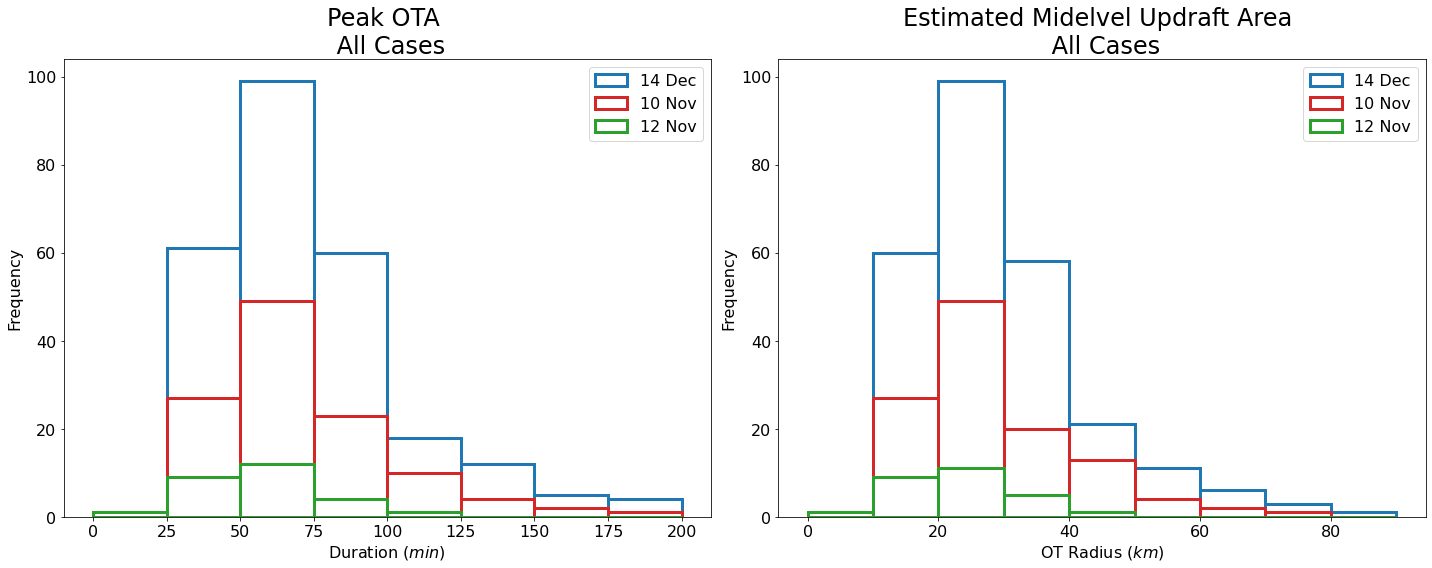
u_core_bins = np.arange(0, 6.25, .25)
ua_bins = np.arange(0, 100, 10)
otw_bins = np.arange(0, 10.5, .5)
fig = plt.figure(figsize=(20,8))
ax = plt.subplot(121)
ax.hist(dec_14_max.area_polygon, ota_bins, label='14 Dec', color='white',
edgecolor='tab:blue', linewidth=3)
ax.hist(nov_10_max.area_polygon, ota_bins, label='10 Nov', color='white',
edgecolor='tab:red', linewidth=3)
ax.hist(nov_12_max.area_polygon, ota_bins, label='12 Nov', color='white',
edgecolor='tab:green', linewidth=3)
plt.title('Peak OTA \n All Cases', fontsize=24)
plt.xlabel('OTA ($km^2$)', fontsize=16)
plt.ylabel('Frequency', fontsize=16)
plt.xticks(fontsize=16)
plt.yticks(fontsize=16)
plt.legend(loc='upper right', fontsize=16)
ax2 = plt.subplot(122)
#plt.hist(df_max.area_polygon * 0.4032)
ax2.hist((dec_14_max.area_polygon* 0.4032), ua_bins, label='14 Dec', color='white',
edgecolor='tab:blue', linewidth=3)
ax2.hist((nov_10_max.area_polygon * 0.4032), ua_bins, label='10 Nov', color='white',
edgecolor='tab:red', linewidth=3)
ax2.hist((nov_12_max.area_polygon * 0.4032), ua_bins, label='12 Nov', color='white',
edgecolor='tab:green', linewidth=3)
plt.title('Estimated Midlevel Updraft Area \n All Cases', fontsize=24)
plt.xlabel('Midlevel Updraft Area ($km^2$)', fontsize=16)
plt.ylabel('Frequency', fontsize=16)
plt.xticks(fontsize=16)
plt.yticks(fontsize=16)
plt.legend(loc='upper right', fontsize=16)
plt.tight_layout()
plt.savefig('OTA_Radius.png', dpi=300)
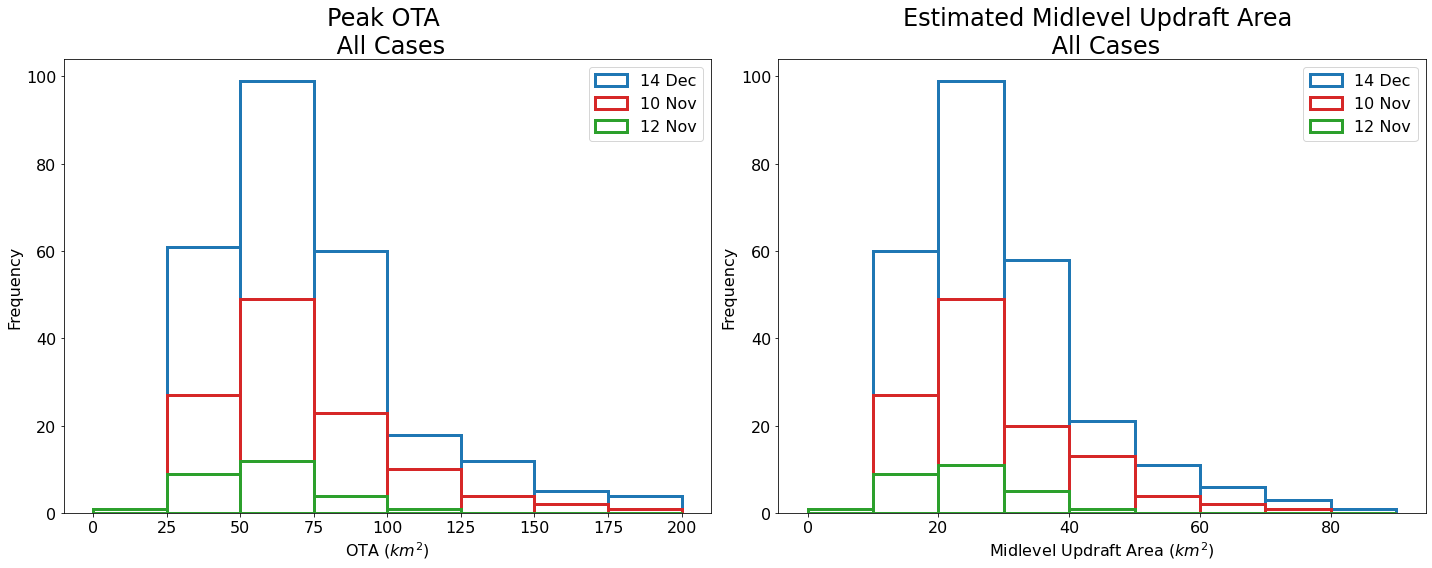
ota_ua_scale = 0.4032
u_core_bins = np.arange(0, 6.25, .25)
ua_bins = np.arange(0, 100, 10)
otw_bins = np.arange(0, 10.5, .5)
fig = plt.figure(figsize=(20,8))
ax = plt.subplot(121)
ax.hist(dec_14_max.duration, dur_bins, label='14 Dec', color='white',
edgecolor='tab:blue', linewidth=3)
ax.hist(nov_10_max.duration, dur_bins, label='10 Nov', color='white',
edgecolor='tab:red', linewidth=3)
ax.hist(nov_12_max.duration, dur_bins, label='12 Nov', color='white',
edgecolor='tab:green', linewidth=3)
plt.title('OT Duration \n All Cases', fontsize=24)
plt.xlabel('Duration ($min$)', fontsize=16)
plt.ylabel('Frequency', fontsize=16)
plt.xticks(fontsize=16)
plt.yticks(fontsize=16)
plt.legend(loc='upper right', fontsize=16)
ax2 = plt.subplot(122)
#plt.hist(df_max.area_polygon * 0.4032)
ax2.hist(calc_r(dec_14_max.area_polygon,ota_ua_scale), otw_bins, label='14 Dec', color='white',
edgecolor='tab:blue', linewidth=3)
ax2.hist(calc_r(nov_10_max.area_polygon,ota_ua_scale), otw_bins, label='10 Nov', color='white',
edgecolor='tab:red', linewidth=3)
ax2.hist(calc_r(nov_12_max.area_polygon,ota_ua_scale), otw_bins, label='12 Nov', color='white',
edgecolor='tab:green', linewidth=3)
plt.xlim(0, 8)
plt.title('OT Effective Radius \n All Cases', fontsize=24)
plt.xlabel('OT Radius ($km$)', fontsize=16)
plt.ylabel('Frequency', fontsize=16)
plt.xticks(fontsize=16)
plt.yticks(fontsize=16)
plt.legend(loc='upper right', fontsize=16)
plt.tight_layout()
plt.savefig('OT_Duration_Radius.png', dpi=300)

np.median(df.area_polygon * 0.4032)
19.10004031090206
np.median(df.area_polygon * 0.44)
20.84329795832566
area_bins = np.arange(0, 240, 20)
ua_bins = np.arange(0, 100, 10)
fig = plt.figure(figsize=(20,8))
ax = plt.subplot(121)
ax.hist(dec_14.area_polygon, area_bins, label='14 Dec')
ax.hist(nov_10.area_polygon, area_bins, label='10 Nov')
ax.hist(nov_12.area_polygon, area_bins, label='12 Nov')
plt.title('OT Area \n All Cases', fontsize=24)
plt.xlabel('OTA ($km^2$)', fontsize=16)
plt.ylabel('Frequency', fontsize=16)
plt.xticks(fontsize=16)
plt.yticks(fontsize=16)
plt.legend(loc='upper right', fontsize=16)
ax2 = plt.subplot(122)
#plt.hist(df_max.area_polygon * 0.4032)
ax2.hist(dec_14.area_polygon * 0.4032, ua_bins, label='14 Dec')
ax2.hist(nov_10.area_polygon * 0.4032, ua_bins, label='10 Nov')
ax2.hist(nov_12.area_polygon * 0.4032, ua_bins, label='12 Nov')
plt.title('Estimated Midlevel Updraft Area \n All Cases', fontsize=24)
plt.xlabel('Midlevel Updraft Area($km^2$)', fontsize=16)
plt.ylabel('Frequency', fontsize=16)
plt.xticks(fontsize=16)
plt.yticks(fontsize=16)
plt.legend(loc='upper right', fontsize=16)
plt.tight_layout()
plt.savefig('ota_updraft_area.png', dpi=300)
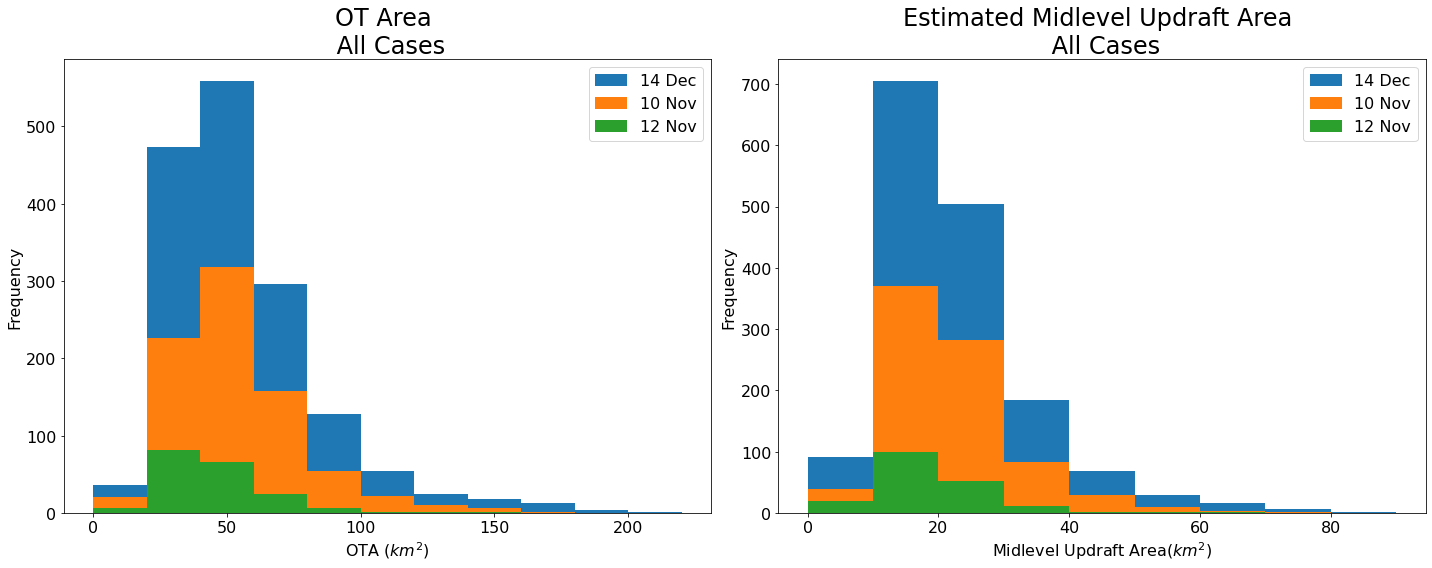
### NEW METHOD - using max ua and max ota from each case --> scaling from there (subsitute 0.44 for scaling factor now)
area_bins = np.arange(0, 240, 20)
ua_bins = np.arange(0, 100, 10)
fig = plt.figure(figsize=(20,8))
ax = plt.subplot(121)
ax.hist(dec_14.area_polygon, area_bins, label='14 Dec')
ax.hist(nov_10.area_polygon, area_bins, label='10 Nov')
ax.hist(nov_12.area_polygon, area_bins, label='12 Nov')
plt.title('OT Area \n All Cases', fontsize=24)
plt.xlabel('OTA ($km^2$)', fontsize=16)
plt.ylabel('Frequency', fontsize=16)
plt.xticks(fontsize=16)
plt.yticks(fontsize=16)
plt.legend(loc='upper right', fontsize=16)
ax2 = plt.subplot(122)
#plt.hist(df_max.area_polygon * 0.4032)
ax2.hist(dec_14.area_polygon * 0.44, ua_bins, label='14 Dec')
ax2.hist(nov_10.area_polygon * 0.44, ua_bins, label='10 Nov')
ax2.hist(nov_12.area_polygon * 0.44, ua_bins, label='12 Nov')
plt.title('Estimated Midlevel Updraft Area \n All Cases', fontsize=24)
plt.xlabel('Midlevel Updraft Area($km^2$)', fontsize=16)
plt.ylabel('Frequency', fontsize=16)
plt.xticks(fontsize=16)
plt.yticks(fontsize=16)
plt.legend(loc='upper right', fontsize=16)
plt.tight_layout()
plt.savefig('ota_updraft_area.png', dpi=300)
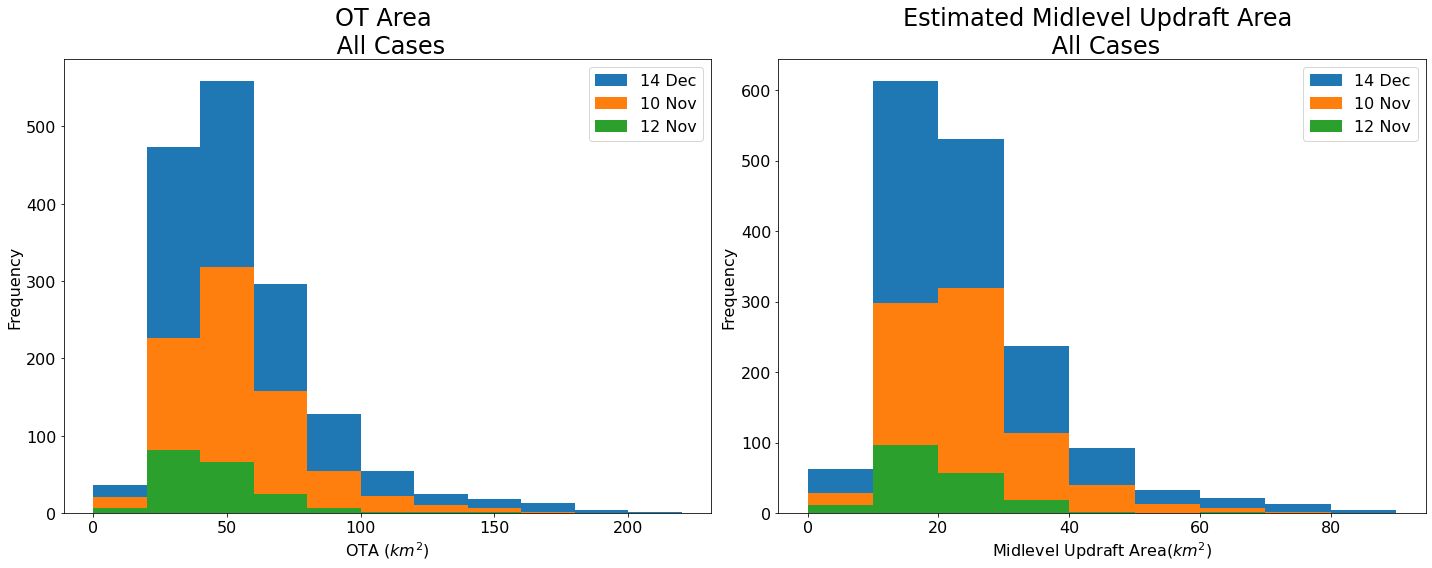
np.median(calc_r(df.area_polygon, 0.44))
2.5760505730140073
depth_bins = np.arange(0, 4.25, .25)
fig = plt.figure(figsize=(20,8))
ax = plt.subplot(121)
ax.hist(dec_14.ot_depth, depth_bins, label='14 Dec')
ax.hist(nov_10.ot_depth, depth_bins, label='10 Nov')
ax.hist(nov_12.ot_depth, depth_bins, label='12 Nov')
plt.title('OT Depth \n All Cases', fontsize=24)
plt.xlabel('OT Depth ($km$)', fontsize=16)
plt.ylabel('Frequency', fontsize=16)
plt.xticks(fontsize=16)
plt.yticks(fontsize=16)
plt.legend(loc='upper right', fontsize=16)
ax = plt.subplot(122)
ax.hist(calc_r(dec_14.area_polygon, 0.44), u_core_bins, label='14 Dec')
ax.hist(calc_r(nov_10.area_polygon, 0.44), u_core_bins, label='10 Nov')
ax.hist(calc_r(nov_12.area_polygon, 0.44), u_core_bins, label='12 Nov')
plt.title('Estimated Updraft Radius \n All Cases', fontsize=24)
plt.xlabel('Updraft Core Radius ($km$)', fontsize=16)
plt.ylabel('Frequency', fontsize=16)
plt.xticks(fontsize=16)
plt.yticks(fontsize=16)
plt.legend(loc='upper right', fontsize=16)
plt.tight_layout()
plt.savefig('ot_depth_radius', dpi=300)
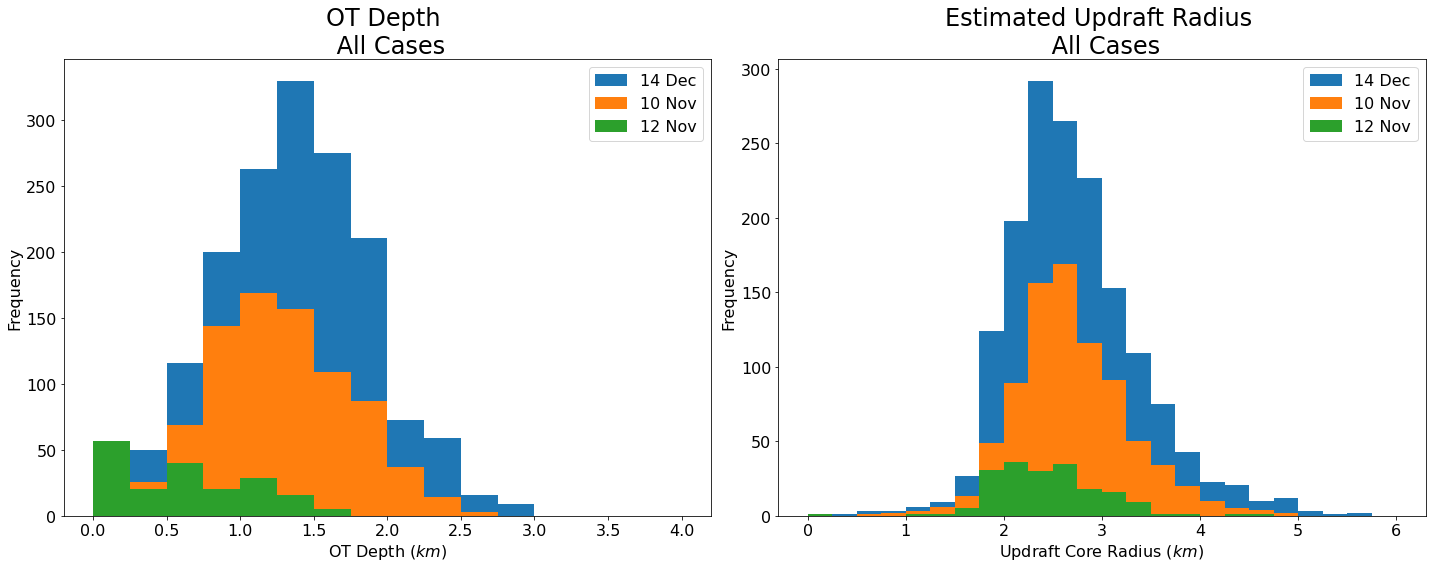
plt.figure(figsize=(10,8))
ax = plt.subplot(111)
ax.hist(df.mid_ur_50, u_core_bins, label='Updraft Core ($50^{th}$ percentile)')
ax.hist(df.mid_ur_60, u_core_bins, label='Updraft Core ($60^{th}$ percentile)')
ax.hist(df.mid_ur_70, u_core_bins, label='Updraft Core ($70^{th}$ percentile)')
ax.hist(df.mid_ur_80, u_core_bins, label='Updraft Core ($80^{th}$ percentile)')
ax.hist(df.mid_ur_90, u_core_bins, label='Updraft Core ($90^{th}$ percentile)')
ax.hist(df.mid_ur_95, u_core_bins, label='Updraft Core ($95^{th}$ percentile)')
plt.title('Estimated Updraft Radius \n All Cases', fontsize=24)
plt.xlabel('Updraft Core Radius ($km$)', fontsize=16)
plt.ylabel('Frequency', fontsize=16)
plt.xticks(fontsize=16)
plt.yticks(fontsize=16)
plt.legend(loc='upper right', fontsize=16)
plt.tight_layout()
plt.savefig('threshold_test_radii.png', dpi=300)
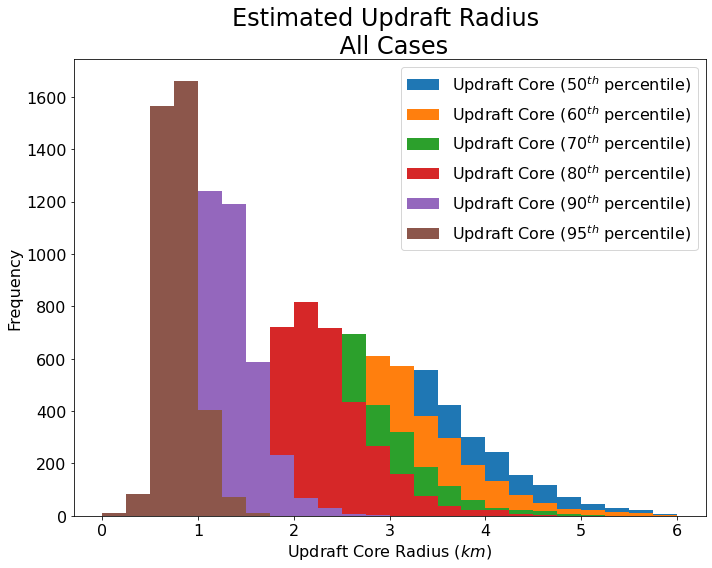
np.median(df.est_wmax)
41.76545649337769
np.nanpercentile(dec_14.est_wmax, 50)
47.2942793579101
np.median(df.est_wmax * 0.386)
16.121478808605172
wmax_bins = np.arange(0, 80, 10)
wmean_bins = np.arange(0,35,5)
fig = plt.figure(figsize=(20,8))
ax = plt.subplot(121)
ax.hist(dec_14.ot_depth * 22.78, wmax_bins, label='14 Dec')
ax.hist(nov_10.ot_depth * 22.78, wmax_bins, label='10 Nov')
ax.hist(nov_12.ot_depth * 22.78, wmax_bins, label='12 Nov')
plt.title('Estimated Midlevel $W_{max}$ \n All Cases', fontsize=24)
plt.xlabel('$W_{max}$ ($m/s$)', fontsize=16)
plt.ylabel('Frequency', fontsize=16)
plt.xticks(fontsize=16)
plt.yticks(fontsize=16)
plt.legend(loc='upper right', fontsize=16)
ax = plt.subplot(122)
ax.hist(dec_14.ot_depth * 8.89, wmean_bins, label='14 Dec')
ax.hist(nov_10.ot_depth * 8.89, wmean_bins, label='10 Nov')
ax.hist(nov_12.ot_depth * 8.89, wmean_bins, label='12 Nov')
plt.title('Estimated Midlevel $W_{mean}$ \n All Cases', fontsize=24)
plt.xlabel('$W_{mean}$ ($m/s$)', fontsize=16)
plt.ylabel('Frequency', fontsize=16)
plt.xticks(fontsize=16)
plt.yticks(fontsize=16)
plt.legend(loc='upper right', fontsize=16)
plt.tight_layout()
plt.savefig('Estimated_wmax_wmean.png', dpi=300)
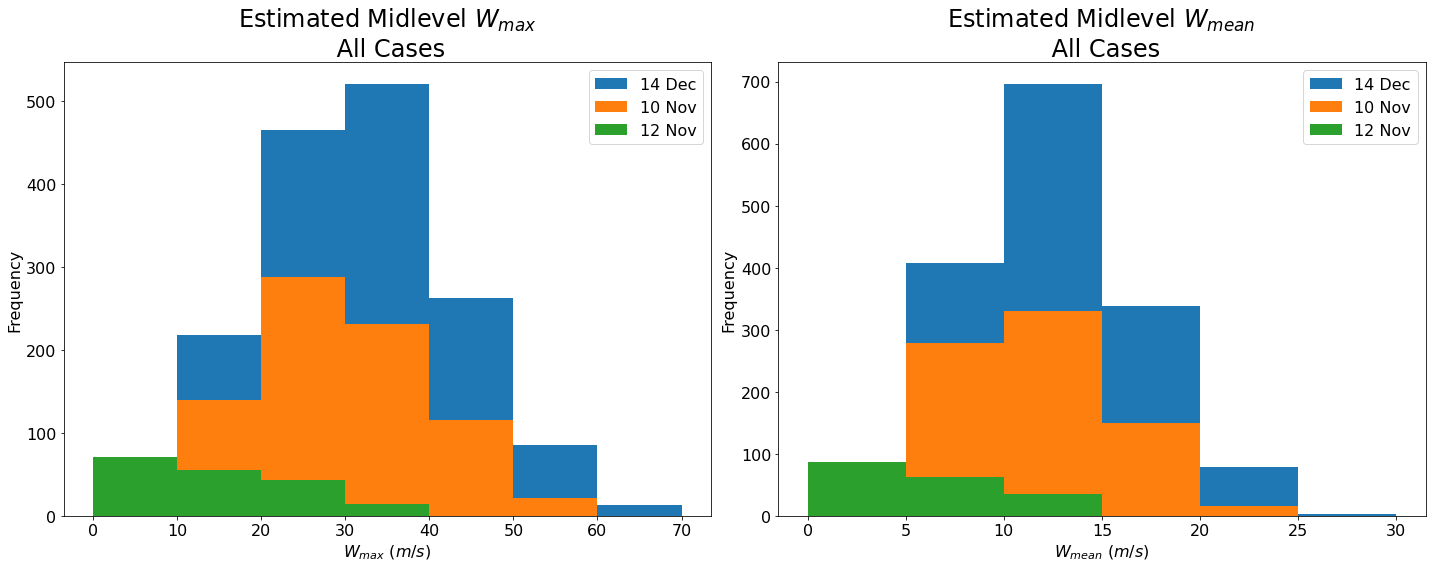
np.median(df.ot_depth * 8.89)
10.845793895721421
np.median(dec_14.est_wmax * 0.386)
18.2555918321533
np.median(df.ot_depth * wmean_scale)
10.857993888854981
wmax_scale = 22.8
wmean_scale = 8.9
wmax_bins = np.arange(0, 90, 5)
wmean_bins = np.arange(0,50,5)
fig = plt.figure(figsize=(20,8))
ax = plt.subplot(121)
ax.hist(dec_14.ot_depth * wmax_scale, wmax_bins, label='14 Dec',
color='white', edgecolor='tab:blue', linewidth=3)
ax.hist(nov_10.ot_depth * wmax_scale, wmax_bins, label='10 Nov',
color='white', edgecolor='tab:red', linewidth=3)
ax.hist(nov_12.ot_depth * wmax_scale, wmax_bins, label='12 Nov',
color='white', edgecolor='tab:green', linewidth=3)
plt.title('Estimated Midlevel $W_{max}$ \n All Cases', fontsize=24)
plt.xlabel('$W_{max}$ ($ms^-1$)', fontsize=16)
plt.ylabel('Frequency', fontsize=16)
plt.xticks(fontsize=16)
plt.yticks(fontsize=16)
plt.legend(loc='upper right', fontsize=16)
ax = plt.subplot(122)
ax.hist(dec_14.ot_depth * wmean_scale, wmean_bins, label='14 Dec',
color='white', edgecolor='tab:blue', linewidth=3)
ax.hist(nov_10.ot_depth * wmean_scale, wmean_bins, label='10 Nov',
color='white', edgecolor='tab:red', linewidth=3)
ax.hist(nov_12.ot_depth * wmean_scale, wmean_bins, label='12 Nov',
color='white', edgecolor='tab:green', linewidth=3)
plt.title('Estimated Midlevel $W_{mean}$ \n All Cases', fontsize=24)
plt.xlabel('$W_{mean}$ ($ms^-1$)', fontsize=16)
plt.ylabel('Frequency', fontsize=16)
plt.xticks(fontsize=16)
plt.yticks(fontsize=16)
plt.legend(loc='upper right', fontsize=16)
plt.tight_layout()
plt.savefig('Estimated_wmax_wmean.png', dpi=300)
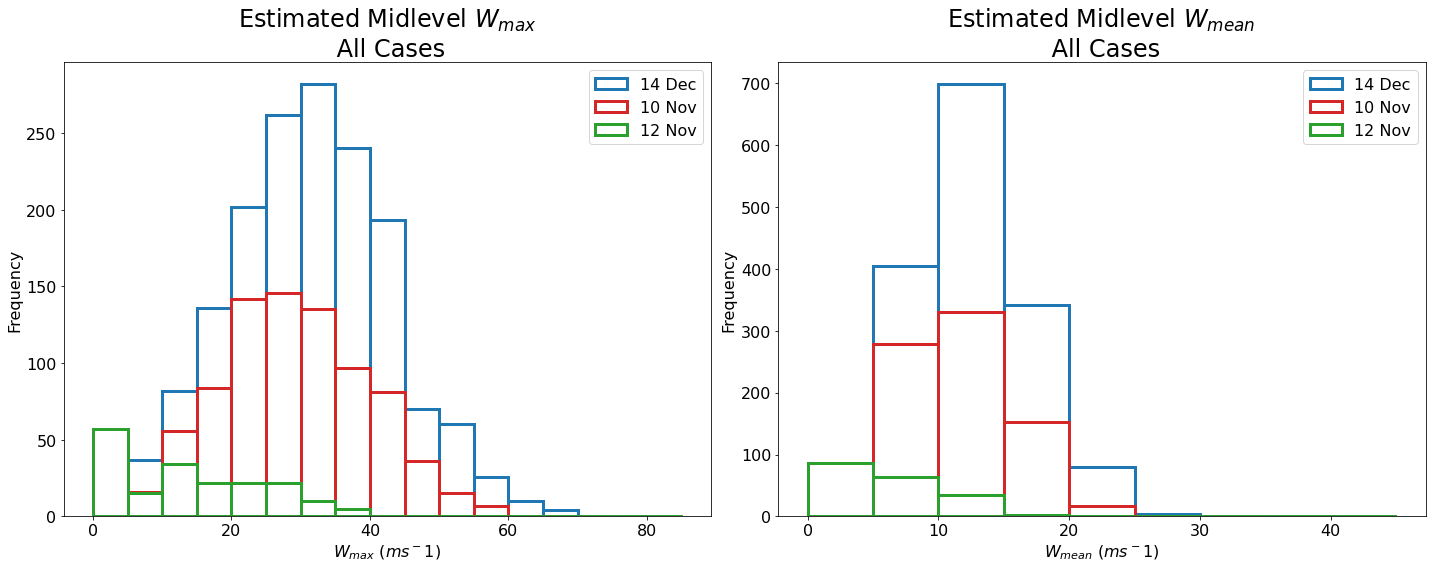
np.max(df.ot_depth * wmax_scale)
71.16473251342774
np.sqrt(2 * 2900)
76.15773105863909
u_core_bins = np.arange(0, 6.25, .25)
ua_bins = np.arange(0, 100, 10)
fig = plt.figure(figsize=(20,8))
ax = plt.subplot(121)
ax.hist(calc_r(dec_14.area_polygon), u_core_bins, label='14 Dec')
ax.hist(calc_r(nov_10.area_polygon), u_core_bins, label='10 Nov')
ax.hist(calc_r(nov_12.area_polygon), u_core_bins, label='12 Nov')
plt.title('Estimated Updraft Radius \n All Cases', fontsize=24)
plt.xlabel('Updraft Core Radius ($km$)', fontsize=16)
plt.ylabel('Frequency', fontsize=16)
plt.xticks(fontsize=16)
plt.yticks(fontsize=16)
plt.legend(loc='upper right', fontsize=16)
ax2 = plt.subplot(122)
#plt.hist(df_max.area_polygon * 0.4032)
ax2.hist(dec_14.area_polygon * 0.4032, ua_bins, label='14 Dec')
ax2.hist(nov_10.area_polygon * 0.4032, ua_bins, label='10 Nov')
ax2.hist(nov_12.area_polygon * 0.4032, ua_bins, label='12 Nov')
plt.title('Estimated Updraft Area \n All Cases', fontsize=24)
plt.xlabel('Updraft Core Area($km^2$)', fontsize=16)
plt.ylabel('Frequency', fontsize=16)
plt.xticks(fontsize=16)
plt.yticks(fontsize=16)
plt.legend(loc='upper right', fontsize=16)
plt.savefig('Updraft_Radius_Area.png', dpi=400)
wmax_bins = np.arange(0, 105, 5)
df.est_wmax.plot.hist(bins=wmax_bins)
<AxesSubplot:ylabel='Frequency'>
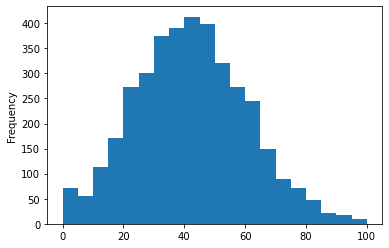
plt.figure(figsize=(10,8))
bins = np.arange(0, 10.25, .25)
df.mid_ud.plot.hist(bins=bins)
<AxesSubplot:ylabel='Frequency'>
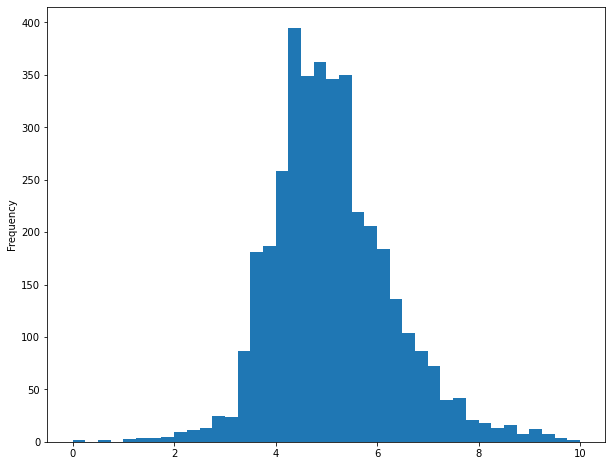
df['est_wmax'] = df.ot_depth * 34.238
/data/keeling/a/mgrover4/a/miniconda3/envs/xesmf_env/lib/python3.7/site-packages/ipykernel_launcher.py:1: SettingWithCopyWarning:
A value is trying to be set on a copy of a slice from a DataFrame.
Try using .loc[row_indexer,col_indexer] = value instead
See the caveats in the documentation: https://pandas.pydata.org/pandas-docs/stable/user_guide/indexing.html#returning-a-view-versus-a-copy
"""Entry point for launching an IPython kernel.
df.est_wmax.plot.hist()
<AxesSubplot:ylabel='Frequency'>
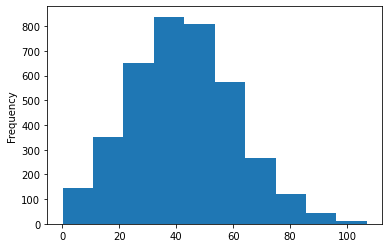
df['lat_rounded'] = np.round(df.lat, 0)
df['lon_rounded'] = np.round(df.lon, 0)
/data/keeling/a/mgrover4/a/miniconda3/envs/xesmf_env/lib/python3.7/site-packages/ipykernel_launcher.py:1: SettingWithCopyWarning:
A value is trying to be set on a copy of a slice from a DataFrame.
Try using .loc[row_indexer,col_indexer] = value instead
See the caveats in the documentation: https://pandas.pydata.org/pandas-docs/stable/user_guide/indexing.html#returning-a-view-versus-a-copy
"""Entry point for launching an IPython kernel.
/data/keeling/a/mgrover4/a/miniconda3/envs/xesmf_env/lib/python3.7/site-packages/ipykernel_launcher.py:2: SettingWithCopyWarning:
A value is trying to be set on a copy of a slice from a DataFrame.
Try using .loc[row_indexer,col_indexer] = value instead
See the caveats in the documentation: https://pandas.pydata.org/pandas-docs/stable/user_guide/indexing.html#returning-a-view-versus-a-copy
nov_10_all = df[df.day == 10]
nov_12_all = df[df.day == 12]
dec_14_all = df[df.day == 14]
u_core_bins * 2
---------------------------------------------------------------------------
NameError Traceback (most recent call last)
<ipython-input-23-2dd16c05d398> in <module>
----> 1 u_core_bins * 2
NameError: name 'u_core_bins' is not defined
ur = calc_r(nov_10_all.area_polygon)
med = np.median(ur) * 2
top_perc = np.percentile(ur, 95) * 2
fig = plt.figure(figsize=(12,8))
plt.hist(ur * 2, u_core_bins * 2)
plt.axvline(med, color='r', linewidth=3, label=f'Median: {np.round(med,2)} km')
plt.axvline(top_perc, color='b', linewidth=3, label='$95^{th}$' + f' Perc: {np.round(top_perc, 2)} km')
plt.title('OTA Distribution \n All OTs', fontsize=24)
plt.xlabel('Updraft Core Radius ($km$)', fontsize=16)
plt.ylabel('Frequency', fontsize=16)
plt.xticks(fontsize=14)
plt.yticks(fontsize=14)
plt.legend(fontsize=16)
<matplotlib.legend.Legend at 0x2af2f3d18f60>
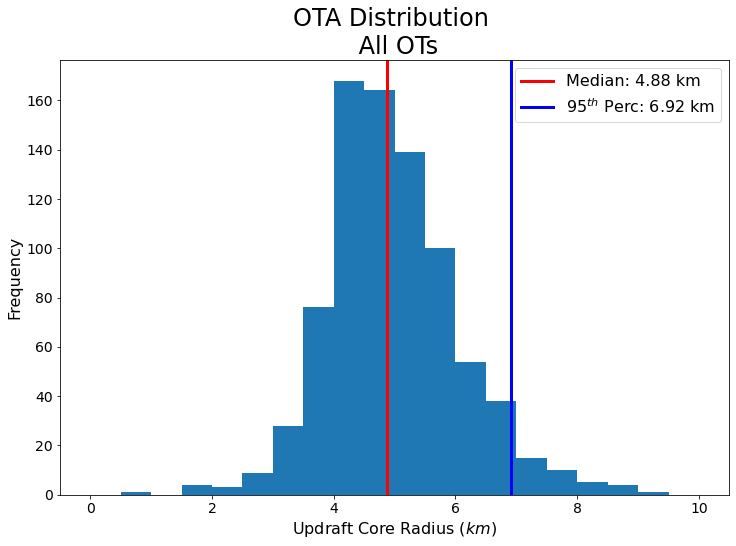
ur = calc_r(nov_12_all.area_polygon)
med = np.median(ur) * 2
top_perc = np.percentile(ur, 95) * 2
fig = plt.figure(figsize=(12,8))
plt.hist(ur * 2, u_core_bins * 2)
plt.axvline(med, color='r', linewidth=3, label=f'Median: {np.round(med,2)} km')
plt.axvline(top_perc, color='b', linewidth=3, label='$95^{th}$' + f' Perc: {np.round(top_perc, 2)} km')
plt.title('OTA Distribution \n All OTs', fontsize=24)
plt.xlabel('Updraft Core Radius ($km$)', fontsize=16)
plt.ylabel('Frequency', fontsize=16)
plt.xticks(fontsize=14)
plt.yticks(fontsize=14)
plt.legend(fontsize=16)
<matplotlib.legend.Legend at 0x2af2f3d4b208>
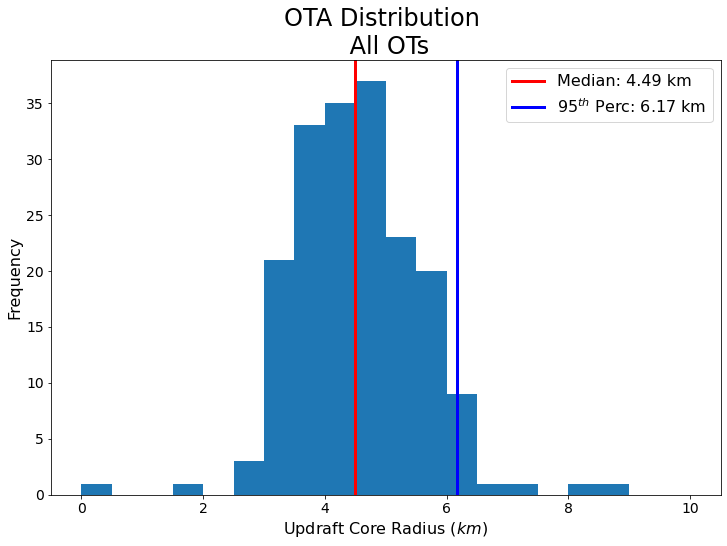
ur = calc_r(dec_14_all.area_polygon)
med = np.median(ur) * 2
top_perc = np.percentile(ur, 95) * 2
fig = plt.figure(figsize=(12,8))
plt.hist(ur * 2, u_core_bins * 2)
plt.axvline(med, color='r', linewidth=3, label=f'Median: {np.round(med,2)} km')
plt.axvline(top_perc, color='b', linewidth=3, label='$95^{th}$' + f' Perc: {np.round(top_perc, 2)} km')
plt.title('OTA Distribution \n All OTs', fontsize=24)
plt.xlabel('Updraft Core Radius ($km$)', fontsize=16)
plt.ylabel('Frequency', fontsize=16)
plt.xticks(fontsize=14)
plt.yticks(fontsize=14)
plt.legend(fontsize=16)
<matplotlib.legend.Legend at 0x2af2f3d8d978>

llcrnr=[-33.206342, -65.906586]
urcrnr=[-30.255825, -62.630553]
# Set extent of maps created in the following cells:
axis_extent=[llcrnr[1],urcrnr[1],llcrnr[0],urcrnr[0]]
# Plot map with all individual tracks:
import cartopy.crs as ccrs
fig_map,ax_map=plt.subplots(figsize=(15,15),subplot_kw={'projection': ccrs.PlateCarree()})
ax_map.coastlines()
ax_map.set_extent(axis_extent)
for ds in ds_list:
# cm = ax.contourf(ds.x.values[::5], ds.y.values[::5], ds.values[::5,::5], levs, cmap='terrain', transform=ccrs.PlateCarree())
cm = ax_map.imshow(ds.values, extent =[ds.x.min(),ds.x.max(),ds.y.min(),ds.y.max()], transform=ccrs.PlateCarree(), vmin=0, vmax=4000, cmap='terrain')
gl = ax_map.gridlines(crs=ccrs.PlateCarree(), draw_labels=True,
linewidth=2, color='gray', alpha=0.5, linestyle='--')
#for name, group in cells_grouped:
# print(group.x,group.y)
# cm2 = plt.scatter(group.lon,group.lat,c=group.area_polygon,vmin=0.,vmax=200.,s=group.area_polygon,
# facecolors='none',cmap='magma',linewidth=0.5)
#plt.colorbar(cm,label='Elevation (m)',shrink=0.4, pad=0.0)
#plt.colorbar(cm2,label='OT Area (km$^2$)',shrink=0.4, pad=0.1)
ax.add_feature(cfeature.STATES, linestyle=":")
plt.axvline(-65, linewidth=3)
plt.axhline(-32, linewidth=3)
ax_map.set_title('Overshooting top tracks\n14 December 2018')
Text(0.5, 1.0, 'Overshooting top tracks\n14 December 2018')
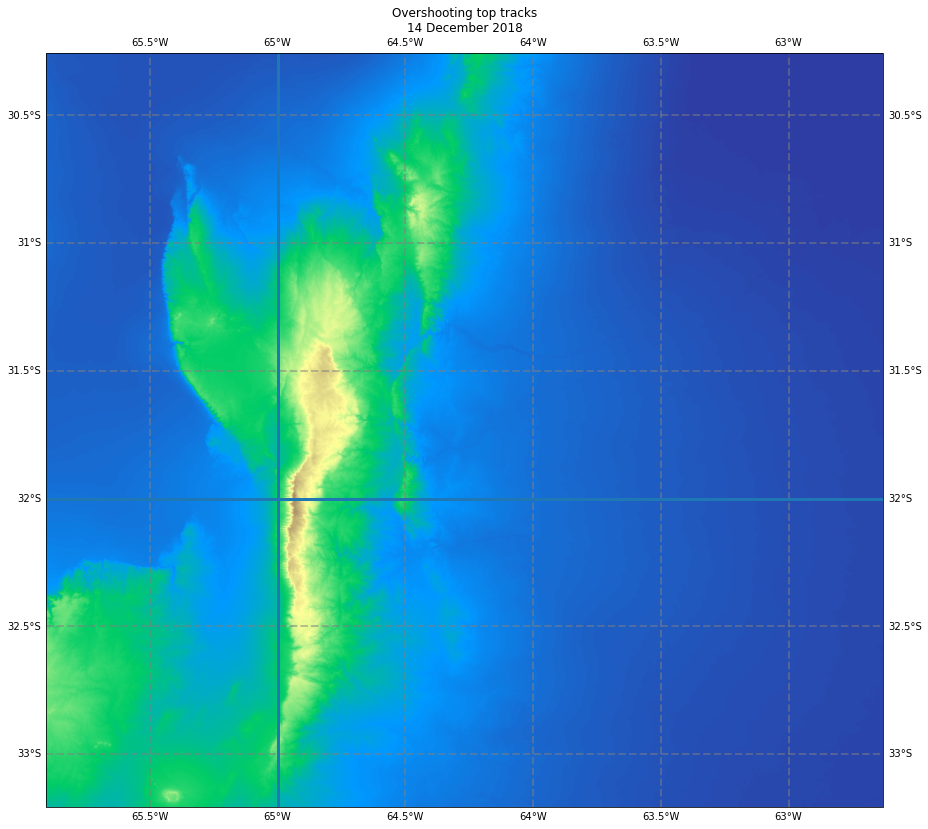
fig = plt.figure(figsize=(12,8))
plt.hist(df.area_polygon, bins=ota_bins)
plt.title('OTA Distribution \n All OTs', fontsize=24)
plt.xlabel('OTA ($km^2$)', fontsize=16)
plt.ylabel('Frequency', fontsize=16)
Text(0, 0.5, 'Frequency')
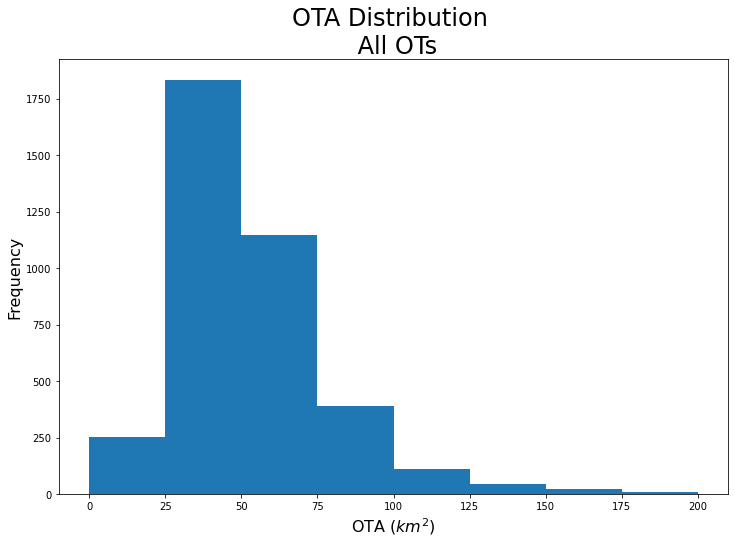
u_core_bins = np.arange(0, 5.25, .25)
np.median(calc_r(df_max.area_polygon)) * 2
5.498395714122815
np.median(calc_r(df.area_polygon)) * 2
4.769737992345483
hist, bins = np.histogram(calc_r(df.area_polygon), bins=10, normed=True)
bin_centers = (bins[1:]+bins[:-1])*0.5
plt.bar(bin_centers, hist)
/data/keeling/a/mgrover4/a/miniconda3/envs/xesmf_env/lib/python3.7/site-packages/ipykernel_launcher.py:1: VisibleDeprecationWarning: Passing `normed=True` on non-uniform bins has always been broken, and computes neither the probability density function nor the probability mass function. The result is only correct if the bins are uniform, when density=True will produce the same result anyway. The argument will be removed in a future version of numpy.
"""Entry point for launching an IPython kernel.
<BarContainer object of 10 artists>
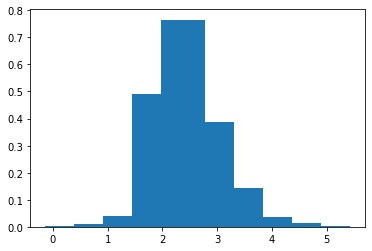
fig = plt.figure(figsize=(12,8))
plt.hist(calc_r(df.area_polygon), u_core_bins)
plt.title('OTA Distribution \n All OTs', fontsize=24)
plt.xlabel('Updraft Core Radius ($km$)', fontsize=16)
plt.ylabel('Frequency', fontsize=16)
Text(0, 0.5, 'Frequency')
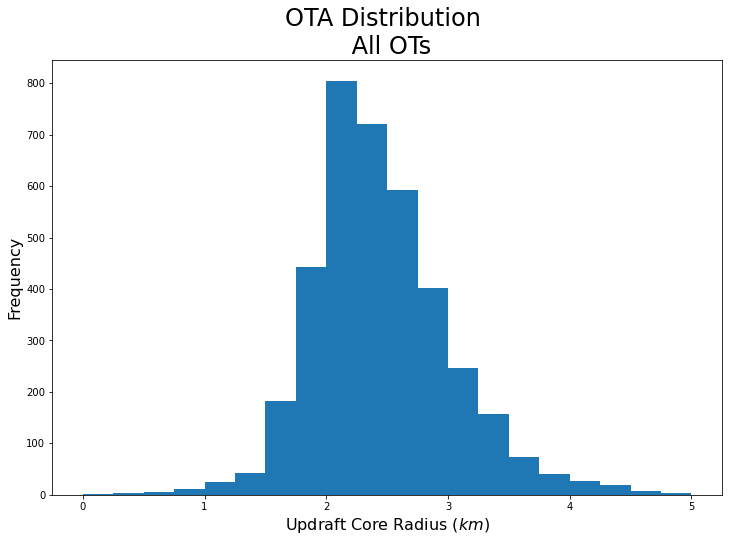
fig = plt.figure(figsize=(12,8))
plt.hist(calc_r(nov_10.area_polygon), u_core_bins)
plt.title('OTA Distribution \n All OTs', fontsize=24)
plt.xlabel('Updraft Core Radius ($km$)', fontsize=16)
plt.ylabel('Frequency', fontsize=16)
Text(0, 0.5, 'Frequency')
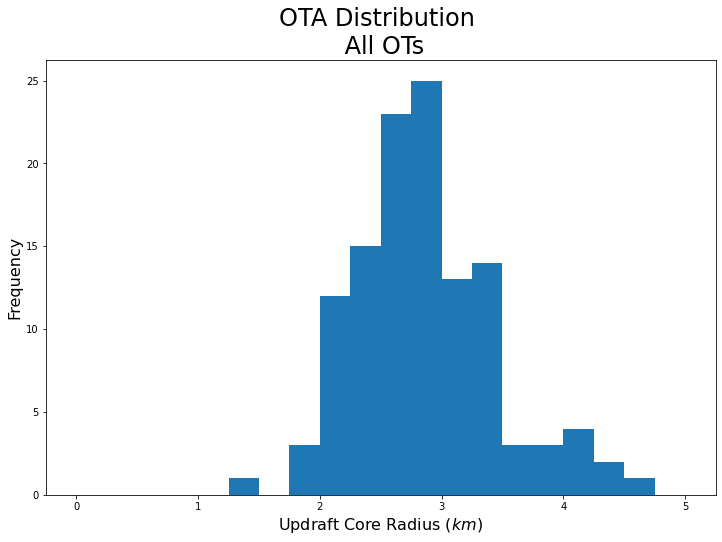
fig = plt.figure(figsize=(12,8))
plt.hist(df_max.area_polygon * 0.4032)
plt.title('Updraft Area Distribution \n All OTs', fontsize=24)
plt.xlabel('Updraft Core Area($km^2$)', fontsize=16)
plt.ylabel('Frequency', fontsize=16)
Text(0, 0.5, 'Frequency')
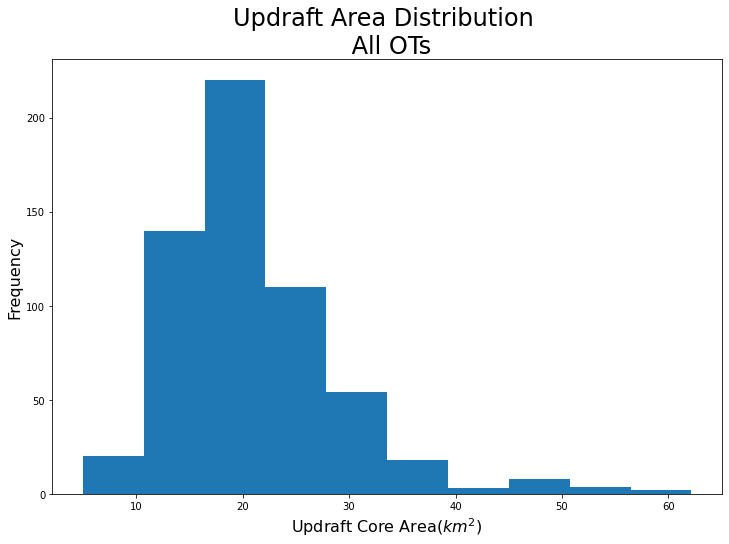
fig = plt.figure(figsize=(12,8))
plt.hist(df_max.area_polygon)
plt.title('OTA Distribution \n All OTs', fontsize=24)
plt.xlabel('OTA ($km^2$)', fontsize=16)
plt.ylabel('Frequency', fontsize=16)
Text(0, 0.5, 'Frequency')
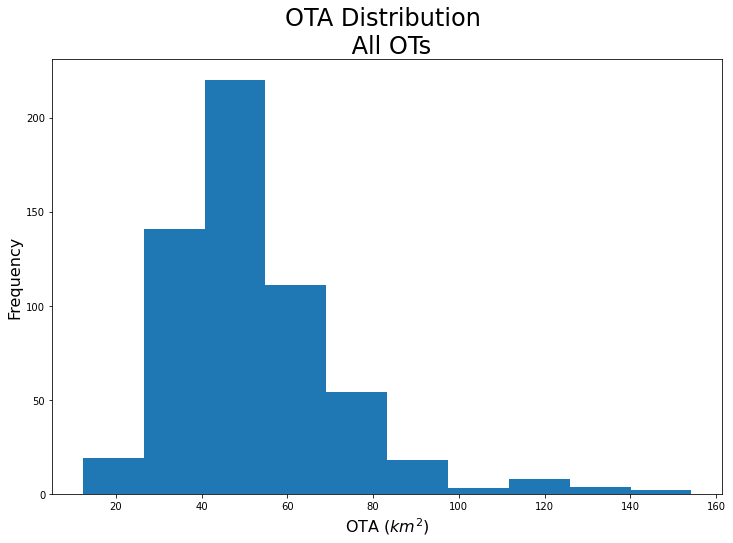
slope, intercept, r, p, stderr = scipy.stats.linregress(df_max.mid_ur, df_max.ot_depth)
line = f'r={r:.2f}'
plt.figure(figsize=(10,8))
ax = plt.subplot(111)
#max_depth_nov_10 = max_depth[max_depth.day == 10]
ax.scatter(dec_14.mid_ur, dec_14.ot_depth, color='tab:blue', label='14 December 2018')
ax.scatter(nov_12.mid_ur, nov_12.ot_depth, color='tab:green', label='12 November 2018')
ax.scatter(nov_10.mid_ur, nov_10.ot_depth, color='tab:red', label='10 November 2018')
ax.scatter(np.median(dec_14.mid_ur), np.median(dec_14.ot_depth), color='blue', s=100)
ax.scatter(np.median(nov_10.mid_ur), np.median(nov_10.ot_depth), color='red', s=100)
ax.scatter(np.median(nov_12.mid_ur), np.median(nov_12.ot_depth), color='green', s=100)
ax.plot(np.array(df_max.mid_ur), intercept + slope * np.array(df_max.mid_ur), label=line, color='black')
plt.xlabel('Midlevel Updraft Radius ($km$)', fontsize=12)
plt.ylabel('OT Depth $(km)$', fontsize=12)
plt.legend(loc='upper right', fontsize=12)
plt.title('OT Duration All OTs \n 10 November, 12 November, 14 December 2018 UTC (Count = 1022)', fontsize=16)
---------------------------------------------------------------------------
AttributeError Traceback (most recent call last)
<ipython-input-102-decea871942b> in <module>
----> 1 slope, intercept, r, p, stderr = scipy.stats.linregress(df_max.mid_ur, df_max.ot_depth)
2
3 line = f'r={r:.2f}'
4
5 plt.figure(figsize=(10,8))
~/a/miniconda3/envs/xesmf_env/lib/python3.7/site-packages/pandas/core/generic.py in __getattr__(self, name)
5139 if self._info_axis._can_hold_identifiers_and_holds_name(name):
5140 return self[name]
-> 5141 return object.__getattribute__(self, name)
5142
5143 def __setattr__(self, name: str, value) -> None:
AttributeError: 'DataFrame' object has no attribute 'mid_ur'
plt.figure(figsize=(10,8))
ax = plt.subplot(111)
#max_depth_nov_10 = max_depth[max_depth.day == 10]
ax.scatter(dec_14.mid_ur, dec_14.duration, color='tab:blue', label='14 December 2018')
ax.scatter(nov_12.mid_ur, nov_12.duration, color='tab:green', label='12 November 2018')
ax.scatter(nov_10.mid_ur, nov_10.duration, color='tab:red', label='10 November 2018')
ax.scatter(np.mean(dec_14.mid_ur), np.mean(dec_14.duration), color='blue', s=100)
ax.scatter(np.mean(nov_10.mid_ur), np.mean(nov_10.duration), color='red', s=100)
ax.scatter(np.mean(nov_12.mid_ur), np.mean(nov_12.duration), color='green', s=100)
#ax.plot(np.array(df_max.mid_ur), intercept + slope * np.array(df_max.mid_ur), label=line, color='black')
plt.xlabel('Estimated Midlevel \n Updraft Radius ($km$)', fontsize=12)
plt.ylabel('OT Duration $(km)$', fontsize=12)
plt.legend(loc='upper right', fontsize=12)
plt.xlim(0,5)
plt.ylim(2,16)
plt.title('OT Duration All OTs \n 10 November, 12 November, 14 December 2018 UTC (Count = 1022)', fontsize=16)
Text(0.5, 1.0, 'OT Duration All OTs \n 10 November, 12 November, 14 December 2018 UTC (Count = 1022)')
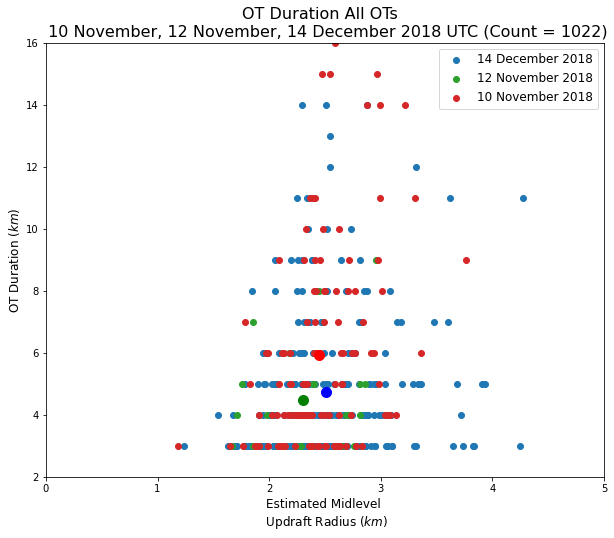
plt.scatter(df_max.ot_depth, df_max.mid_ur)
<matplotlib.collections.PathCollection at 0x2b5e68d12cf8>
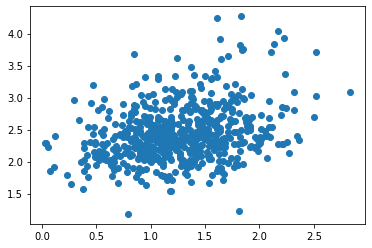
uar_dec14 = calc_r(dec_14.area_polygon)
uar_nov10 = calc_r(nov_10.area_polygon)
uar_nov12 = calc_r(nov_10.area_polygon)
ota = df_max.area_polygon
u_r = calc_r(ota)
ot_r = calc_r(ota, 1)
np.percentile(u_r, 90)
3.0136419031378203
slope, intercept, r, p, stderr = scipy.stats.linregress(u_r, df_max.ot_depth)
df_max['u_diam'] = np.round(u_r* 2, 0)
df_max['round_area'] = np.round(df_max.area_polygon, -1)
fig = plt.figure(figsize=(12,8))
ax = plt.subplot(111)
df_max.boxplot('ot_depth', by='u_diam', ax=ax)
<AxesSubplot:title={'center':'ot_depth'}, xlabel='u_diam'>
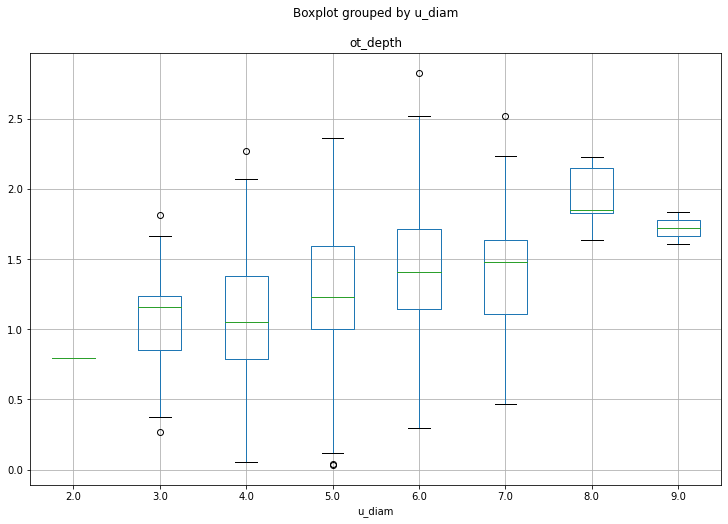
plt.scatter(u_r, df_max.ot_depth)
<matplotlib.collections.PathCollection at 0x2b56fb31a240>
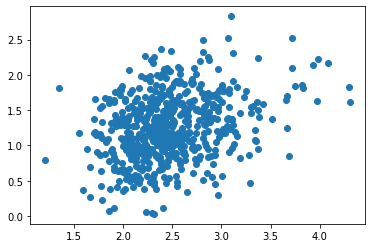
np.median(calc_r(dec_14.area_polygon)) * 2
4.894120115882311
np.median(calc_r(dec_14.area_polygon))
2.4470600579411554
mean_nov10 = np.mean(calc_r(nov_10.area_polygon) * 2)
mean_nov12 = np.mean(calc_r(nov_12.area_polygon) * 2)
mean_dec14 = np.mean(calc_r(dec_14.area_polygon) * 2)
std_nov10 = np.std(calc_r(nov_10.area_polygon) * 2)
std_nov12 = np.std(calc_r(nov_12.area_polygon) * 2)
std_dec14 = np.std(calc_r(dec_14.area_polygon) * 2)
plt.bar('Nov 10', mean_nov10)
plt.bar('Nov 12', mean_nov12)
plt.bar('Dec 14', mean_nov12)
plt.ylim(4,6)
(4.0, 6.0)
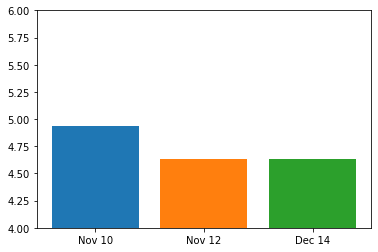
plt.hist(calc_r(nov_12.area_polygon), u_core_bins, label='12 Nov')
(array([0., 0., 0., 0., 0., 0., 2., 6., 4., 7., 3., 5., 0., 0., 0., 0., 0.,
0., 0., 0.]),
array([0. , 0.25, 0.5 , 0.75, 1. , 1.25, 1.5 , 1.75, 2. , 2.25, 2.5 ,
2.75, 3. , 3.25, 3.5 , 3.75, 4. , 4.25, 4.5 , 4.75, 5. ]),
<BarContainer object of 20 artists>)
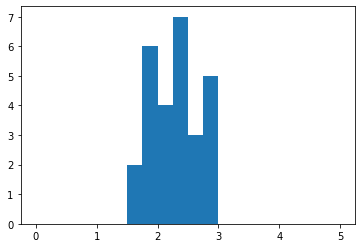
plt.hist(calc_r(nov_10.area_polygon), u_core_bins, label='12 Nov')
(array([ 0., 0., 0., 0., 1., 0., 1., 11., 19., 35., 28., 10., 10.,
3., 0., 1., 0., 0., 0., 0.]),
array([0. , 0.25, 0.5 , 0.75, 1. , 1.25, 1.5 , 1.75, 2. , 2.25, 2.5 ,
2.75, 3. , 3.25, 3.5 , 3.75, 4. , 4.25, 4.5 , 4.75, 5. ]),
<BarContainer object of 20 artists>)
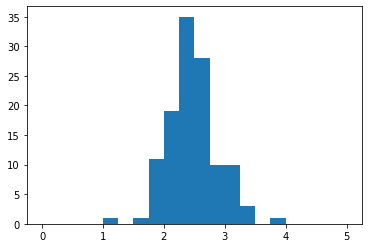
plt.hist(calc_r(dec_14.area_polygon), u_core_bins, label='14 Dec')
(array([ 0., 0., 0., 0., 0., 1., 5., 22., 42., 68., 49., 35., 15.,
7., 6., 5., 0., 2., 0., 0.]),
array([0. , 0.25, 0.5 , 0.75, 1. , 1.25, 1.5 , 1.75, 2. , 2.25, 2.5 ,
2.75, 3. , 3.25, 3.5 , 3.75, 4. , 4.25, 4.5 , 4.75, 5. ]),
<BarContainer object of 20 artists>)

ot_core_bins = np.arange(0, 10, .25)
fig = plt.figure(figsize=(20,8))
ax = plt.subplot(121)
ax.hist(calc_r(dec_14.area_polygon, 1), ot_core_bins, label='14 Dec')
ax.hist(calc_r(nov_10.area_polygon, 1), ot_core_bins, label='10 Nov')
ax.hist(calc_r(nov_12.area_polygon, 1), ot_core_bins, label='12 Nov')
plt.title('OT Effective Radius \n All Cases', fontsize=24)
plt.xlabel('OT Radius ($km$)', fontsize=16)
plt.ylabel('Frequency', fontsize=16)
plt.xticks(fontsize=16)
plt.yticks(fontsize=16)
plt.legend(loc='upper right', fontsize=16)
ax2 = plt.subplot(122)
#plt.hist(df_max.area_polygon * 0.4032)
ax2.hist(dec_14.area_polygon, bins=ota_bins, label='14 Dec')
ax2.hist(nov_10.area_polygon, bins=ota_bins, label='10 Nov')
ax2.hist(nov_12.area_polygon, bins=ota_bins, label='12 Nov')
plt.title('OTA \n All Cases', fontsize=24)
plt.xlabel('OTA ($km^2$)', fontsize=16)
plt.ylabel('Frequency', fontsize=16)
plt.xticks(fontsize=16)
plt.yticks(fontsize=16)
plt.legend(loc='upper right', fontsize=16)
plt.savefig('OT_Radius_Duration.png', dpi=400)
---------------------------------------------------------------------------
NameError Traceback (most recent call last)
<ipython-input-33-25ad375b8cf8> in <module>
2
3 ax = plt.subplot(121)
----> 4 ax.hist(calc_r(dec_14.area_polygon, 1), ot_core_bins, label='14 Dec')
5 ax.hist(calc_r(nov_10.area_polygon, 1), ot_core_bins, label='10 Nov')
6 ax.hist(calc_r(nov_12.area_polygon, 1), ot_core_bins, label='12 Nov')
NameError: name 'ot_core_bins' is not defined
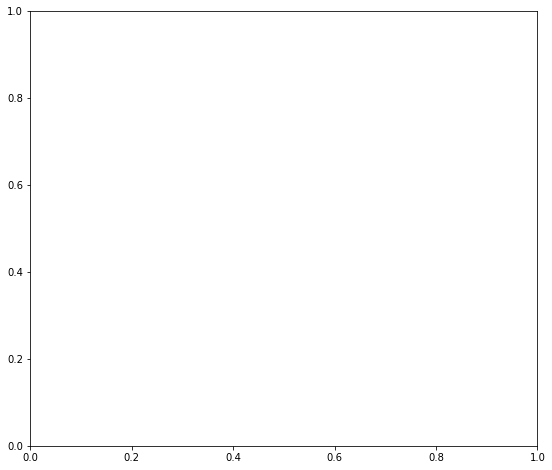
fig = plt.figure(figsize=(20,8))
ax = plt.subplot(121)
ax.hist(calc_r(df_max.area_polygon, 1), ot_core_bins, label='14 Dec')
plt.title('OT Effective Radius \n All Cases', fontsize=24)
plt.xlabel('OT Radius ($km$)', fontsize=16)
plt.ylabel('Frequency', fontsize=16)
plt.xticks(fontsize=16)
plt.yticks(fontsize=16)
#plt.legend(loc='upper right', fontsize=16)
ax2 = plt.subplot(122)
#plt.hist(df_max.area_polygon * 0.4032)
ax2.hist(df_max.area_polygon, bins=ota_bins, label='14 Dec')
plt.title('OTA \n All Cases', fontsize=24)
plt.xlabel('OTA ($km^2$)', fontsize=16)
plt.ylabel('Frequency', fontsize=16)
plt.xticks(fontsize=16)
plt.yticks(fontsize=16)
#plt.legend(loc='upper right', fontsize=16)
plt.savefig('OT_Radius_Duration.png', dpi=400)
---------------------------------------------------------------------------
NameError Traceback (most recent call last)
<ipython-input-14-d85d0451eb01> in <module>
2
3 ax = plt.subplot(121)
----> 4 ax.hist(calc_r(df_max.area_polygon, 1), ot_core_bins, label='14 Dec')
5
6
NameError: name 'calc_r' is not defined
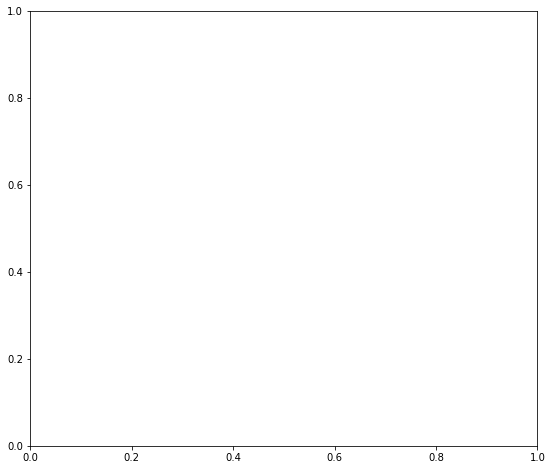
nov_10 = df[df.day == 10]
nov_12 = df[df.day == 12]
dec_14 = df[df.day == 14]
nov_10_mean = nov_10.groupby('cell').mean()
nov_12_mean = nov_12.groupby('cell').mean()
dec_14_mean = dec_14.groupby('cell').mean()
nov_10_max = nov_10.groupby('cell').max()
nov_12_max = nov_12.groupby('cell').max()
dec_14_max = dec_14.groupby('cell').max()
u_core_bins = np.arange(0, 6.25, .25)
ua_bins = np.arange(0, 100, 10)
fig = plt.figure(figsize=(20,8))
ax = plt.subplot(121)
ax.hist(calc_r(dec_14.area_polygon), u_core_bins, label='14 Dec')
ax.hist(calc_r(nov_10.area_polygon), u_core_bins, label='10 Nov')
ax.hist(calc_r(nov_12.area_polygon), u_core_bins, label='12 Nov')
plt.title('Estimated Updraft Radius \n All Cases', fontsize=24)
plt.xlabel('Updraft Core Radius ($km$)', fontsize=16)
plt.ylabel('Frequency', fontsize=16)
plt.xticks(fontsize=16)
plt.yticks(fontsize=16)
plt.legend(loc='upper right', fontsize=16)
ax2 = plt.subplot(122)
#plt.hist(df_max.area_polygon * 0.4032)
ax2.hist(dec_14.area_polygon * 0.4032, ua_bins, label='14 Dec')
ax2.hist(nov_10.area_polygon * 0.4032, ua_bins, label='10 Nov')
ax2.hist(nov_12.area_polygon * 0.4032, ua_bins, label='12 Nov')
plt.title('Estimated Updraft Area \n All Cases', fontsize=24)
plt.xlabel('Updraft Core Area($km^2$)', fontsize=16)
plt.ylabel('Frequency', fontsize=16)
plt.xticks(fontsize=16)
plt.yticks(fontsize=16)
plt.legend(loc='upper right', fontsize=16)
plt.savefig('Updraft_Radius_Area.png', dpi=400)
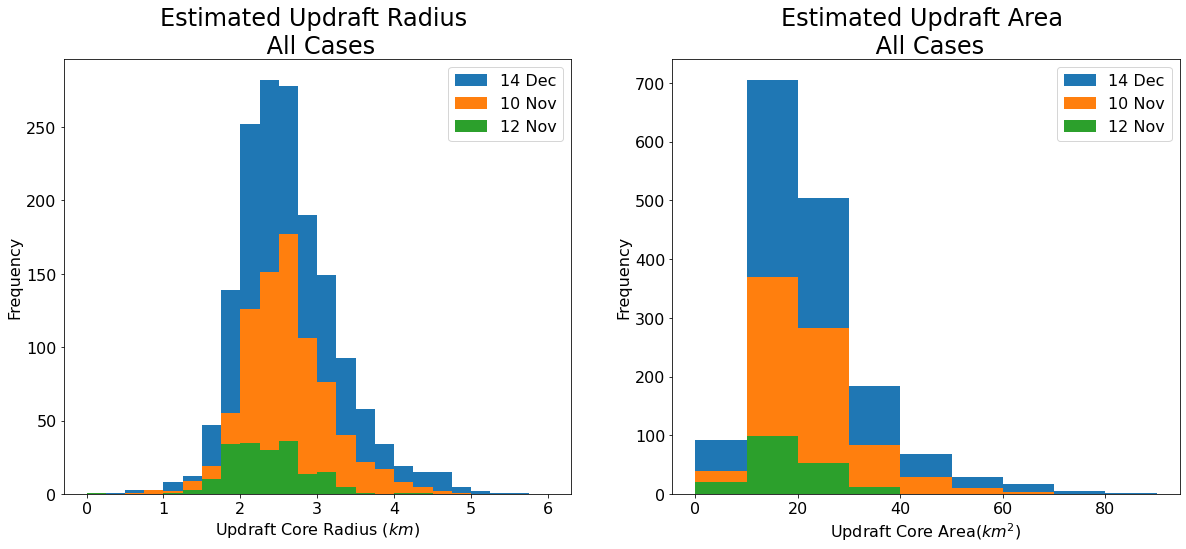
u_core_bins = np.arange(0, 6.25, .25)
ua_bins = np.arange(0, 100, 10)
fig = plt.figure(figsize=(20,8))
ax = plt.subplot(121)
ax.hist(calc_r(dec_14_mean.area_polygon), u_core_bins, label='14 Dec')
ax.hist(calc_r(nov_10_mean.area_polygon), u_core_bins, label='10 Nov')
ax.hist(calc_r(nov_12_mean.area_polygon), u_core_bins, label='12 Nov')
plt.title('Estimated Mean Updraft Radius \n All Cases', fontsize=24)
plt.xlabel('Updraft Core Radius ($km$)', fontsize=16)
plt.ylabel('Frequency', fontsize=16)
plt.xticks(fontsize=16)
plt.yticks(fontsize=16)
plt.legend(loc='upper right', fontsize=16)
ax2 = plt.subplot(122)
#plt.hist(df_max.area_polygon * 0.4032)
ax2.hist(dec_14_mean.area_polygon * 0.4032, ua_bins, label='14 Dec')
ax2.hist(nov_10_mean.area_polygon * 0.4032, ua_bins, label='10 Nov')
ax2.hist(nov_12_mean.area_polygon * 0.4032, ua_bins, label='12 Nov')
plt.title('Estimated Mean Updraft Area \n All Cases', fontsize=24)
plt.xlabel('Updraft Core Area($km^2$)', fontsize=16)
plt.ylabel('Frequency', fontsize=16)
plt.xticks(fontsize=16)
plt.yticks(fontsize=16)
plt.legend(loc='upper right', fontsize=16)
plt.savefig('Updraft_Radius_Area_mean.png', dpi=400)
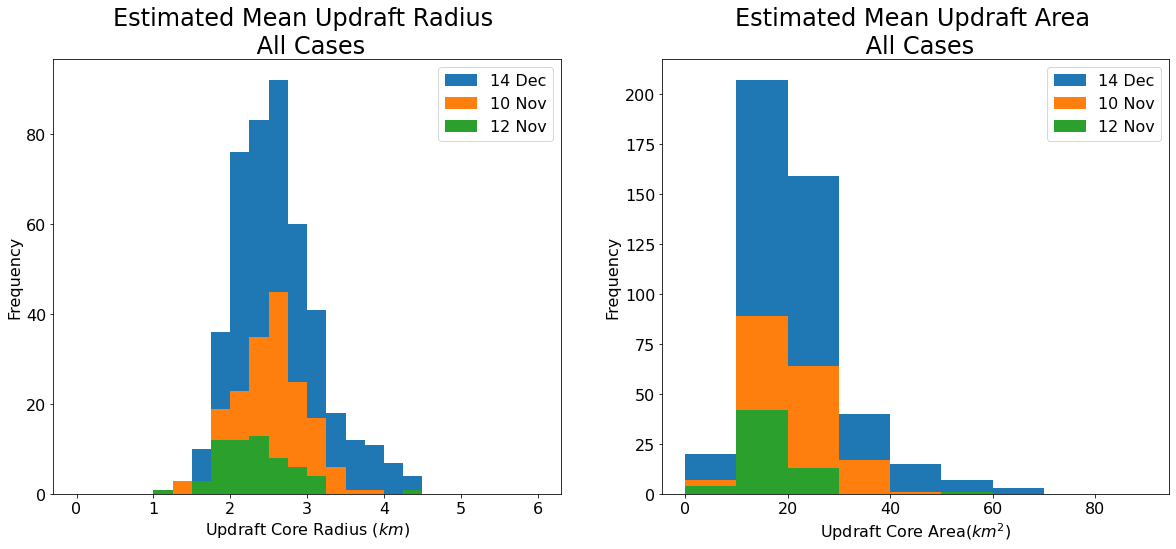
u_core_bins = np.arange(0, 6.25, .25)
ua_bins = np.arange(0, 100, 10)
fig = plt.figure(figsize=(20,8))
ax = plt.subplot(121)
ax.hist(calc_r(dec_14_max.area_polygon), u_core_bins, label='14 Dec')
ax.hist(calc_r(nov_10_max.area_polygon), u_core_bins, label='10 Nov')
ax.hist(calc_r(nov_12_max.area_polygon), u_core_bins, label='12 Nov')
plt.title('Estimated Peak Updraft Radius \n All Cases', fontsize=24)
plt.xlabel('Updraft Core Radius ($km$)', fontsize=16)
plt.ylabel('Frequency', fontsize=16)
plt.xticks(fontsize=16)
plt.yticks(fontsize=16)
plt.legend(loc='upper right', fontsize=16)
ax2 = plt.subplot(122)
#plt.hist(df_max.area_polygon * 0.4032)
ax2.hist(dec_14_max.area_polygon * 0.4032, ua_bins, label='14 Dec')
ax2.hist(nov_10_max.area_polygon * 0.4032, ua_bins, label='10 Nov')
ax2.hist(nov_12_max.area_polygon * 0.4032, ua_bins, label='12 Nov')
plt.title('Estimated Peak Updraft Area \n All Cases', fontsize=24)
plt.xlabel('Updraft Core Area($km^2$)', fontsize=16)
plt.ylabel('Frequency', fontsize=16)
plt.xticks(fontsize=16)
plt.yticks(fontsize=16)
plt.legend(loc='upper right', fontsize=16)
plt.savefig('Updraft_Radius_Area_max.png', dpi=400)
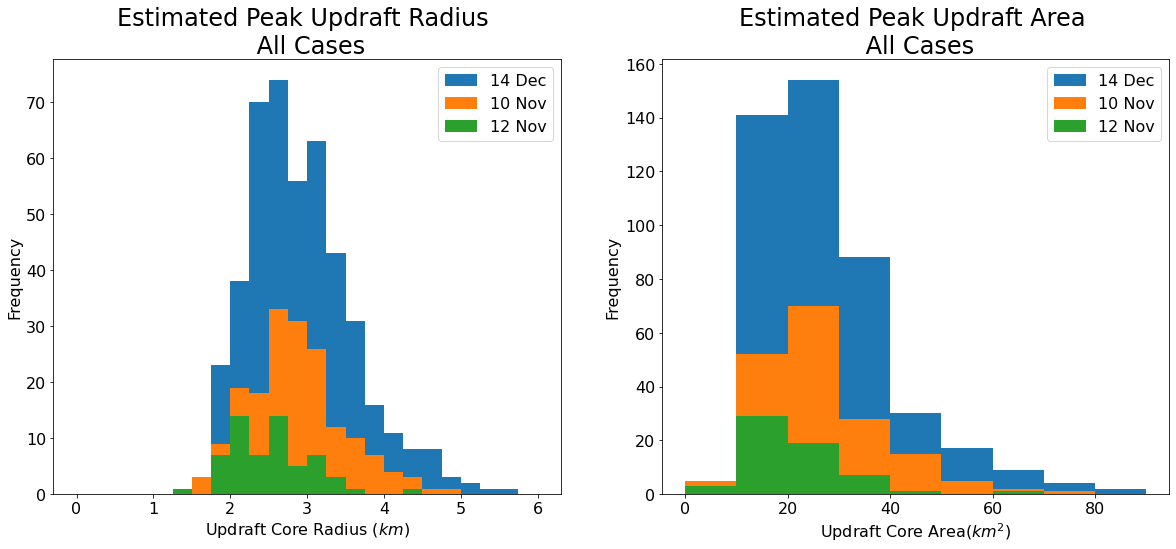
u_core_bins = np.arange(0, 6.25, .25)
ua_bins = np.arange(0, 90, 10)
fig = plt.figure(figsize=(20,8))
ax = plt.subplot(121)
ax.hist(calc_r(dec_14.area_polygon, u_core_bins, label='14 Dec')
ax.hist(nov_10.area_polygon, u_core_bins, label='10 Nov')
ax.hist(nov_12.area_polygon, u_core_bins, label='12 Nov')
plt.title('OT Radius \n All Cases', fontsize=24)
plt.xlabel('OT Radius ($km$)', fontsize=16)
plt.ylabel('Frequency', fontsize=16)
plt.xticks(fontsize=16)
plt.yticks(fontsize=16)
plt.legend(loc='upper right', fontsize=16)
ax2 = plt.subplot(122)
#plt.hist(df_max.area_polygon * 0.4032)
ax2.hist(dec_14.area_polygon, ua_bins, label='14 Dec')
ax2.hist(nov_10.area_polygon, ua_bins, label='10 Nov')
ax2.hist(nov_12.area_polygon, ua_bins, label='12 Nov')
plt.title('OT Area \n All Cases', fontsize=24)
plt.xlabel('OTA ($km^2$)', fontsize=16)
plt.ylabel('Frequency', fontsize=16)
plt.xticks(fontsize=16)
plt.yticks(fontsize=16)
plt.legend(loc='upper right', fontsize=16)
plt.savefig('OT_r_OTA_Duration.png', dpi=400)
cell
963 1.841556
971 1.036429
974 1.212000
975 1.747834
977 1.369286
...
1937 0.566249
1940 0.558000
1941 1.128167
1946 1.026000
1949 0.437749
Name: ot_depth, Length: 257, dtype: float64
fig = plt.figure(figsize=(20,8))
ax = plt.subplot(121)
ax.hist(dec_14.duration, dur_bins, label='14 Dec')
ax.hist(nov_10.duration, dur_bins, label='10 Nov')
ax.hist(nov_12.duration, dur_bins, label='12 Nov')
plt.title('OT Duration \n All Cases', fontsize=24)
plt.xlabel('Duration ($min$)', fontsize=16)
plt.ylabel('Frequency', fontsize=16)
plt.xticks(fontsize=16)
plt.yticks(fontsize=16)
plt.legend(loc='upper right', fontsize=16)
ax2 = plt.subplot(122)
#plt.hist(df_max.area_polygon * 0.4032)
ax2.hist(dec_14.ot_depth, otd_bins, label='14 Dec')
ax2.hist(nov_10.ot_depth, otd_bins, label='10 Nov')
ax2.hist(nov_12.ot_depth, otd_bins, label='12 Nov')
plt.title('OT Depth \n All Cases', fontsize=24)
plt.xlabel('OT Depth ($km$)', fontsize=16)
plt.ylabel('Frequency', fontsize=16)
plt.xticks(fontsize=16)
plt.yticks(fontsize=16)
plt.legend(loc='upper right', fontsize=16)
plt.savefig('OT_Duration_OT_Depth.png', dpi=400)
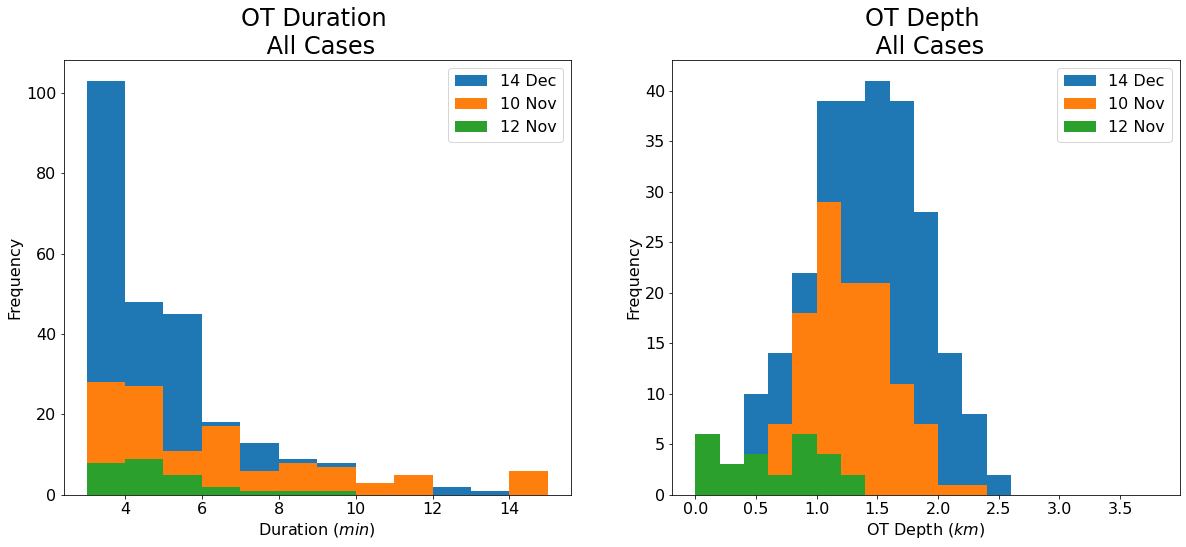
fig = plt.figure(figsize=(20,8))
ax = plt.subplot(121)
ax.hist(calc_r(df_max.area_polygon), u_core_bins, label='14 Dec')
plt.title('Estimated Updraft Radius \n All Cases', fontsize=24)
plt.xlabel('Updraft Core Radius ($km$)', fontsize=16)
plt.ylabel('Frequency', fontsize=16)
plt.xticks(fontsize=16)
plt.yticks(fontsize=16)
ax2 = plt.subplot(122)
#plt.hist(df_max.area_polygon * 0.4032)
ax2.hist(df_max.area_polygon * 0.4032, label='14 Dec')
plt.title('Estimated Updraft Area \n All Cases', fontsize=24)
plt.xlabel('Updraft Core Area($km^2$)', fontsize=16)
plt.ylabel('Frequency', fontsize=16)
plt.xticks(fontsize=16)
plt.yticks(fontsize=16)
plt.savefig('Updraft_Radius_Duration_all.png', dpi=400)
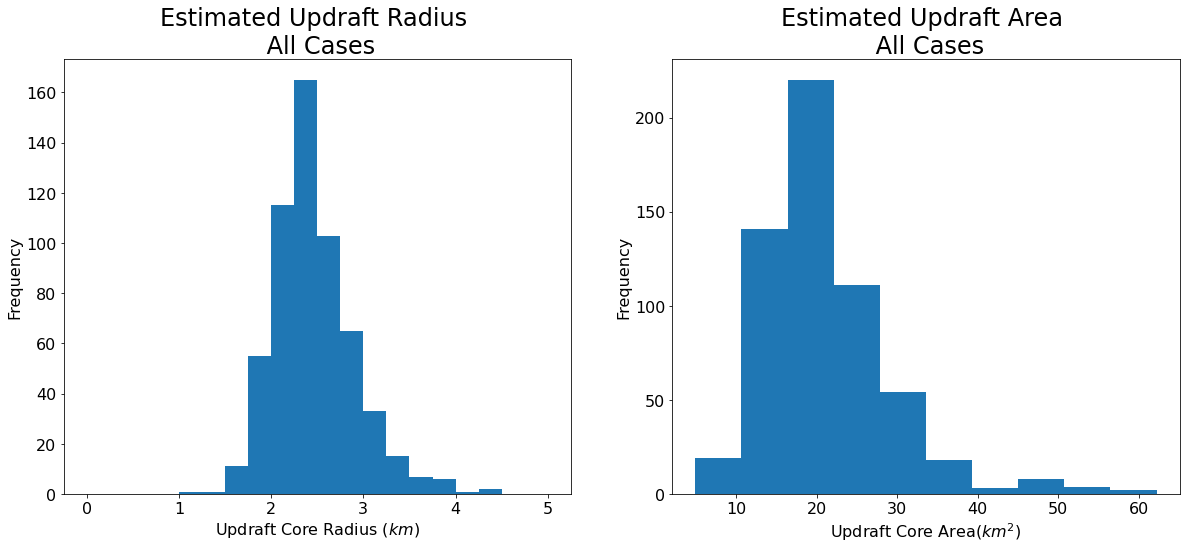
fig = plt.figure(figsize=(12,8))
plt.hist(max_depth, bins=otd_bins)
plt.title('OT Depth Distribution \n 14 November 2018 0000 - 0635 UTC', fontsize=24)
plt.xlabel('OT Depth (km)', fontsize=16)
plt.ylabel('Frequency', fontsize=16)
Text(0, 0.5, 'Frequency')
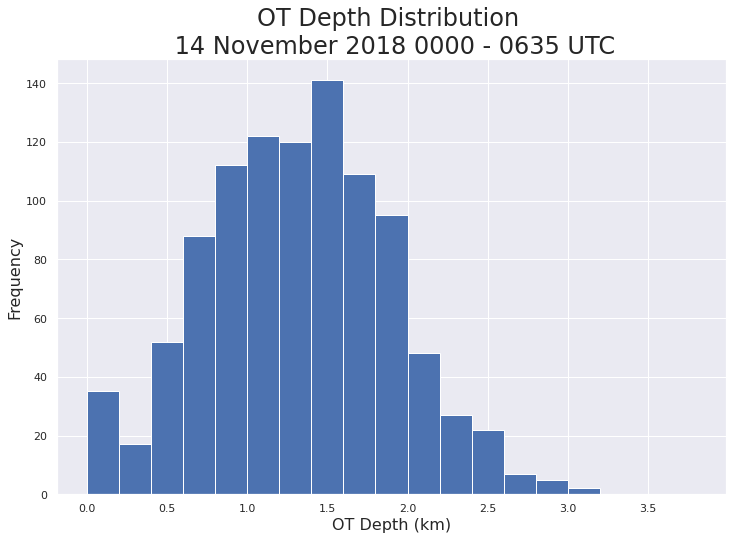
fig = plt.figure(figsize=(12,8))
plt.hist(duration, np.arange(2,20, 2))
plt.title('OT Depth Distribution \n 14 November 2018 0000 - 0635 UTC', fontsize=24)
plt.xlabel('OT Depth (km)', fontsize=16)
plt.ylabel('Frequency', fontsize=16)
Text(0, 0.5, 'Frequency')
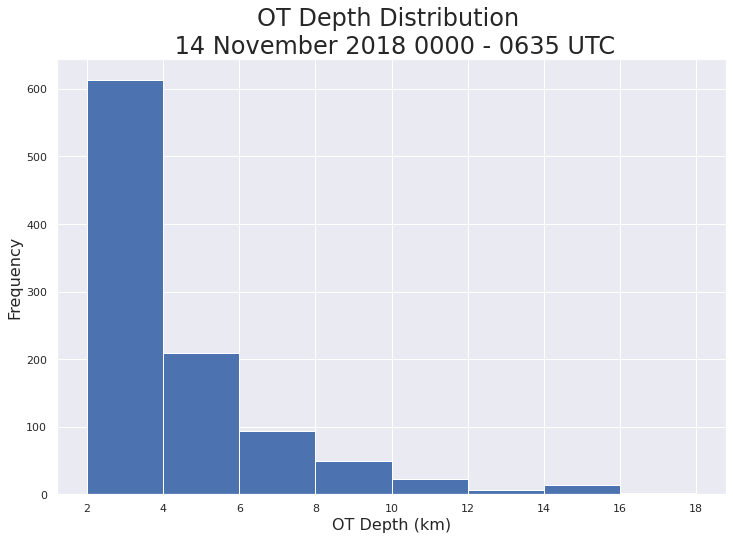
df = pd.DataFrame({'duration':duration,
'max_ota':max_otarea,
'mean_ota':mean_otarea})
df['round_ota'] = np.around(df.max_ota,-1)
df.boxplot('round_ota')
<AxesSubplot:>

len(duration[np.where(duration > 2)])
939
import cartopy.feature as cfeature
fig = plt.figure(figsize=(12,8))
ax = plt.subplot(111, projection=ccrs.PlateCarree())
ax.add_feature(cfeature.OCEAN)
ax.add_feature(cfeature.LAND)
ax.add_feature(cfeature.BORDERS, linestyle=':')
<cartopy.mpl.feature_artist.FeatureArtist at 0x2b80a64b0f60>
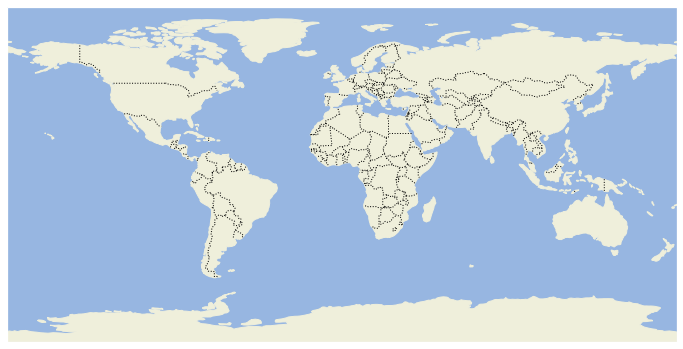
cells_grouped = trajectories_filtered.groupby('cell')
duration = cells_grouped.count().area_polygon.values
max_otarea = cells_grouped.max().area_polygon.values
mean_otarea = cells_grouped.mean().area_polygon.values
slope, intercept, r, p, stderr = scipy.stats.linregress(duration, max_otarea)
line = f'Regression line: y={intercept:.2f}+{slope:.2f}x, r={r:.2f}'
plt.figure(figsize=(10,8))
ax = plt.subplot(111)
ax.scatter(duration, max_otarea)
ax.plot(np.array(duration), intercept + slope * np.array(duration), label=line, color='black')
plt.ylabel('OT Area ($km^{2}$)', fontsize=12)
plt.xlabel('OT Duration (minutes)', fontsize=12)
plt.legend(loc='upper right', fontsize=12)
plt.title('OT Duration All OTs \n 10 November, 12 November, 14 December 2018 UTC (Count = 5967)', fontsize=16)
llcrnr=[-33.206342, -65.906586]
urcrnr=[-30.255825, -62.630553]
# Set extent of maps created in the following cells:
axis_extent=[llcrnr[1],urcrnr[1],llcrnr[0],urcrnr[0]]
# Plot map with all individual tracks:
import cartopy.crs as ccrs
fig_map,ax_map=plt.subplots(figsize=(15,15),subplot_kw={'projection': ccrs.PlateCarree()})
ax_map.coastlines()
ax_map.set_extent(axis_extent)
for ds in ds_list:
# cm = ax.contourf(ds.x.values[::5], ds.y.values[::5], ds.values[::5,::5], levs, cmap='terrain', transform=ccrs.PlateCarree())
cm = ax_map.imshow(ds.values, extent =[ds.x.min(),ds.x.max(),ds.y.min(),ds.y.max()], transform=ccrs.PlateCarree(), vmin=0, vmax=4000, cmap='terrain')
gl = ax_map.gridlines(crs=ccrs.PlateCarree(), draw_labels=True,
linewidth=2, color='gray', alpha=0.5, linestyle='--')
for name, group in cells_grouped:
# print(group.x,group.y)
plt.plot(group.lon,group.lat,"-o",markersize=1)
plt.colorbar(cm,label='Elevation (m)',shrink=0.6, pad=0.1)
ax_map.set_title('Overshooting top tracks\n All Cases')
Text(0.5, 1.0, 'Overshooting top tracks\n All Cases')
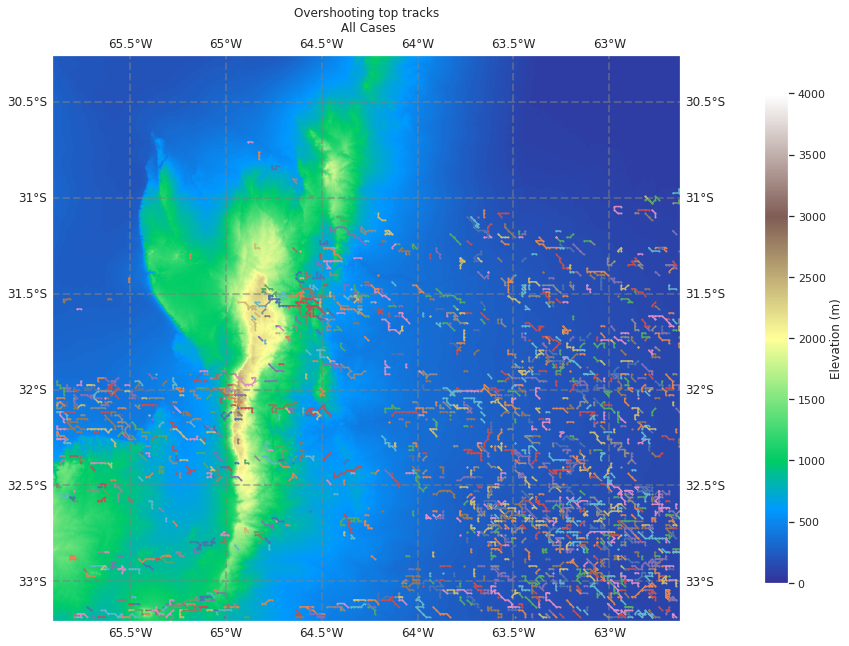
llcrnr=[-33.206342, -65.906586]
urcrnr=[-30.255825, -62.630553]
# Set extent of maps created in the following cells:
axis_extent=[llcrnr[1],urcrnr[1],llcrnr[0],urcrnr[0]]
# Plot map with all individual tracks:
import cartopy.crs as ccrs
fig_map,ax_map=plt.subplots(figsize=(15,15),subplot_kw={'projection': ccrs.PlateCarree()})
ax_map.coastlines()
ax_map.set_extent(axis_extent)
for ds in ds_list:
# cm = ax.contourf(ds.x.values[::5], ds.y.values[::5], ds.values[::5,::5], levs, cmap='terrain', transform=ccrs.PlateCarree())
cm = ax_map.imshow(ds.values, extent =[ds.x.min(),ds.x.max(),ds.y.min(),ds.y.max()], transform=ccrs.PlateCarree(), vmin=0, vmax=4000, cmap='terrain')
gl = ax_map.gridlines(crs=ccrs.PlateCarree(), draw_labels=True,
linewidth=2, color='gray', alpha=0.5, linestyle='--')
for name, group in cells_grouped:
# print(group.x,group.y)
cm2 = plt.scatter(group.lon,group.lat,c=group.area_polygon,vmin=0.,vmax=200.,s=group.area_polygon,
facecolors='none',cmap='magma',linewidth=0.5)
plt.colorbar(cm,label='Elevation (m)',shrink=0.4, pad=0.0)
plt.colorbar(cm2,label='OT Area (km$^2$)',shrink=0.4, pad=0.1)
ax_map.set_title('Overshooting top tracks\n All Cases')
Text(0.5, 1.0, 'Overshooting top tracks\n All Cases')
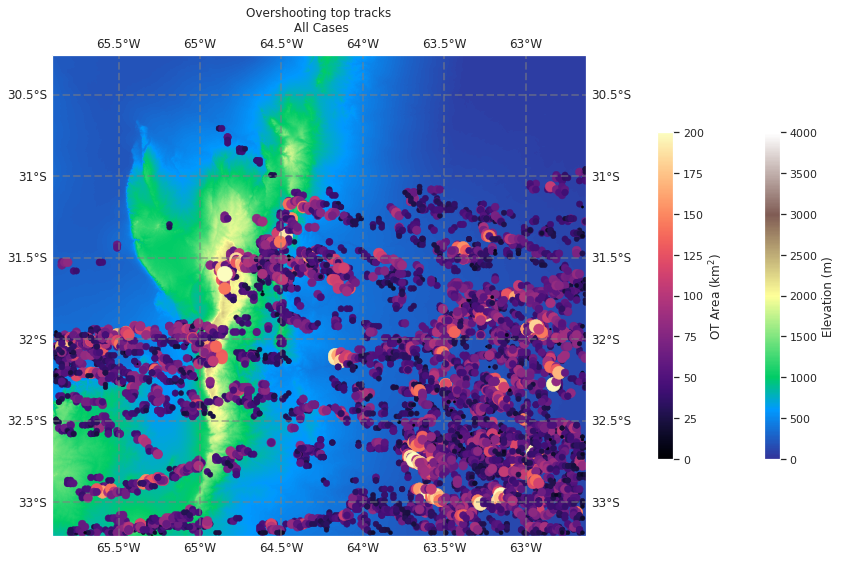
import seaborn as sns
sns.set()
plt.hist(duration)
(array([936., 317., 148., 61., 20., 21., 15., 9., 4., 3.]),
array([ 2. , 3.8, 5.6, 7.4, 9.2, 11. , 12.8, 14.6, 16.4, 18.2, 20. ]),
<BarContainer object of 10 artists>)
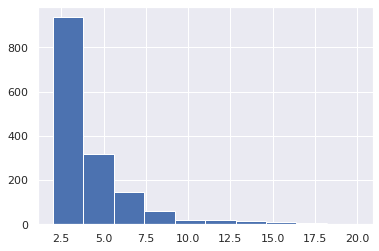
plt.figure(figsize=(10,8))
plt.hist(max_otarea, bins=np.arange(0, 300, 25))
(array([ 48., 524., 517., 279., 85., 43., 21., 13., 2., 2., 0.]),
array([ 0, 25, 50, 75, 100, 125, 150, 175, 200, 225, 250, 275]),
<BarContainer object of 11 artists>)

df_track= pd.read_csv('test.csv')
v_max=60.
stubs=2
order=1
extrapolate=1
memory=1
adaptive_stop=0.01
adaptive_step=0.99
subnetwork_size=100
method_linking= 'predict'
cell_number_start=1
dt = 60.
dxy = 2000.
search_range=dt*v_max
features_linking=deepcopy(df_track)
pred = tp.predict.NearestVelocityPredict(span=1)
trajectories_unfiltered = pred.link_df(features_linking, search_range=search_range, memory=memory,
pos_columns=['x','y'],
t_column='frame',
neighbor_strategy='KDTree', link_strategy='auto',
adaptive_step=adaptive_step,adaptive_stop=adaptive_stop
# copy_features=False, diagnostics=False,
# hash_size=None, box_size=None, verify_integrity=True,
# retain_index=False
)
trajectories_unfiltered['cell']=None
for i_particle,particle in enumerate(pd.Series.unique(trajectories_unfiltered['particle'])):
cell=int(i_particle+cell_number_start)
trajectories_unfiltered.loc[trajectories_unfiltered['particle']==particle,'cell']=cell
trajectories_unfiltered.drop(columns=['particle'],inplace=True)
trajectories_bycell=trajectories_unfiltered.groupby('cell')
num_stubs = 0
for cell,trajectories_cell in trajectories_bycell:
# logging.debug("cell: "+str(cell))
# logging.debug("feature: "+str(trajectories_cell['feature'].values))
# logging.debug("trajectories_cell.shape[0]: "+ str(trajectories_cell.shape[0]))
if trajectories_cell.shape[0] < stubs:
# print("cell" + str(cell)+ " is a stub ("+str(trajectories_cell.shape[0])+ "), setting cell number to Nan..")
trajectories_unfiltered.loc[trajectories_unfiltered['cell']==cell,'cell']=np.nan
num_stubs = num_stubs + 1
print('found this many stubs: {}'.format(num_stubs))
trajectories_filtered=trajectories_unfiltered.dropna()
Frame 15780: 1 trajectories present.
found this many stubs: 183
def test_prob(df, prob_thresh=.7, min_duration=2, max_prob_thresh=.7):
test = df[df.prob > prob_thresh]
cells_grouped = test.groupby('cell')
max_vals = cells_grouped.max()
duration = cells_grouped.count().area_polygon.values
print(duration)
max_prob_thresh = .7
max_vals = max_vals[duration > min_duration]
max_otarea = max_vals.area_polygon.values
duration = duration[duration > min_duration]
print(max_otarea)
#mean_otarea = cells_grouped.mean()[duration > min_duration].area_polygon.values
max_prob = max_vals.prob.values
slope, intercept, r, p, stderr = scipy.stats.linregress(duration, max_otarea)
line = f'Regression line: y={intercept:.2f}+{slope:.2f}x, r={r:.2f}'
plt.figure(figsize=(10,8))
ax = plt.subplot(111)
s = ax.scatter(duration, max_otarea, s=50, c=max_prob, cmap='viridis_r')
plt.colorbar(s, label='Max OT Probability')
ax.plot(np.array(duration), intercept + slope * np.array(duration), label=line, color='black')
plt.ylabel('OT Area ($km^{2}$)', fontsize=12)
plt.xlabel('OT Duration (minutes)', fontsize=12)
plt.legend(loc='upper right', fontsize=12)
plt.title(f'OT Duration 14 December 2018 Prob Thresh: {prob_thresh} \n 1500 - 2359 UTC (Count = {len(max_prob)})', fontsize=16)
plt.show()
plt.close()
trajectories_filtered.groupby('cell')[trajectories_filtered.groupby('cell').count().area_polygon.values > 2]
---------------------------------------------------------------------------
KeyError Traceback (most recent call last)
<ipython-input-183-716a39b269b3> in <module>
----> 1 trajectories_filtered.groupby('cell')[trajectories_filtered.groupby('cell').count().area_polygon.values > 2]
~/a/miniconda3/envs/xesmf_env/lib/python3.7/site-packages/pandas/core/groupby/generic.py in __getitem__(self, key)
1648 stacklevel=2,
1649 )
-> 1650 return super().__getitem__(key)
1651
1652 def _gotitem(self, key, ndim: int, subset=None):
~/a/miniconda3/envs/xesmf_env/lib/python3.7/site-packages/pandas/core/base.py in __getitem__(self, key)
216 if len(self.obj.columns.intersection(key)) != len(key):
217 bad_keys = list(set(key).difference(self.obj.columns))
--> 218 raise KeyError(f"Columns not found: {str(bad_keys)[1:-1]}")
219 return self._gotitem(list(key), ndim=2)
220
KeyError: 'Columns not found: False, True'
duration = cells_grouped.count().area_polygon.values
test_prob(trajectories_filtered, .7, 2)
[ 5 2 2 2 4 2 4 5 3 2 4 3 7 5 2 2 3 2 4 9 8 2 3 4
3 3 2 4 3 2 4 4 6 4 2 2 4 2 2 2 3 2 6 3 3 2 7 6
4 4 11 12 2 9 3 11 2 7 7 3 2 2 3 3 2 4 3 2 2 3 5 6
2 10 5 5 5 3 2 5 2 2 2 3 3 2 3 4 3 7 3 5 5 2 3 2
7 6 5 2 3 4 2 2 2 8 3 5 6 7 4 2 7 2 2 6 4 2 2 6
5 3 2 5 2 2 2 3 4 4 3 3 5 2 5 5 6 2 2 3 2 2 4 2
3 3 3 7]
[ 53.04495093 74.95417576 37.22169946 36.22672045 50.61187799
51.4434505 49.73851352 41.60106836 47.97494253 99.33966763
37.05978449 62.73190927 37.34097974 98.73006191 54.95093377
33.80301911 49.73551538 57.66338334 43.04843349 43.15796459
61.58380279 47.34810358 56.40235019 35.98703749 71.76936767
42.77964004 89.923258 26.88437875 42.40980711 53.30652372
40.19559012 40.76121201 82.6356979 91.5173871 74.16442957
27.1494529 91.64322272 49.21365175 55.84471987 63.73875001
74.47165467 59.17907651 60.09637166 36.07194206 24.86860699
153.22103771 79.01694039 52.0826308 50.69875666 80.15188931
83.39018604 30.00008876 104.97386916 58.59652657 71.26936123
34.65932185 58.80201834 61.68727596 67.29776296 62.69034573
32.38741432 53.64826974 60.13650522 71.03616092 55.35387262
76.03060243 86.04511828 47.63491399 143.8508524 32.68053654
40.69231687 47.10273251 42.0614839 47.21424162 46.02778155
55.44185684 39.57863298 31.61586932 72.69550589 45.24590701
63.69588757 77.32296219 74.92618988 63.31117279 70.31960889
80.26527122 37.88331172 36.65335523 33.02236218 49.23137937
65.83118773 35.85408394 39.86269417 79.42777577 38.38252911
68.43706303]
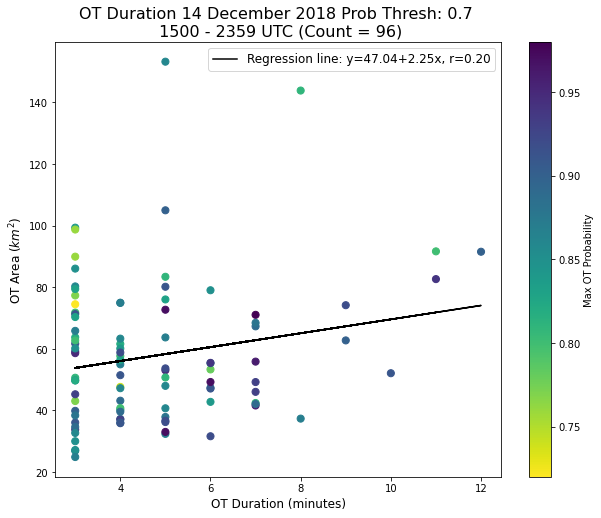
cells_grouped = test.groupby('cell')
duration = cells_grouped.count().area_polygon.values
max_otarea = cells_grouped.max().area_polygon.values
mean_otarea = cells_grouped.mean().area_polygon.values
slope, intercept, r, p, stderr = scipy.stats.linregress(duration, max_otarea)
line = f'Regression line: y={intercept:.2f}+{slope:.2f}x, r={r:.2f}'
plt.figure(figsize=(10,8))
ax = plt.subplot(111)
ax.scatter(duration, max_otarea)
ax.plot(np.array(duration), intercept + slope * np.array(duration), label=line, color='black')
plt.ylabel('OT Area ($km^{2}$)', fontsize=12)
plt.xlabel('OT Duration (minutes)', fontsize=12)
plt.legend(loc='upper right', fontsize=12)
plt.title('OT Duration 14 December 2018 \n 1500 - 2359 UTC (Count = 2353)', fontsize=16)
Text(0.5, 1.0, 'OT Duration 14 December 2018 \n 1500 - 2359 UTC (Count = 2353)')
